

The Perfect 2 to 3 Days in Marseille Itinerary
Last Updated on February 1, 2024
by Audrey Webster
Disclaimer: This article contains affiliate links. That means if you click a link and make a purchase, we may make a small commission. As an Amazon Associate we earn from qualifying purchases. For more information, see our privacy policy.

The ideal Marseille itinerary is a blend of relaxing beaches and beautiful landmarks. Luckily, you can see much of the southern French city and spend some time lounging at one of the many nearby beaches in 2 or 3 days in Marseille.
As one of the primary cities along the southern French coastline (alongside cities like Nice and Montpellier ), you can expect to experience sunshine, crystal blue waters, white beaches, and tasty seafood.
Table of Contents
How Many Days in Marseille?
If you’re wondering how many days to spend in Marseille, note that the city can be used as a home base for exploring much of what southern France has to offer. It’s centrally located with a relatively large train station and has many conveniences that make it great for tourists.
With 2 days in Marseille itself, you have plenty of time to explore all the city’s neighborhoods, admire the old port, and taste the delicious seafood scene. Alternatively, you could spend one day in the city and one day doing a day trip.
If you have 3 days, you can easily see the city at your leisure, lounge on the soft beaches, and take a day trip to a nearby town, region, or national park.

Getting To & Around Marseille
Most visitors arrive in Marseille by plane or train. The Marseille-Provence Airport is located about 20 minutes northwest of the city and you can hop a shuttle from the airport to downtown for under 10 euros. You can also organise private transfers here.
If Marseille is another stop on your trip to the south of France , it’s easily reachable by high-speed trains. From Paris , the train ride is just over three hours long.
You can also reach Marseille from other French cities such as Lyon , Toulouse , Nice or Cannes . The Marseille-Saint-Charles train station is located near the city center, just about two kilometers from the Old Port. You can browse schedules here.
Marseille is a very walkable city. The entire city was built around the port, and many of the main landmarks you’ll visit are within walking distance from the port.
If you’re traveling a further distance so walking isn’t practical, rideshare services, taxis, and buses are at your disposal. Local buses stop at the major beaches and towns in and around Marseille. You can purchase a City Pass for 24, 48, or 72 hours that grants you discounted access to local transportation and city museums.
It’s well worth your time to spend an afternoon wandering the neighborhoods of Marseille. Admire the architecture, colors, narrow streets, and history that exists throughout the city. When exploring on foot, you’re far more likely to stumble upon those hidden gems and cool attractions that make Marseille unique.

2 to 3-Day in Marseille Itinerary
Regardless of whether you have 2 or 3 days in Marseille, take these recommendations to guide your itinerary.
Day 1 – Palais Longchamp & the Vieux-Port
Palais longchamp.
Palais Longchamp is a stunning slice of Marseille that you won’t want to miss. The site was inaugurated in 1868 and local artists were commissioned to build impressive sculptures to decorate the palace.
What stands today is an exquisite structure with white stone pillars, floral designs, and a pristine pond. There are two museums at Palais Longchamp: the Museum of Fine Arts (Musée des Beaux-Arts) and the Natural History Museum.
The first is full of paintings and sculptures from the 17th and 18th century. It was founded in 1801, making it the oldest museum in Marseille. The Natural History Museum showcases fascinating displays of the natural world around Marseille dating back to the 18th century.
The palace is a relaxing way to begin your time in Marseille.
Cathedrale La Major
Continue kicking off your Marseille itinerary by appreciating the magnificent historical landmarks with the Cathedrale La Major.
This Roman Catholic cathedral sits firmly in the center of town. It’s bound to catch your eye with its grey and white striped exterior and stark contrast against the modern builds surrounding it. This was the only cathedral that was built in Marseille during the 19th century.
It was placed near the port as a sign of Marseille’s power to ships arriving in the city. In the years since, the cathedral has become an emblem of Marseille, seeing thousands of tourists and locals every year.
Another attraction located nearby, consider visiting the Centre de la Vieille Charité – the Old Charity Center – which is a museum today but once served as a home to 17th-century beggars.

Fort Saint-Jean
Originally constructed to protect the Old Port, Fort Saint-Jean is still a site visitors enjoy exploring. It was the starting point for troops aiming to reach the Holy Land during the 12th-century Crusades, making it one of the oldest structures in Marseille.
It was completed in 1365, but kings continued to embellish the fort through the mid-17th century. Not only is Fort Saint-Jean a bit of local history, it also provides some great views of the city.
It pokes out into the water, connected to the shore with two footbridges. From the top of the monument, you’ll get a panoramic view of the Old Port and bay of Marseille.
Museum of Civilizations of Europe and the Mediterranean
History buffs will delight in visiting the MUCEM during their time in Marseille. As the first museum ever to dedicate itself to capturing and preserving Mediterranean culture, it’s a must-see while visiting Marseille. It opened in 2013 and has remained a highlight of the city ever since.
On the outside, this boxy, grey, and somewhat strange-looking exterior might not catch your eye. However, on the inside, you’ll find over 350,000 artifacts that make up the permanent and temporary exhibits. You can book skip-the-line tickets here .
At night, the MUCEM glows blue with its lights reflecting on the water.

Wander the Old Port of Marseille
The Old Port of Marseille (Vieux-Port) is the beating heart of the city. The city was built up around the port. Today, it’s surrounded with restaurants, cafes, and shops with landmarks and monuments within a short walk.
At night, the area comes to life with several late-night bars and clubs. During the daytime, make sure you pause here to admire the view and grab a bite from the quayside fish market and enjoy the sites on the Quai du Port (the Grand Quay). If you’re looking for a centrally-located place to stay in Marseille, choose the Old Port.
Eat bouillabaisse
If you’re a seafood lover, you’re in luck. Due to its location right on the coast, Marseille is filled with excellent seafood. No other local dish captures this as well as bouillabaisse. This famous fish stew has whatever the fresh catch of the day is within a hearty, spicy broth.
Chez Fonton is a restaurant known for its bouillabaisse. However, you can find a lot of great places near the Old Port or in the Vallon des Auffes neighborhood. You can also book a food tour to learn more about Marseille’s food scene.
In fact, an excellent way to end your day is to stroll along the beautiful Rue du Vallon des Auffes and enjoy the atmosphere of this historic fishing port. Alternatively, find somewhere with a rooftop terrace to enjoy the views of the sunset over the beautiful Mediterranean.
Day 2 – Dig Deeper in Marseille
Basilique notre-dame de la garde.
Upon arrival in Marseille, it’s impossible to miss the Basilique Notre-Dame de la Garde. Standing tall on a hill overlooking the old port and central part of town, this basilica has become an icon of the city.
It was constructed in 1897 and captures the classic Neo-Byzantine architecture. The interior is a sight to marvel at–towering red and white striped arches, a gold dome ceiling, and intricate art covering the walls. You can also take the time to tour the crypt below the church.
Here is a great place to watch the sunrise or sunset during your trip to Marseille, however, we highly recommend a visit in the morning before visitors arrive for the day.

Château d’If
If you have time in your Marseille itinerary to take a small ferry ride, head over to Château d’If. This small fortress sits upon an island in the Frioul archipelago. It was first built in the 16th century and served as a prison until the end of the 19th century.
For just a few euros, you can head over to the island and wander these highly-fortified grounds that capture a time in history. Today, the fortress is famous for being one of the settings of Alexandre Dumas’s novel The Count of Monte Cristo .
Visiting the Château d’If is undoubtedly one of the top things to do in Marseille and you can book entry tickets here . If you want to spend more time on the water, you can organise a boat trip that includes seeing the Château d’If from the sea, other surrounding islands and picturesque swimming spots.
Palais du Pharo
Heading back to the mainland, the next stop is located in the seaside Pharo neighbourhood in the City of Marseille.
Throughout its history, the Palais du Pharo has been used in a few different ways. It was originally built as a gift from Napoleon III as an imperial residence, although the emperor never stayed in the palace. It was gifted to the city in 1873 after his death.
In the early 1900s, it became the Pharo School where students came from across the globe to practice medicine. The Pharo School remained active until 2013. Today, the building is used for congresses, conventions, and symposiums.
Visitors can wander the grounds, admire the architecture, and take in the beautiful view from a palace seated high above the city. This is absolutely one of the top places to visit in Marseille. And if you want to take in more historic places, consider visiting the nearby Abbey of Saint-Victor.

Admire the street art
Marseille is known for its street art. The further you walk into the neighborhoods surrounding the Old Port, the more this becomes apparent.
Le Panier is the oldest neighborhood in Marseille and has become even more famous among tourists for its impressive display of murals and street art.
You can go on a self-guided tour or sign up with a local tour guide to learn more about the street art and history of the neighborhood.
Borely Park Botanical Garden
If you have some time to spare, Borely Park and its botanical garden have become something of a treasure in Marseille. The park itself is huge, filled with large green spaces, statues, rows of trees, and cobblestone paths.
The botanical garden has more than 3,500 plant species. This is a beautiful place to spend an afternoon relaxing and admiring the colorful flora that thrives in southern France’s climate.
This is a great final activity for a weekend in Marseille, especially if you don’t plan to go to the beach. If you do, however, it’s probably best to skip this particular activity and head to the beach instead!
Walk or lounge on the beach
No visit to a city along the southern French coastline is complete without a trip to the luxurious beaches nearby. The good news is that there are several beaches for you to choose from.
First, and perhaps the most popular, is Plages Escale Borely. Borely is located about two miles south of Marseille and great for visitors who enjoy sailing and windsurfing. Restaurants and cafes line the beach, so you have plenty of access to food and drinks.
Another two options of similar caliber are Plage des Catalans and Plage de la Grande Mer. The former is the easiest to reach from the Marseille city center, however, most of these beaches are accessible via the extensive public transport network.
Parc National des Calanques boasts some of the most exquisite coastline on the Riviera, but we’ll take a closer look at these beaches and activities if you happen to be spending more time than Marseille in 2 days.

Day 3 – Day Trip to Les Calanques, Avignon or the Provence Lavender Fields
Les calanques kayaking.
To see Marseille in 3 days means a visit to Les Calanques. This unique geological area will be unlike anywhere you’ve ever visited before. Bright white cliffs and coves with clear turquoise water make exploring this national park a one-of-a-kind experience.
Calanques National Park sits between Marseille and Cassis. It’s a stretch of coastline filled with mini fjords, white-sand beaches, and crystal-clear water. You can see the coastline through a guided tour , renting a kayak, hiking, or laying on one of the beaches.
Keep an eye out on the habitats underwater during your visit. Through the clear water, you can sometimes see octopuses, anemones, urchins, and a variety of fish and vegetation.
Avignon is a small, quaint town located along the Rhone that will transport you back in time. It’s well-known for the Papal Palace, which is one of the largest buildings in the world. It’s a city loaded with history, art galleries, and traditional French cinemas.
Avignon is only about 35 minutes from Marseille and trains frequently run between the cities. However, plan to spend the entire day enjoying Avignon.
For the best views of this walled city, walk out to the Pont d’Avignon, an unfinished medieval bridge that allows visitors to look back toward the city. You can also book a guided tour that includes a visit to Avignon and a couple of other towns in Provence.
There are several palace museums and local shops to explore, or you can simply wander the streets and enjoy the beauty Avignon has to offer.
Provence lavender fields
You’ve probably seen photos of the Provence lavender fields without realizing where they are located. Your ability to see the lavender fields is highly dependent on when you visit. The flowers begin blooming in June, but reach their peak in mid-July.
Plateau de Valensole is the best place to admire the lavender fields, however, this also means it gets very busy during the summer.
If you want to avoid the crowds, choose another plateau like Luberon or Verdon. They will still be busy, but they generally see fewer tourists than Valensole. The drive from Marseille is just over one hour.
Trains are available, but the trail time is upwards of two hours, with a train transfer near Valensole. You will want to book a guided tour or rent a vehicle to drive the road that takes visitors deep into the rolling lavender hills.

Where to Stay in Marseille
Hôtel Life Marseille VP – This 3-star hotel is the perfect place to base yourself if you’re visiting Marseille on a mid-range budget. It’s centrally located close to the top sites in the city and they have a number of bright, clean and comfortable rooms available.
La Residence Du Vieux Port – Luxury travelers to Marseille will love this boutique hotel in the center of the city. They have a range of sophisticated rooms to choose from, plenty of amenities for guests to enjoy and a location perfect for exploring the city.
Vertigo Vieux-Port – If you’re traveling solo or on a budget, then this hostel is an excellent choice for you. Located in the heart of Marseille, they have a range of both dorms and private rooms available along with great common areas and self-catering facilities.
Not quite what you’re looking for? Click here to browse more Marseille hotels!
Marseille is a lovely slice of southern France. On its own, the city has many highlights with a little something for every kind of traveler to enjoy. Because of its location and size, it can also be a great jumping off point for exploring the French Riviera , Provence, and more.
Are you planning a trip to Marseille? Have any questions about this itinerary? Let us know in the comments!

Related Posts:

Nice or St Tropez: Which French City to Visit?

10 Best Places to Stay in the French Riviera

The Perfect 2 to 3 Days in the Loire Valley Itinerary

About Audrey Webster
Audrey Webster is a writer for The World Was Here First. She is an Oregon native who has visited countries across the globe and currently spends her weekends exploring the Pacific Northwest and surrounding states. Her approach to traveling combines exploring famous tourist sites and wandering off the beaten path to discover new destinations.
Leave a Comment Cancel reply
Winter is here! Check out the winter wonderlands at these 5 amazing winter destinations in Montana
- Travel Destinations
Traveling To Marseille? Here Are 20 Things To Know Before You Go
Published: November 3, 2023
Modified: December 28, 2023
by Camel Omalley
- Plan Your Trip
- Travel Guide
- Travel Tips
Introduction
Marseille, located on the southeastern coast of France, is a vibrant and mesmerizing city that offers a unique blend of old-world charm and modern allure. Known for its rich history, stunning architecture, and diverse cultural heritage, Marseille is a destination that appeals to all types of travelers.
As the second-largest city in France, Marseille boasts a bustling atmosphere, a thriving art scene, and a culinary landscape that will tantalize your taste buds. Whether you’re strolling along the picturesque Old Port, exploring ancient ruins, or indulging in mouthwatering French cuisine, Marseille is a city that never fails to captivate its visitors.
In this article, we will provide you with 20 essential things to know before you embark on your Marseille adventure. From practical information about transportation, accommodations, and safety, to insider tips on local attractions, hidden gems, and cultural etiquette, we’ll equip you with everything you need to ensure a memorable and hassle-free trip.
So, whether you’re planning a short weekend getaway or a longer exploration of the city, read on to discover the must-know facts and tips about Marseille, and get ready to immerse yourself in the magic of this vibrant French city.
Location and Overview
Marseille is situated on the Mediterranean coast in the Provence-Alpes-Côte d’Azur region of France. It is the capital of the Bouches-du-Rhône department and enjoys a strategic location that has shaped its history and identity. As a major port city, Marseille has long been a gateway for trade and cultural exchange, resulting in a rich and diverse heritage.
With its picturesque coastline and hilly landscape, Marseille offers breathtaking views of the sea and the iconic Notre-Dame de la Garde, a basilica that stands watch over the city. The Old Port, known as Vieux Port, serves as the heart of Marseille, lined with colorful buildings, bustling seafood markets, and charming cafes.
Marseille is not only a city of historical significance but also a modern metropolis. The city has undergone significant redevelopment in recent years, with contemporary architecture and cultural spaces adding a new dynamic to its urban landscape. This fusion of ancient and modern elements makes Marseille a truly captivating destination.
Marseille enjoys a Mediterranean climate, characterized by mild winters and hot summers. The city experiences a high number of sunny days, which makes it an ideal destination for outdoor activities and beach lovers.
Whether you are interested in exploring historical landmarks, indulging in delectable cuisine, or simply soaking up the vibrant atmosphere of a bustling city, Marseille has something for everyone. So, get ready to embark on a journey through time and be enchanted by the beauty of Marseille.
Best Time to Visit
Marseille boasts a Mediterranean climate, making it an appealing destination throughout the year. However, the best time to visit Marseille depends on your preferences and the activities you plan to indulge in during your trip.
The peak tourist season in Marseille falls between June and August when the weather is warm and sunny, and the city comes alive with festivals and events. This is the perfect time for beach lovers to enjoy the sparkling Mediterranean waters and indulge in various water sports. However, it’s also the busiest time, with larger crowds and higher accommodation prices.
If you prefer milder temperatures and fewer tourists, consider visiting Marseille during the spring (April to May) or fall (September to October). During these seasons, the weather is pleasant, and you can explore the city’s attractions without the overwhelming crowds. Plus, you might even score some great deals on accommodations and flights.
Winter (December to February) in Marseille is relatively mild, with cooler temperatures and occasional rainfall. While the beach may not be the ideal spot during this time, you can still explore the city’s indoor attractions, museums, and art galleries. Additionally, Marseille has a vibrant Christmas market and celebrates various holiday events, adding a festive touch to your visit.
Overall, Marseille is a year-round destination, and the best time to visit depends on your personal preferences. Whether you’re seeking lively beach days, cultural festivals, or quieter exploration, Marseille has something to offer in every season. Plan accordingly, and get ready to experience the beauty and charm of the city in your chosen timeframe.
Language and Communication
The official language of Marseille, and of France as a whole, is French. While visiting Marseille, you will likely encounter locals who speak only French. However, in popular tourist areas and establishments, you may find people who speak English, especially in hotels, restaurants, and tourist information centers.
It is always appreciated to make an effort to communicate in French, even if it’s just basic phrases. Polite greetings like “Bonjour” (Hello) and “Merci” (Thank you) can go a long way in establishing friendly interactions with locals. Learning a few common phrases will not only show respect for the local culture but can also make your travel experience more enjoyable.
If you’re not fluent in French, there are also several translation apps and phrasebooks available to assist you during your stay. These tools can help bridge the language gap and facilitate communication in various situations, such as ordering meals, asking for directions, or purchasing tickets.
Additionally, it’s a good idea to familiarize yourself with the local customs and etiquette. French people typically appreciate politeness and will respond positively if you make an effort to adapt to their social norms. Remember to greet with a handshake or “faire la bise” (cheek-kissing) if appropriate, and always say “s’il vous plaît” (please) and “au revoir” (goodbye) when entering or leaving a place.
Overall, while English can be useful in tourist areas, it’s beneficial to learn a few basic French phrases and understand the local customs to enhance your experience and foster a positive connection with the people of Marseille.
Currency and Money Exchange
The currency used in Marseille, as well as in the rest of France, is the Euro (€). It is recommended to have some cash on hand for small expenses, such as buying snacks from street vendors or using public transportation. Credit cards are widely accepted in most establishments, including hotels, restaurants, and shops. However, it’s always a good idea to carry some cash with you for emergencies or places that may not accept cards.
When it comes to money exchange, Marseille has a plentiful supply of banks and exchange offices where you can convert your currency into Euros. Banks usually offer competitive rates, but they may charge a service fee. Exchange offices, located in tourist areas, may provide more convenient hours of operation, but their rates may be slightly less favorable.
It’s important to note that withdrawing money from ATMs is usually the most convenient and cost-effective way to obtain local currency. ATMs can be found throughout the city, and you can use international debit or credit cards to withdraw cash. However, it’s advisable to inform your bank in advance of your travel plans to avoid any issues with card usage.
It’s also worth mentioning that tipping in Marseille is not compulsory, as it is included in the service charge. However, if you receive exceptional service or want to show appreciation, leaving a small tip is always welcomed. As a general guideline, rounding up the bill or leaving up to 10% of the total amount is considered customary.
Lastly, be cautious of your belongings and ensure the safety of your money. Avoid displaying large sums of cash in public and be vigilant when using ATMs. It’s advisable to keep your money and important documents secure in a money belt or hidden pouch while exploring the city.
By being prepared and informed about currency and money exchange, you can navigate Marseille with ease and enjoy your trip without any financial concerns.
Safety and Security
Marseille is a generally safe city, but like any other urban area, it’s important to remain vigilant and take necessary precautions to ensure a safe and enjoyable trip. Here are some tips to enhance your safety and security while in Marseille:
- Stay aware of your surroundings, especially in crowded tourist areas and public transportation hubs.
- Avoid displaying valuable items and keep your belongings secure, especially in crowded places.
- Be cautious of pickpockets and keep your purse or wallet close to your body.
- Use well-lit and busy streets when walking at night, and consider traveling in groups if possible.
- Follow local regulations and instructions, particularly related to public health and safety.
- Keep a photocopy of your passport and important documents in a safe place, separate from the originals.
- Ensure your accommodation has secure locks and use the in-room safe to store your valuables.
- Stay up-to-date on travel advisories and be aware of any potential risks or disturbances in the city.
It’s also a good idea to have emergency contact numbers, including the local police and emergency services, saved in your phone or written down in case of any unforeseen circumstances.
While incidents of violent crime are rare in Marseille, it’s important to exercise caution and use common sense to minimize any potential risks. By staying alert, adhering to safety guidelines, and being aware of your surroundings, you can have a safe and enjoyable experience in Marseille.
Transportation in Marseille
Getting around Marseille is relatively easy, thanks to its well-connected transportation system. Here are some options for navigating the city:
- Public Transportation: Marseille has an efficient public transportation network, including buses, trams, and the metro. The metro is particularly convenient for traveling within the city center, while buses and trams cover a wider area. You can purchase tickets at metro stations, tabacs (tobacco shops), or using the RTM app.
- Bicycle Rental: Marseille offers a bike-sharing system called “Le Vélo.” You can rent a bike for short periods and explore the city on two wheels. Just look for the bike stations located throughout Marseille.
- Taxis and Rideshares: Taxis are available throughout the city, and you can hail them on the street or find them at designated taxi stands. Ride-hailing services like Uber are also available in Marseille, providing a convenient and reliable transportation option.
- Walking: Marseille’s compact city center is best explored on foot, allowing you to soak in the vibrant street life and discover hidden gems. Many popular attractions, such as the Old Port and the Panier neighborhood, are within walking distance of each other.
- Driving: If you plan to rent a car, it’s important to note that driving in Marseille can be challenging, especially in the city center with its narrow streets and limited parking options. However, having a car can be advantageous for exploring places outside the city or for day trips to nearby attractions.
It’s also worth knowing that Marseille is well-connected to other cities in France and Europe through its international airport, Marseille Provence Airport. From the airport, you can easily reach the city center by shuttle buses, trains, or taxis.
Planning your transportation in advance, considering the proximity of attractions, and utilizing a combination of public transportation, walking, and occasional taxis or rideshares can enhance your overall travel experience in Marseille.
Accommodation Options
Marseille offers a wide range of accommodation options to suit every budget and preference. From luxurious hotels to budget-friendly hostels and cozy guesthouses, here are some options to consider when selecting your accommodation in Marseille:
- Hotels: Marseille is home to a variety of hotels, ranging from upscale establishments with stunning sea views to boutique hotels nestled in historic neighborhoods. These hotels offer comfortable amenities, including restaurants, bars, and sometimes even spa facilities.
- Apartments: Renting an apartment is a popular option for those looking for more spacious and independent accommodation. There are several websites and platforms where you can find apartments for short-term rentals in Marseille.
- Hostels: Marseille has a selection of budget-friendly hostels, perfect for solo travelers or those on a tight budget. Hostels offer shared dormitory-style rooms or private rooms, along with common areas where you can socialize with fellow travelers.
- Guesthouses: If you prefer a more intimate and personalized experience, consider staying in a guesthouse. These smaller accommodations offer a homely atmosphere and personalized service, often operated by locals who can provide insider tips and recommendations.
- Bed & Breakfasts: Marseille has charming bed and breakfast establishments where you can enjoy a cozy stay and a hearty breakfast to start your day. These accommodations often showcase the local charm and hospitality.
When choosing your accommodation, factors such as location, amenities, and proximity to attractions should be taken into consideration. The Vieux Port area and the historic Panier neighborhood are popular choices for their central locations and vibrant atmosphere. Additionally, Marseille offers a variety of accommodations near the beach, providing easy access to the sun, sand, and sea.
It’s advisable to book your accommodation in advance, especially during the peak tourist season, to secure the best deals and availability. Online travel platforms and booking websites can help you explore the different options and read reviews from other travelers to make an informed decision.
With a wide range of accommodation choices available, you can find the perfect place to stay in Marseille that suits your preferences and enhances your overall travel experience.
Must-See Attractions
Marseille is a city filled with captivating attractions and landmarks that showcase its rich history and cultural heritage. Here are some must-see attractions to add to your itinerary when visiting Marseille:
- Notre-Dame de la Garde: Perched on a hilltop, this iconic basilica offers panoramic views of Marseille and the Mediterranean Sea. Its stunning architecture and intricate interiors make it a must-visit attraction.
- The Old Port (Vieux Port): This historic harbor is the heart of Marseille, lined with colorful buildings, fishing boats, and lively cafes. Take a stroll along the waterfront and soak in the vibrant atmosphere.
- Le Panier: Marseille’s oldest neighborhood, Le Panier, is known for its narrow streets, charming squares, and vibrant street art. Explore its winding alleys and discover hidden gems, including boutiques, art galleries, and cafes.
- MuCEM: The Museum of European and Mediterranean Civilizations, located on the waterfront, is an architectural masterpiece. It explores the history and cultural diversity of the Mediterranean region through its exhibits and temporary exhibitions.
- Palais Longchamp: This intricate monument boasts beautiful gardens, a majestic fountain, and the Museum of Fine Arts. It offers a serene escape from the bustling city center.
- Château d’If: This famous island fortress, located just off the coast of Marseille, is a must-visit for fans of Alexandre Dumas’ “The Count of Monte Cristo.” Take a ferry to explore the prison cells and enjoy stunning views of Marseille from the island.
- Calanques National Park: Just outside Marseille, this national park offers breathtaking natural beauty. Hike among stunning limestone cliffs, swim in crystal-clear waters, and enjoy the untouched Mediterranean landscape.
- Marseille Cathedral (Cathédrale Sainte-Marie-Majeure de Marseille): This grand cathedral showcases a blend of Romanesque and Gothic architectural styles. Explore its intricate details and climb to the rooftop for panoramic views.
These are just a few highlights of the many attractions Marseille has to offer. Don’t forget to wander through the vibrant street markets, visit museums, and explore the city’s neighborhoods to truly immerse yourself in the vibrant culture and charm of Marseille.
Hidden Gems in Marseille
Marseille is not only famous for its well-known attractions but also hides a treasure trove of hidden gems waiting to be discovered. Here are some lesser-known yet remarkable places to explore during your visit to Marseille:
- Le Vallon des Auffes: This picturesque fishing village tucked away from the city center offers a tranquil escape. Enjoy fresh seafood at waterfront restaurants and take in the charming atmosphere of this hidden gem.
- La Cité Radieuse: Designed by renowned architect Le Corbusier, this iconic residential building is a modernist masterpiece. Explore its unique design and enjoy stunning views from the rooftop terrace.
- The Corniche: Take a scenic drive along the coastal road, known as the Corniche, and enjoy breathtaking views of the sea and Marseille’s stunning coastline.
- Gare de Marseille-Saint-Charles: This historic train station is worth a visit, even if you’re not catching a train. Admire its grand architecture and soak in the vibrant atmosphere of travelers coming and going.
- Vallon des Carmes: Escape the hustle and bustle of the city at this peaceful garden oasis. With lush greenery, a small waterfall, and hidden benches, it’s the perfect spot for a quiet retreat.
- The Panier’s Street Art: The Panier neighborhood is not only known for its historical charm but also for its vibrant street art scene. Take a self-guided tour to discover colorful murals and graffiti adorning the walls of the neighborhood.
- Roucas-Blanc: This neighborhood offers stunning views of the sea and the magnificent Château d’If. Explore its narrow streets and visit the local shops and cafes for a more relaxed and authentic experience.
- Marseille’s Secret Passages: Explore the hidden passages (Passages Couverts) in Marseille, such as the Passage de Lorette or Passage de la Baleine. These covered walkways transport you back in time, with charming shops and cafes tucked away.
Venturing off the beaten path and exploring these hidden gems will provide a deeper insight into the local culture and add an extra layer of enchantment to your Marseille experience.
Beaches in Marseille
Marseille is blessed with a stunning coastline and several beautiful beaches where you can relax, soak up the sun, and cool off in the crystal-clear waters of the Mediterranean Sea. Here are some top beaches in Marseille to visit:
- Plage du Prado: Located in the Prado area, this sandy beach stretches for several kilometers and offers various facilities, including beach clubs, restaurants, and water sports activities.
- Les Catalans Beach: Situated near the Vieux Port, this charming beach is easily accessible and offers a peaceful retreat from the city center. Enjoy its calm waters and stunning views of the Château d’If.
- Plage de la Pointe Rouge: This lively beach is popular amongst both locals and tourists. With its lively promenade, water sports rentals, and beachfront restaurants, it’s an ideal spot for a day of sun and relaxation.
- Plage du David: Nestled between rocky cliffs, this secluded beach offers a tranquil escape. Its clear waters are perfect for swimming and snorkeling, and the surrounding cliffs provide shade during hot summer days.
- Calanque de Sormiou: While technically not a beach, this stunning inlet is a must-visit destination for nature lovers. Accessible by hiking or by boat, it offers crystal-clear water and breathtaking surroundings.
- Plage du Prophète: Located in the Corniche neighborhood, this sandy beach is known for its calm waters and family-friendly atmosphere. It’s equipped with facilities such as showers, lifeguards, and beachside restaurants.
From sandy beaches with lively vibes to hidden coves with pristine waters, Marseille’s beaches offer something for everyone. Whether you’re looking for water sports, sunbathing, or simply enjoying the natural beauty, a visit to one of Marseille’s beaches is a must during your stay.
Outdoor Activities
Marseille, with its stunning natural landscape and Mediterranean climate, provides ample opportunities for outdoor enthusiasts to engage in exciting activities. Here are some outdoor activities to enjoy in Marseille:
- Hiking in the Calanques: Lace up your hiking boots and explore the Calanques National Park, a stunning natural reserve with steep limestone cliffs, hiking trails, and breathtaking views. Choose from various routes, ranging from easy walks to challenging hikes.
- Boat Tours: Embark on a boat tour to discover the beauty of the Mediterranean coastline surrounding Marseille. Take in the sights of the Calanques, visit nearby islands like Frioul and Maïre, or go on a fishing excursion.
- Water Sports: Try your hand at a range of water sports, such as kayaking, paddleboarding, and sailing, along Marseille’s coastline. Explore hidden coves, navigate through the Calanques’ turquoise waters, or simply enjoy the thrill of being on the sea.
- Rock Climbing: Marseille’s rocky cliffs offer incredible opportunities for rock climbing enthusiasts. With varying levels of difficulty and picturesque views, it’s a great way to challenge yourself and experience the thrill of scaling the cliffs.
- Cycling: Rent a bike and explore Marseille’s many cycle paths, including the scenic Corniche Kennedy. Explore the city’s neighborhoods, ride along the coast, or venture into the countryside for a scenic bike ride.
- Snorkeling and Diving: Discover the rich underwater world of the Mediterranean Sea by snorkeling or diving. Marseille offers several diving spots where you can explore colorful marine life, ancient shipwrecks, and underwater caves.
- Picnicking in Parks: Marseille has numerous parks and green spaces where you can enjoy a leisurely picnic. Parc Borély and Parc Longchamp are popular choices, offering serene settings and beautiful landscapes.
Whether you’re seeking adrenaline-pumping adventures or peaceful outdoor experiences, Marseille has it all. Embrace the natural beauty and take advantage of the city’s abundant opportunities for outdoor activities to make your trip truly memorable.
Cultural Festivals and Events
Marseille is known for its vibrant cultural scene, and throughout the year, the city hosts a variety of festivals and events that showcase its rich heritage and diverse cultural traditions. Here are some of the notable cultural festivals and events in Marseille:
- Marseille Jazz Festival: Held in July, this renowned music festival brings together jazz musicians from all over the world for a series of captivating performances. Enjoy live jazz music in various venues across the city.
- Marseille Provence Festival: Celebrated every year, this multidisciplinary arts festival combines music, dance, theater, and visual arts, showcasing the region’s cultural wealth. It takes place at various venues throughout the city.
- La Fête du Panier: This annual festival celebrates the vibrant Panier neighborhood with street performances, live music, local cuisine, and art exhibitions. Experience the lively and artistic atmosphere of this historic and artistic quarter.
- Fête de la Musique: Celebrated on June 21st, this nationwide music festival takes over the streets of Marseille, offering free concerts and performances by local and international artists. Join the locals in celebrating the joy of music.
- Festival International de Marseille: As one of the most important contemporary dance festivals in France, it showcases innovative dance performances and workshops, attracting renowned artists from around the world.
- Marseille Provence Gastronomie: This food festival celebrates the culinary heritage of Marseille and Provence. Enjoy tastings, workshops, and special menus featuring local flavors and ingredients.
- Carnaval de Marseille: Join the colorful and festive celebration of Carnaval de Marseille, where locals and visitors come together for parades, music, costumes, and traditional festivities.
These are just a few examples of the countless cultural festivals and events that take place in Marseille throughout the year. Check the local event calendars and tourist information websites to plan your visit around these vibrant and exciting celebrations, and immerse yourself in the city’s cultural tapestry.
Shopping in Marseille
Marseille offers a diverse shopping scene, from bustling markets to trendy boutiques and department stores. Whether you’re looking for local specialties, fashionable clothing, or unique souvenirs, you’ll find plenty of options to satisfy your shopping desires. Here are some of the best places to shop in Marseille:
- Les Docks Village: This stylish shopping center, located in a beautifully renovated warehouse, is home to a range of fashion boutiques, design stores, and gourmet shops. Enjoy a unique shopping experience in a trendy setting.
- Centre Bourse: Situated in the heart of Marseille, Centre Bourse is a large shopping mall offering a mix of international brands, local boutiques, and a variety of dining options. From clothing and accessories to electronics and cosmetics, you’ll find it all here.
- Le Panier: Explore the charming streets of Le Panier neighborhood, where you’ll find an array of artisan workshops, craft shops, and galleries. This is the perfect place to discover unique handmade items and support local artisans.
- Marché aux Puces de Marseille: If you’re a vintage enthusiast or enjoy hunting for unique treasures, head to this flea market. Browse through a vast collection of antiques, furniture, collectibles, and vintage clothing.
- La Canebière: Marseille’s main thoroughfare, La Canebière, is lined with shops offering a mix of traditional and modern wares. Explore department stores, fashion boutiques, and specialty shops as you stroll down this bustling street.
- Marché de Noailles: Immerse yourself in a vibrant sensory experience at this lively market. From fresh produce and spices to Middle Eastern and North African products, the market offers a diverse array of culinary delights.
- Designer Boutiques on Rue Paradis: For those looking for high-end fashion and luxury brands, Rue Paradis is the place to be. This upscale street is home to renowned designer boutiques and chic stores.
When shopping in Marseille, don’t forget to explore the local food markets as well. Stock up on delicious regional delicacies, such as cheese, olives, and pastries, to bring a taste of Marseille back home with you.
Marseille is a shopper’s paradise, offering a diverse range of shopping experiences to suit every taste and budget. So, grab your shopping bags and get ready to indulge in some retail therapy during your visit to Marseille.
Local Cuisine and Specialties
Marseille is a gastronomic haven, offering a delightful blend of French, Mediterranean, and Provençal flavors. Known for its fresh seafood, vibrant spices, and rich culinary traditions, Marseille’s local cuisine is a true reflection of the city’s diverse cultural influences. Here are some must-try dishes and specialties to savor during your visit:
- Bouillabaisse: This iconic Marseille dish is a fish stew made with various types of fish and shellfish, simmered with herbs, tomatoes, and saffron. Enjoy this hearty and flavorful dish at one of the city’s traditional seafood restaurants.
- Panisse: Panisse is a delicious chickpea flour fritter that is crispy on the outside and tender on the inside. It’s often served as a side dish or appetizer, perfect for accompanying your meal.
- Anchoïade: Anchoïade is a flavorful dip made with anchovies, garlic, olive oil, and herbs. It’s typically served with crudités or bread and makes for a delicious and savory starter.
- Petits Farcis: Petits Farcis are stuffed vegetables, usually zucchini, eggplant, or bell peppers, filled with a mixture of ground meat, breadcrumbs, and herbs. They are baked until tender and make for a delightful main course or side dish.
- Navettes: These boat-shaped cookies are a Marseille specialty, traditionally enjoyed during the Candlemas holiday. They have a mild orange blossom flavor and a delightful crumbly texture.
- Pastis: Pastis is a popular anise-flavored liqueur that is synonymous with Provence. Enjoy it as an aperitif, either mixed with water to create a refreshing drink or simply on the rocks.
- Calissons: These almond-based candies are a beloved sweet treat in Marseille. The combination of ground almonds, candied fruits, and royal icing creates a unique and irresistible flavor.
- Tapenade: Tapenade is a flavorful spread made from olives, capers, anchovies, garlic, and olive oil. It’s typically enjoyed on bread or crackers and is a delicious appetizer or snack option.
While exploring Marseille, be sure to visit the local markets, such as the colorful Marché du Vieux Port, to sample fresh regional produce, cheeses, oils, and other specialty products. Don’t forget to pair your meals with a glass of local wine, such as a crisp Côtes de Provence rosé, to complete your culinary experience in Marseille.
Indulging in Marseille’s local cuisine and specialties is a must to truly appreciate the city’s vibrant gastronomic culture and savor the flavors of the Mediterranean. Bon appétit!
Drinking and Nightlife
Marseille offers a vibrant nightlife scene with a wide range of bars, clubs, and restaurants to suit all tastes. Whether you’re looking to relax with a drink, dance the night away, or enjoy live music, Marseille has something for everyone. Here’s what you need to know about drinking and nightlife in Marseille:
- Bars and Cafés: Marseille is dotted with numerous bars and cafés where you can socialize and indulge in a refreshing drink. From cozy wine bars to trendy cocktail lounges, you’ll find a diverse selection to cater to your preferences.
- Old Port (Vieux Port): The Old Port area is a popular spot for enjoying a drink while soaking in the lively atmosphere. The waterfront is lined with bars and cafés where you can grab a seat on a terrace and watch the world go by.
- Cours Julien: This vibrant neighborhood is known for its artsy and bohemian vibe, with numerous bars and live music venues. It’s an ideal place to enjoy a few drinks, discover local bands, and immerse yourself in Marseille’s alternative scene.
- Live Music: Marseille has a thriving live music scene, offering everything from jazz and blues to rock and electronic music. Check out local listings and venues like Le Silo or Espace Julien for live music performances.
- Nightclubs: Marseille boasts a variety of nightclubs where you can dance the night away to a mix of international and local DJs. Popular areas for nightlife include the Vieux Port district and the Prado area.
- La Plaine: This bustling square comes alive at night, with its outdoor bars and a vibrant atmosphere. It’s a popular gathering spot for locals and visitors alike, offering a lively and energetic nightlife experience.
- Beach Clubs: During the summer months, Marseille’s beaches are transformed into vibrant beach clubs, offering a unique blend of music, cocktails, and a festive atmosphere. Dance on the sand or relax in a beachfront lounge as you enjoy the cool sea breeze.
It’s worth noting that Marseille has a strong café culture, and it’s common to see locals enjoying a coffee or an apéritif in the afternoon or early evening. It’s a great opportunity to soak in the local ambiance and mingle with the locals.
Whether you’re seeking a relaxed evening at a cozy bar or an energetic night out on the dance floor, Marseille’s nightlife scene has something to offer for everyone. So, get ready to enjoy the city’s vibrant atmosphere and experience the joie de vivre of Marseille’s drinking and nightlife scene.
Etiquette and Customs
When visiting Marseille, it’s helpful to familiarize yourself with the local etiquette and customs to ensure a respectful and enjoyable experience. Here are some key points to keep in mind:
- Greetings and Politeness: French people appreciate polite greetings, so it is customary to say “Bonjour” (hello) or “Bonsoir” (good evening) when entering a shop, restaurant, or any public space. Use “Merci” (thank you) and “S’il vous plaît” (please) when interacting with locals.
- Personal Space and Touching: French people value personal space and typically avoid physical contact with strangers. It is best to refrain from hugging, kissing, or touching someone you have just met, unless it is customary, such as the traditional cheek-kissing when greeting friends or acquaintances.
- Dress Code: Marseille has a relatively casual dress code, but it is advisable to dress modestly when visiting religious sites or formal establishments. Keep in mind that beachwear is appropriate only at the beach or poolside.
- Meal Etiquette: Table manners are important in French culture. Keep your hands on the table during the meal but not your elbows. Wait for everyone to be served before starting to eat and keep your wrists on the table, rather than your hands in your lap.
- Tipping: Tipping in Marseille is not mandatory, as a service charge is usually included in the bill. However, it is customary to round up the bill or leave a small tip as a gesture of appreciation for exceptional service. You can leave 5-10% of the total bill amount if you choose to tip.
- Smoking Regulations: France has implemented strict smoking regulations. Smoking is prohibited in enclosed public spaces, including restaurants, bars, and public transportation. Look for designated smoking areas if you wish to smoke.
- Language: While many locals may speak English, it is polite to make an effort to speak a few basic French phrases. Even if your French is limited, attempting to communicate in French is appreciated and shows respect for the local culture.
- Queuing: In Marseille, as in France, queuing is generally respected. Wait your turn in supermarkets, public transport, or at popular attractions. Cutting in line is considered impolite.
By respecting the local customs and showing a genuine interest in Marseille’s culture, you will have a more pleasant and immersive experience, fostering positive interactions with locals and embracing the French way of life.
Tipping Culture
Tipping in Marseille follows a similar practice to the rest of France. While it is not obligatory, leaving a tip is customary when you receive good service. Here are some guidelines to navigate the tipping culture in Marseille:
- Restaurants and Cafés: In restaurants and cafés, a service charge is typically included in the bill, marked as “service compris.” However, it is customary to round up the bill or leave an additional 5-10% as a gesture of appreciation for excellent service.
- Bars: Tipping in bars is not obligatory, but it’s a common practice to leave a small tip, especially if you receive attentive service or fancy a generous pour of your favorite drink.
- Taxis: While it is not customary to tip taxi drivers in Marseille, rounding up the fare or leaving a small amount as a token of appreciation is considered polite.
- Hotels: In upscale hotels, it is customary to tip hotel staff who provide exceptional service, such as bellhops who assist with luggage or housekeeping staff who go above and beyond to ensure your comfort. Leaving 1–2 euros per service is appropriate.
- Tour Guides and Drivers: If you’re on a guided tour, it is customary to tip the tour guide or driver at your discretion, depending on the quality of the service provided. A tip of 5-10% of the tour cost is a fair guideline.
- Other Services: For other services, such as hairdressers, spa treatments, or massage therapists, tipping is discretionary. Leaving 5-10% of the service cost is a generous gesture if you are satisfied with the service.
Ultimately, tipping in Marseille is a way to show appreciation for excellent service and is an individual choice based on your satisfaction and financial means. Regardless of whether or not you tip, a simple “Merci” (thank you) and a smile will always be appreciated by the service providers.
Health and Medical Facilities
Marseille offers a high standard of healthcare services, ensuring that you are well taken care of in case of medical emergencies or health concerns during your visit. Here is important information about health and medical facilities in Marseille:
- European Health Insurance Card (EHIC): If you are a citizen of the European Union, it is recommended to carry the EHIC, which grants you access to necessary healthcare services at the same cost as locals. However, it’s still advisable to obtain travel insurance as the EHIC might not cover all medical expenses.
- Hospitals and Clinics: Marseille has several well-equipped hospitals and medical clinics that provide quality healthcare services. The main hospital is “Assistance Publique – Hopitaux de Marseille” located at 80 Rue Brochier. In case of emergencies, dial the European emergency number 112 or head to the nearest hospital.
- Pharmacies: Pharmacies in Marseille can assist with non-emergency medical issues and provide over-the-counter medications. Look for a green cross sign indicating a pharmacy. Note that some pharmacies may have limited hours on weekends and holidays, so it’s prudent to check beforehand.
- Health Insurance: It is highly recommended for non-European Union citizens to have comprehensive travel insurance that covers medical expenses, including emergency medical treatment, repatriation, and hospitalization.
- Covid-19 Precautions: In light of the ongoing Covid-19 pandemic, it is advisable to stay informed about the local health guidelines and regulations. Follow social distancing measures, wear face masks where required, and comply with hygiene protocols to protect your health and the well-being of others.
If you have any pre-existing medical conditions or require special medication, it is prudent to carry an ample supply and consult your healthcare provider before your trip. They can provide advice on managing your health while traveling.
Rest assured that Marseille has well-established healthcare facilities and services to address any medical needs that may arise during your visit. Prioritize your health, stay informed, and seek necessary medical assistance if required.
Travel Insurance
Travel insurance is an essential aspect of planning your trip to Marseille. It provides financial protection and peace of mind in case of unexpected events or emergencies during your travels. Here’s why having travel insurance is important:
- Medical Emergencies: Travel insurance covers you in case of medical emergencies, including doctor visits, hospitalizations, and medical evacuation. It ensures that you receive proper care without worrying about exorbitant medical expenses.
- Trip Cancellation or Interruption: Travel plans can change unexpectedly due to various reasons such as illness, accidents, or natural disasters. Travel insurance provides coverage for trip cancellation or interruption, reimbursing you for non-refundable expenses like flights, accommodations, and tour bookings.
- Lost or Delayed Luggage: In the unfortunate event that your baggage is lost, stolen, or delayed, travel insurance can provide compensation for the value of your belongings, helping you replace necessary items until your luggage is returned or replaced.
- Travel Delays and Missed Connections: If you experience travel delays or miss connecting flights due to circumstances beyond your control, travel insurance can offer coverage for additional expenses incurred, such as accommodation, meals, and alternative transportation arrangements.
- Emergency Assistance: Travel insurance often includes 24/7 emergency assistance services, providing a helpline to assist you in emergencies, such as finding medical providers, arranging transportation, or offering guidance in unforeseen situations.
Before purchasing travel insurance, review the policy carefully to understand the coverage, including limitations, exclusions, and any additional options or upgrades available. It’s important to choose a policy that suits your specific needs and provides adequate coverage for the activities you plan to engage in during your trip.
Remember to keep a copy of your travel insurance policy handy, along with emergency contact details, so that you can access it easily if needed. It is wise to carry a digital or physical copy of your insurance information with you throughout your journey.
While travel insurance adds an additional cost to your trip, it provides invaluable protection and financial security, allowing you to enjoy your time in Marseille with confidence and peace of mind.
Important Phrases for Travelers
Learning a few key phrases in French can greatly enhance your experience as a traveler in Marseille. While many locals may speak English, making an effort to communicate in their language will be appreciated and help you navigate daily interactions. Here are some essential phrases to know:
- Bonjour: Hello
- Merci: Thank you
- S’il vous plaît: Please
- Excusez-moi: Excuse me
- Parlez-vous anglais? Do you speak English?
- Je ne comprends pas: I don’t understand
- Où est…? Where is…?
- Combien ça coûte? How much does it cost?
- L’addition, s’il vous plaît: The bill, please
- Je voudrais: I would like…
- Je suis perdu(e): I am lost
- Au revoir: Goodbye
Remember to use these phrases with a smile and a polite demeanor. Locals will appreciate your effort and willingness to communicate in their language, even if your pronunciation isn’t perfect. Additionally, carrying a pocket-sized phrasebook or using language translation apps can be helpful when faced with language barriers.
Engaging in simple conversations, greeting locals in their language, and showing respect for the local customs and culture will go a long way in creating positive connections and enhancing your overall experience in Marseille.
Marseille, with its breathtaking beauty, rich history, and vibrant culture, is a destination that should not be missed. As you embark on your journey to Marseille, remember these essential tips and insights to make the most of your visit.
From understanding the local customs and etiquette to exploring the hidden gems and indulging in the local cuisine, immersing yourself in the charm of Marseille will create unforgettable memories. Remember to plan your trip according to the best time to visit, and make sure you have travel insurance to provide financial protection during your stay.
When wandering through the historic streets and vibrant neighborhoods, embrace the opportunity to communicate with locals in their language. Even if your French skills are limited, a few basic phrases will go a long way in bridging cultural gaps and fostering meaningful connections.
Whether you’re exploring the ancient landmarks, lounging on the beautiful beaches, or savoring the delicious local cuisine, Marseille offers a myriad of experiences that will leave you captivated. Remember to respect the local customs, stay safe, and have a sense of adventure as you navigate this enchanting city.
Bon voyage and enjoy your journey through the wonders of Marseille!

- Privacy Overview
- Strictly Necessary Cookies
This website uses cookies so that we can provide you with the best user experience possible. Cookie information is stored in your browser and performs functions such as recognising you when you return to our website and helping our team to understand which sections of the website you find most interesting and useful.
Strictly Necessary Cookie should be enabled at all times so that we can save your preferences for cookie settings.
If you disable this cookie, we will not be able to save your preferences. This means that every time you visit this website you will need to enable or disable cookies again.
Marseille Tourism

Choose my experience

- All products
Choose your hotel
Sea or nature view, I choose the room that suits me
The Marseilles calendar

Marseille, 111 districts, its creeks, its hills, its islands, a bustling life...
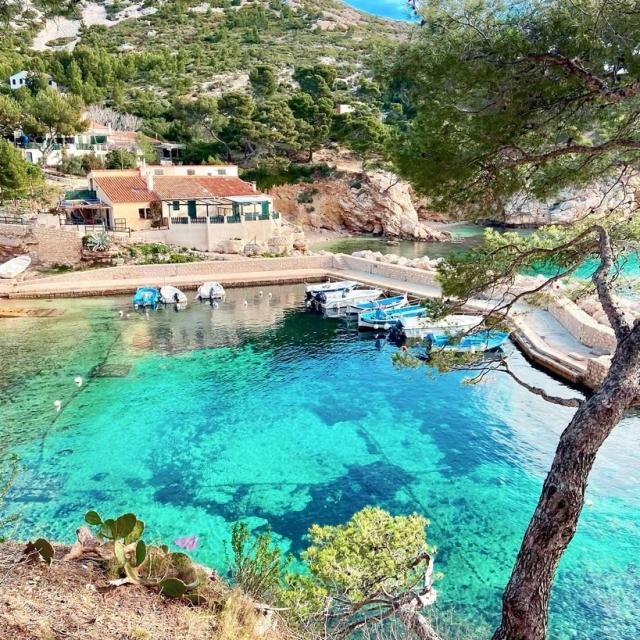
#calanques #calanquedenvau #calanquesdemarseille #calanque #parcnationaldescalanques #marseille #marseillerebelle #cheznousamarseille #wearemarseille #laprovence #coeurdepaca #lovepaca #fierdusud #suddelafrance #sudest_focus_on #explore_regionsud #tourismebouchesdurhone #tourisminprovence #madeinmarseille_officiel #marseillerebelle #igersmarseille #lespepitesdefrance #francetourisme #hellofrance #regionsudpaca #calanquesdecassis #hiking #randonnée#sormiou #sormioucalanque
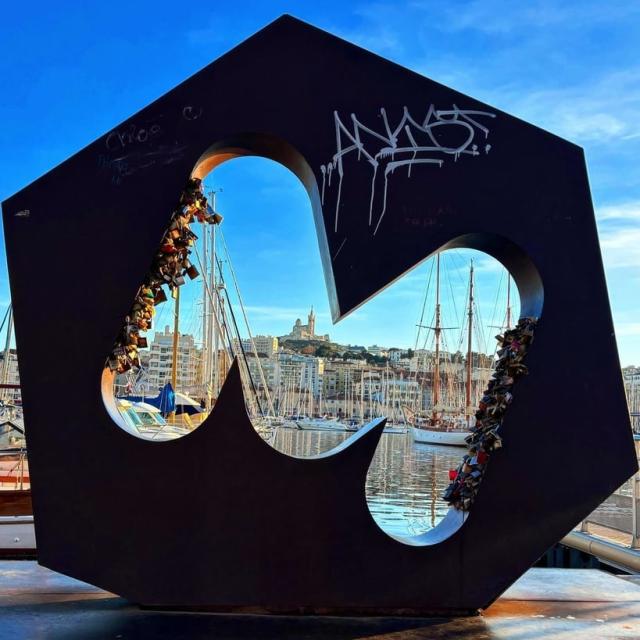
Marseille // Bouches-du-Rhône// Samedi 27 Janvier 2024 • #marseille #bouchesdurhone #vieuxport #paysage #ville #urban

Marseille, view from Chateau d´If #france🇫🇷 #marseille #beautifulmarseille #vivremarseille
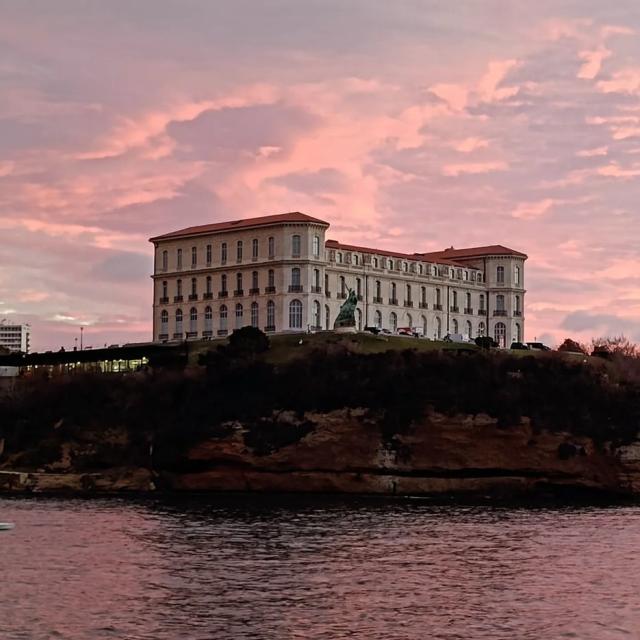
Palais du Pharo, Marseille. ✨ #palaisdupharo #palaisdupharomarseille #marseille #choosemarseille #marseilletourisme #france #ilovemarseille #ilovefrance #bouchesdurhone
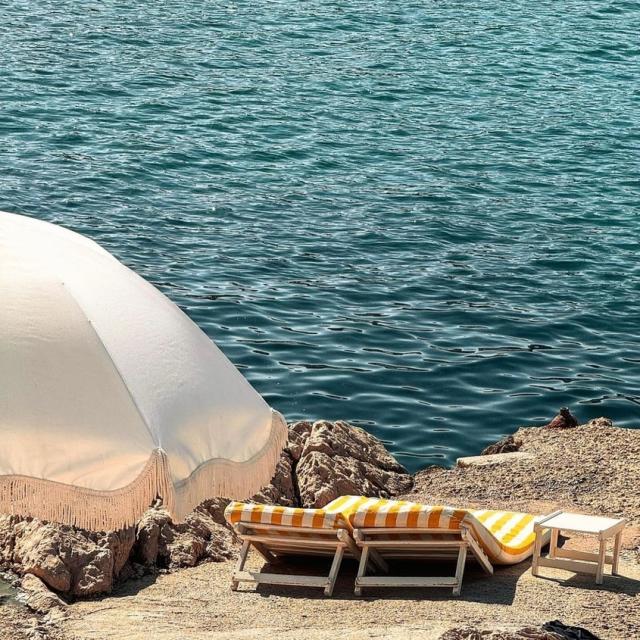
Presque. Bientôt. #tuba #tubaclub #summer #marseille
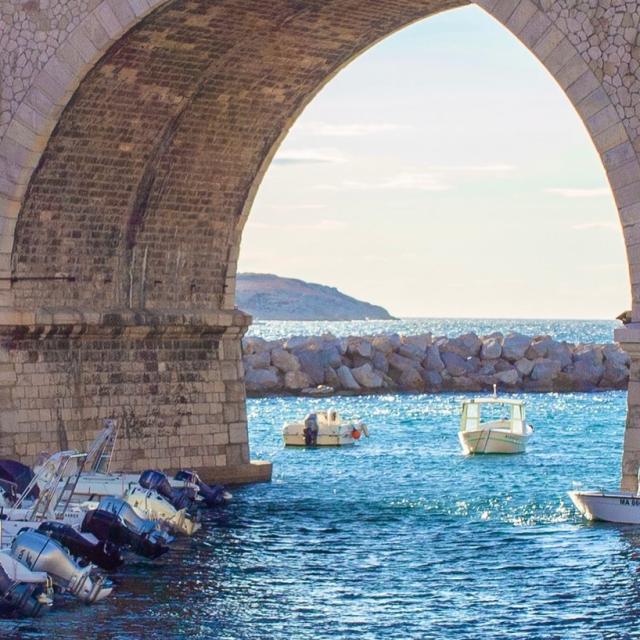
#marseille #vallonsdesauffes #port #bateaux #mer #sun #summer
- Travel trade
- Convention Bureau
- Professionals
- Marseille Experience

2 Days in Marseille – Itinerary and Tips
Article written by Elisa This article may contain compensated links. Please read disclaimer for more info.
Visit Marseille in 2 Days
2 days in Marseille itinerary. What to see in Marseille in 2 days.
Despite its varicolored reputation, often polluted by stories of crime and corruption, Marseille is one of France’s most endearing cities and the most exotic. Marseille is rough, loud, proud, and rebellious but also unique and – above all – Mediterranean.
Marseille in Southern France is the capital of the region Provence-Alpes-Côte d’Azur . It is France’s second-largest city and also the oldest (founded in 600 BC).
Since it was nominated the European City of Culture in 2013, the city has undergone a renaissance of all kinds, and it shows up more beautiful than ever: the famous Old Port was renovated, and one of the most exciting museums in Europe (the MuCEM) opened its doors.
Don’t expect, however, the postcard-perfect scenes found all over Provence . This is the “independent republic of Marseille,” with its culture, particular accent, and strong identity.
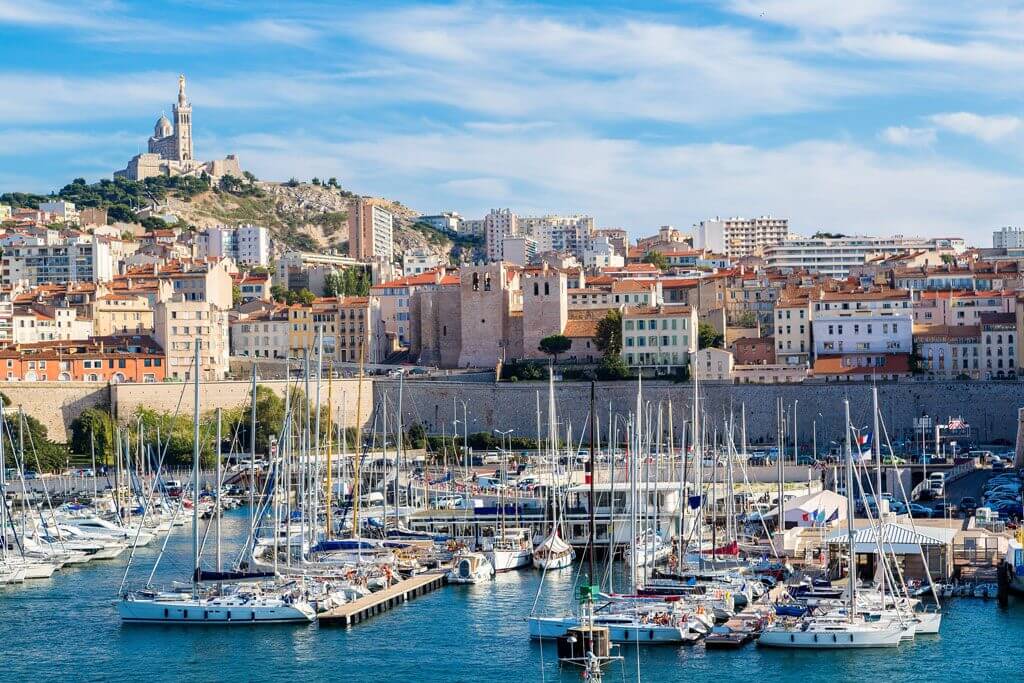
Many people arrive at Marseille on the way to somewhere else, but this city deserves much more than a few hours before taking the next train or cruise ship. Located on the Mediterranean coast, with 300 days of sunshine and a laid-back vibe, it is possible to travel from Paris to Marseille for a weekend getaway in less than 3.5 hours by TGV train.
If you are planning a trip to Marseille, you have come to the right place! Whether you prioritize sightseeing and ticking landmarks off your bucket list or simply soaking in the city’s atmosphere, this Marseille 2-day itinerary will show you the best things to do in Marseille and our best tips for a fantastic weekend in Marseille.
How many days in Marseille? We recommend spending at least 2 days in Marseille to soak up the city’s particular atmosphere, visit the main sights, and taste the local cuisine. Spend 3 days in Marseille or more to visit other places near Marseille.
Weekend in Marseille: Where to Stay?
Wondering where to stay in Marseille? For your two days in Marseille, we recommend staying central, close to the main sights. The area between the train station and the Old Port is central and safe .
Hotel la Résidence du Vieux Port : this charming hotel – with the perfect location right on the banks of the Old Port and the perfect view – is the ideal base to visit Marseille. The rooms are colorful and very comfortable, and the most expensive ones come with a balcony with a fantastic view of the Old Port and Notre-Dame-de-la-Garde. The hotel offers a good breakfast with a view and a restaurant on-site.
Alex Hotel & Spa : this is a contemporary hotel conveniently located next to the train station. We love the rooms’ contemporary design, with spacious bathrooms and soundproof windows. The breakfast (buffet) is great, with eggs or pancakes prepared upon request. The staff is very professional and always smiling.
Le Petit Nice – Passedat : this is a luxury hotel ideally located by the sea, featuring a bar, a beautiful terrace, a seawater outdoor pool, and a 3-star Michelin restaurant with excellent cuisine and sea views. The bright rooms are spacious, with chic décor and spectacular sea views. Le Petit Nice is the perfect hotel for a weekend getaway in Marseille, combining sightseeing and relaxation.
Check out all our favorite hotels in Marseille
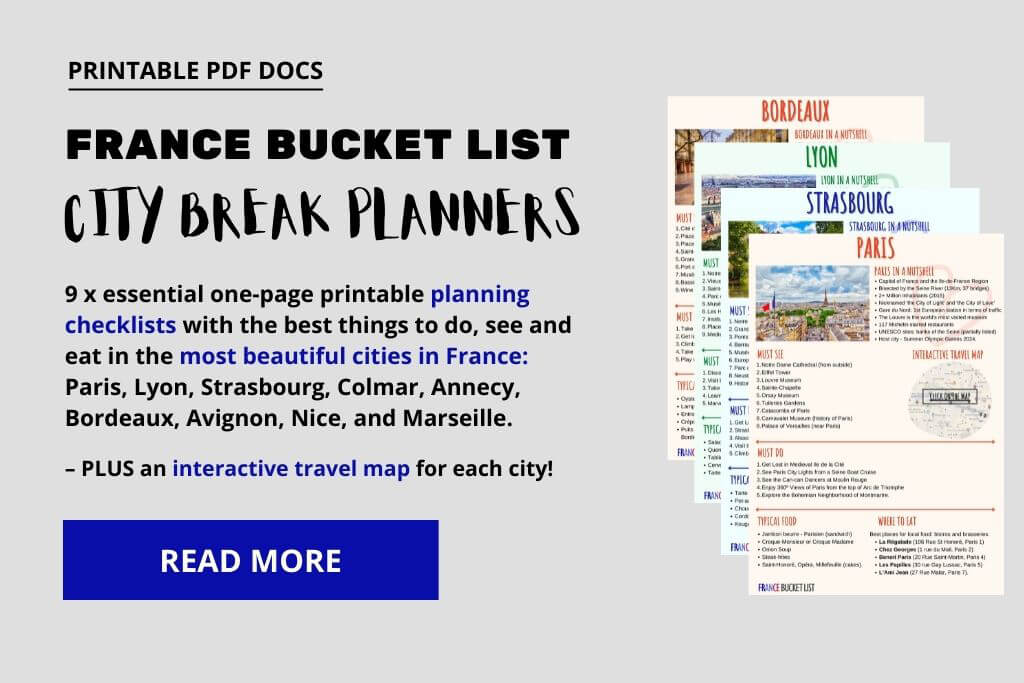
How to Spend 2 Days in Marseille – A Detailed Marseille Itinerary
Marseille is on our list of best weekend getaways in France ! For this Marseille in 2 days itinerary, we recommend arriving on Friday night, so you have two full days to visit Marseille.
TIP: the Marseille Pass 24hrs, 48hrs, or 72hrs includes access to the city’s main museums, public transportation tickets, and tastings.
Two Days in Marseille Itinerary: Day One
1. basilica of notre-dame-de-la-garde.
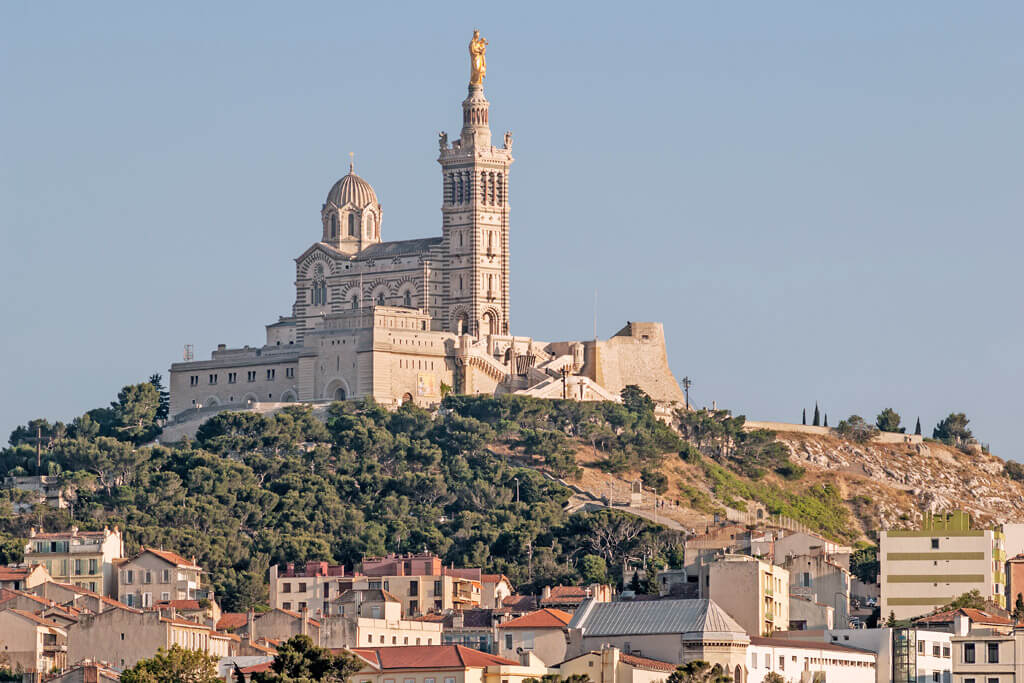
This Marseille itinerary starts from above, from Basilica of Notre-Dame-de-la-Garde , for the most incredible views.
It is impossible to dissociate Marseille from Notre-Dame-de-la-Garde : this beautiful striped building is for Marseille what the Sugarloaf is for Rio! Built in the 19th century on a sacred site for the last eight centuries, the “Bonne Mère ” (the Good Mother) watches over all her children.
The Basilica’s architectural style is Roman-Byzantine, and the interior is decorated with beautiful marble, mosaic tiles, and ex-votos from everywhere. This is a magical place that deserves to be visited in peace.
Being one of the main tourist attractions in Marseille, Notre-Dame-de-la-Garde gets very crowded with tourists and pilgrims after 10 am. We suggest arriving early in the morning (it opens at 7 am) to visit without the herds of tourists.
TIP: to enjoy the view and get a breath of fresh air, we recommend getting there by the many paths starting at the foot of the hill. However, the climb can be difficult for some, and the Basilica is also accessible by bus (line #60).
2. The Old Port and the Fish Market
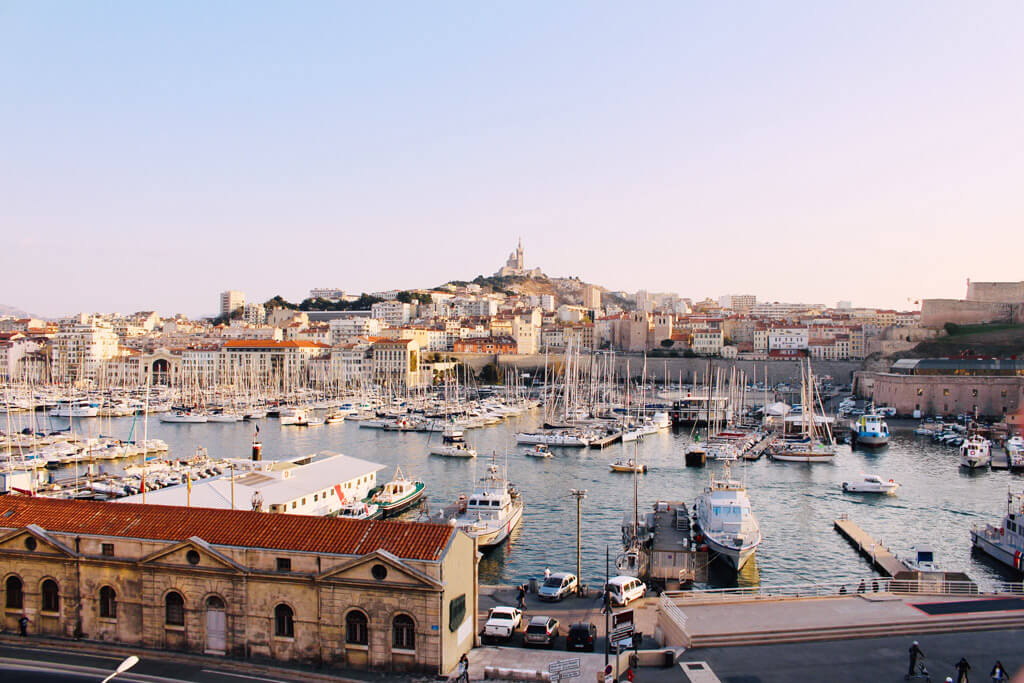
The Old Port is Marseille’s beating heart, where everything began 2,600 years ago.
The Old Port was the economic center of Marseille, open to trade in the Mediterranean Sea and then in the French colonies. In the 19th century, commercial port activities were moved further north to the basins of the Grand Port Maritime, and the Old Port lost its trading function.
Today, the Old Port is a picturesque marina, a myriad of colorful pleasure boats, and a popular gathering place amongst locals.
In the Old Port, don’t miss Place Thiars , with its special “Venetian campo” atmosphere, and of course the Fish Market . Located on Quai de la Fraternité, the iconic Fish Market is held every morning from 8 am to 1 pm. The fishermen come here just after their night fishing to sell their fresh fish caught nearby. Due to its central location, the Fish Market is also a kind of tourist attraction.
3. Abbaye Saint-Victor and Palais du Pharo
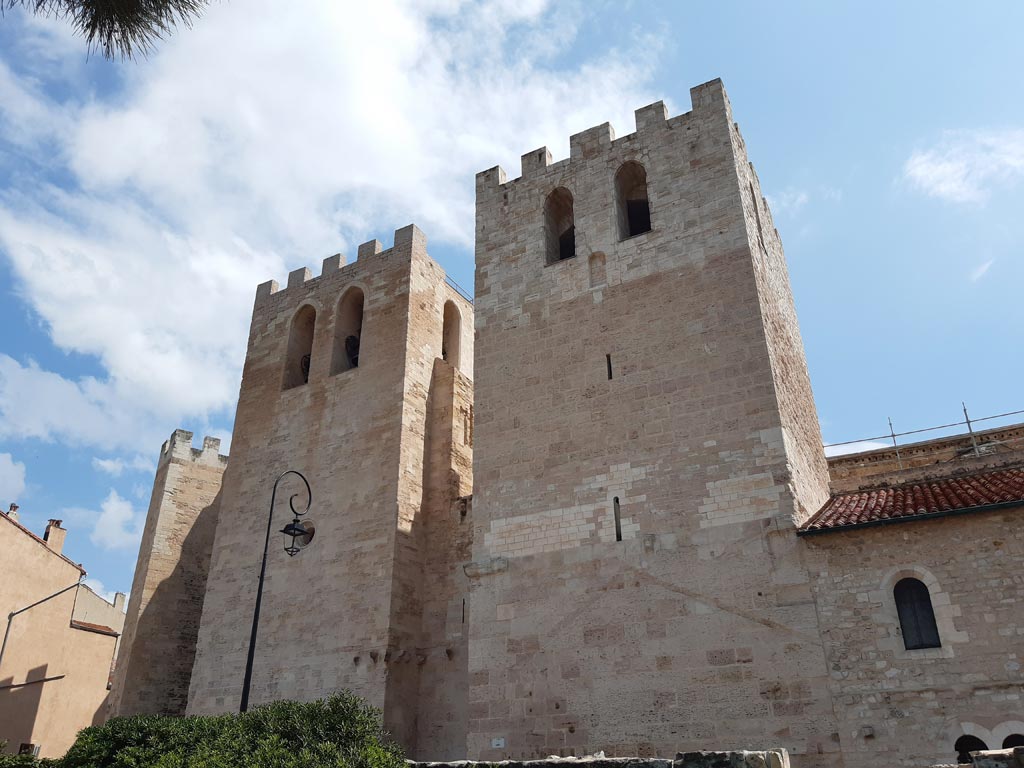
After lunch, continue to the end of the dock. You will find the imposing Abbaye Saint-Victor , which hosts a remarkable collection of sarcophagi, Christian and pagan, in its crypt. Then push on to Palais du Pharo and its beautiful garden.
Built on the headland Tête de More and overlooking the entrance to the Old Port, the Palais du Pharo was commissioned by Napoleon iii in 1858, but it was finished after his fall. The Empress Eugénie took the city of Marseille to court to get it back, won the trial, and . . . finally she decided to give it to Marseille in 1883.
The Palace is only open for special occasions. From the garden, however, there’s an amazing view of the Old Port and the Mediterranean Sea, and visitors can also see the islands of If and Frioul . One of the most famous castles in Southern France , Château d’If, is the grim island fortress off Marseille where the Count of Montecristo was imprisoned. The Count of Montecristo , by Alexandre Dumas, is one of the most famous novels set in France .
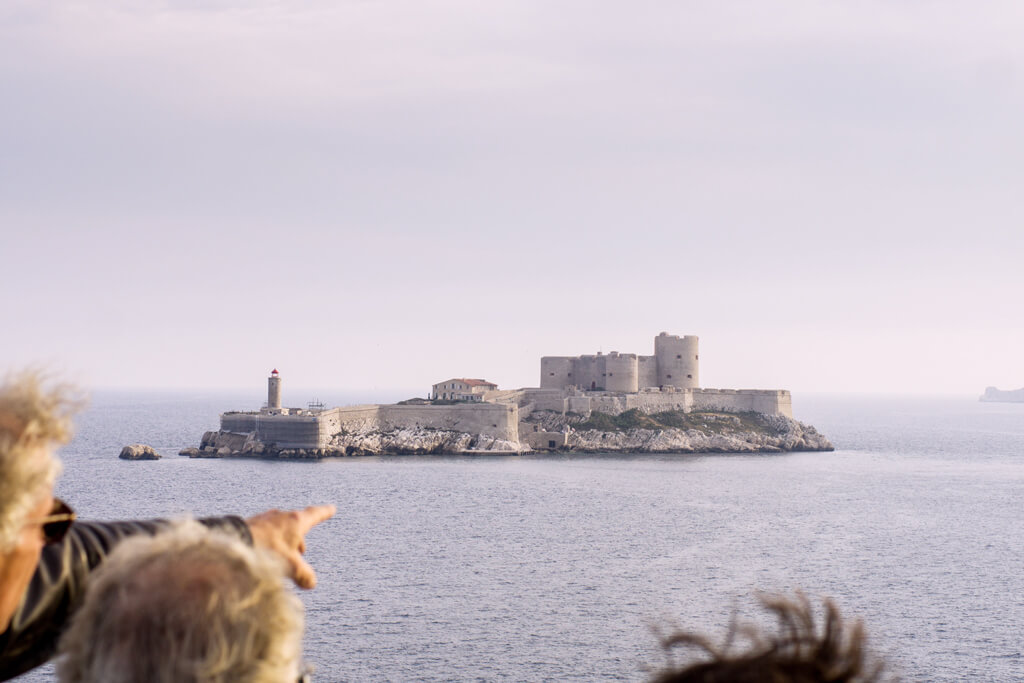
4. Vallon des Auffes
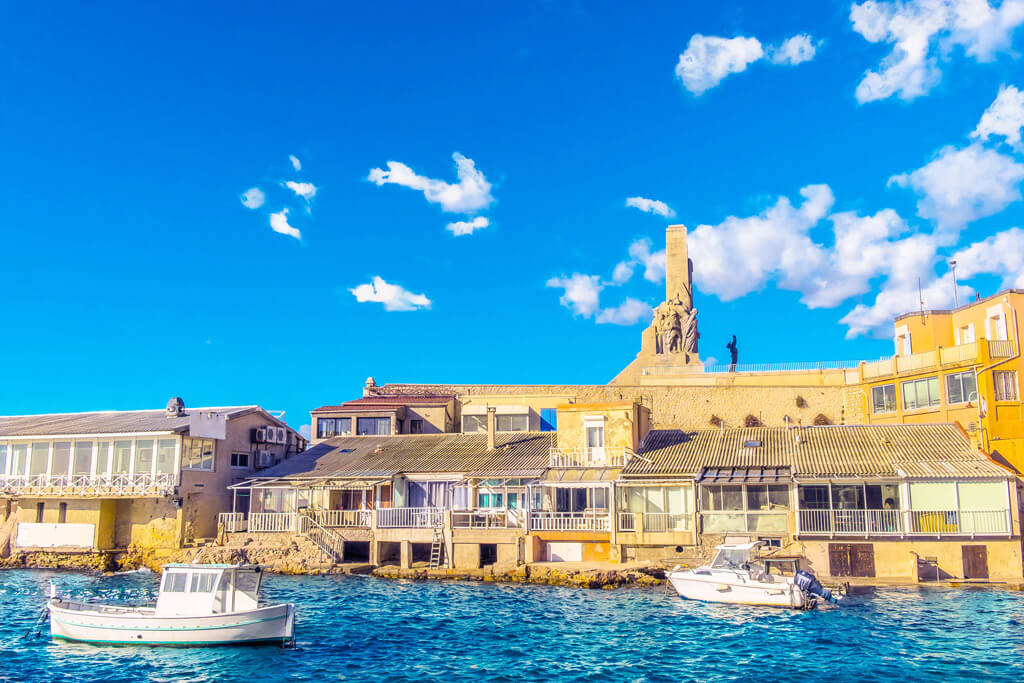
Finish the first day of this Marseille weekend trip at the charming fishing port of Vallon des Auffes . Nestled between two cliffs and facing the sea, the Vallon des Auffes is one of the most picturesque places in Marseille, and it offers the impression that time stopped many decades ago.
Vallon des Auffes is one of the most emblematic places in Marseille, a small peaceful haven so close and so far away from the hustle and bustle of the city. This is also one of the most beautiful settings to dine in Marseille (sunsets here are amazing), perfect for your Saturday dinner if you are here for the weekend (see our proposals at the end of the post).
Two Days in Marseille Itinerary: Day Two
5. le panier neighborhood.
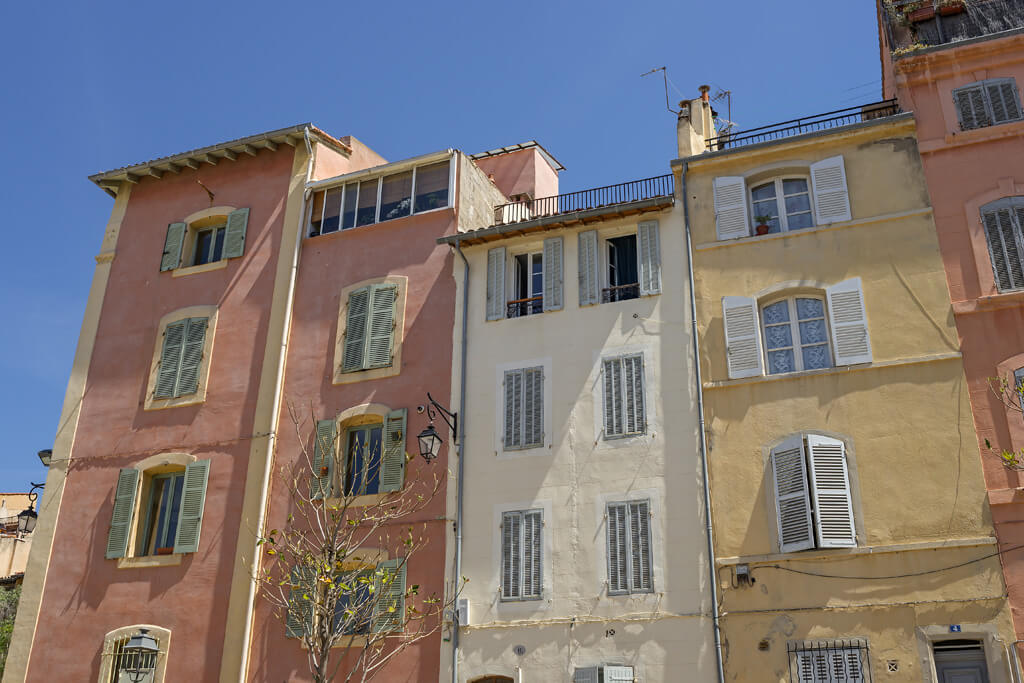
The second day of this Marseille itinerary starts at Le Panier, Marseille’s historical neighborhood, where visitors can find real Marseille. Le Panier is located on the north of the Old Port, behind the former Hôtel Dieu’s façade (today Hotel Intercontinental).
Historically Le Panier was the immigrants’ neighborhood, inhabited mainly by Italians and North Africans. It was also the neighborhood of the sailors, at least when they were not sailing! An old tradition of this neighborhood was to keep a free bed in the house to welcome any disembarked sailor who showed up unexpectedly.
Wander around the narrow streets of this charming neighborhood with no direction; there are beautiful corners everywhere. We love its Mediterranean atmosphere; it is as if we were in a village! Don’t miss La Vieille Charité , in the heart of Le Panier. It was built to host vagabonds and is a superb example of civil architecture of the 17th century.
TIP: This morning walking tour of Le Panier , with a local guide, is perfect for this 2-day itinerary Marseille.
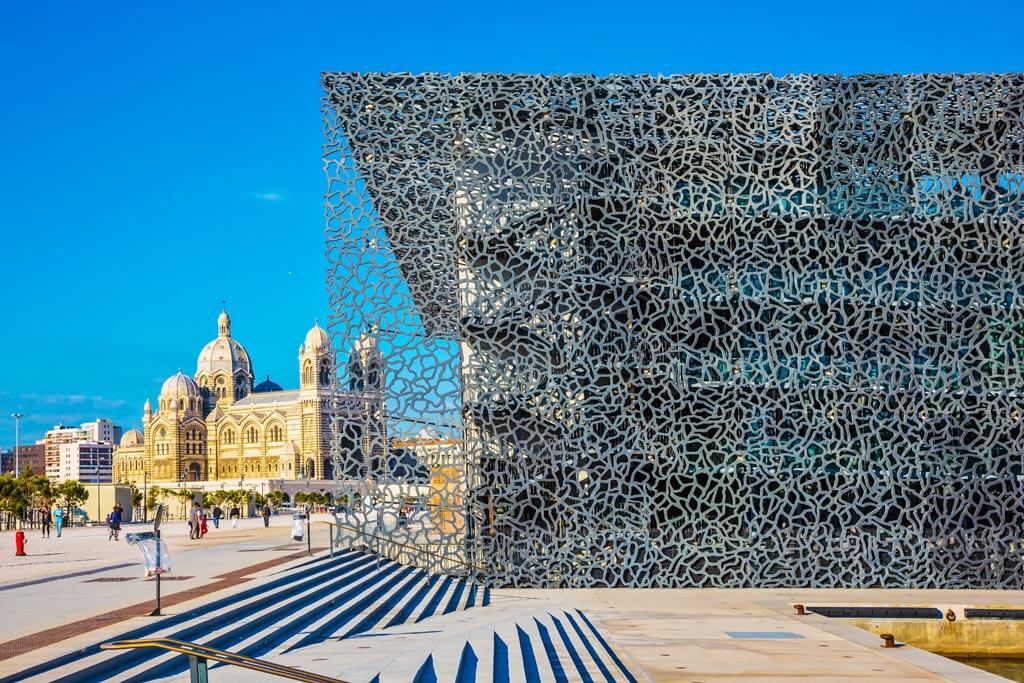
The MuCEM , or Museum of Mediterranean Cultures, is Marseille’s striking new museum, inaugurated when the city was the European City of Culture in 2013. The architecture of the building is great to visit, without forgetting the interesting temporary exhibitions. The museum also proposes films, debates, concerts, and other cultural shows – book your tickets here .
Fort Saint-Jean and Marseille’s Cathedral
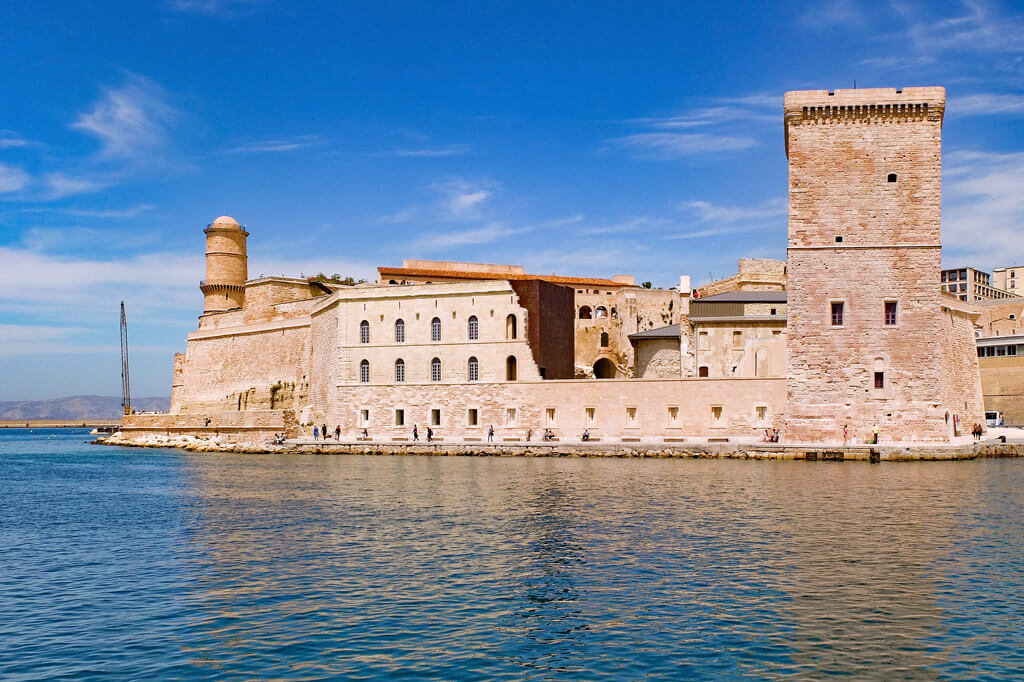
This is a great area to explore in the afternoon. The Fort Saint-Jean is a splendid defensive construction of the 12th century, beautifully restored for the 2013 events. There are some vestiges Greco-Romans (non-visible), and it is composed of a small chapel, a square tower (15th century), and a round tower (17th century) used to light up the entry to the Old Port.
If you follow Quai de la Tourrette, you will reach Marseille’s Cathedral, Cathédrale La Major, also visible from the MuCEM. Probably by now, the Cathedral will be closed, but it is well worth the short walk to see its architecture from the outside.
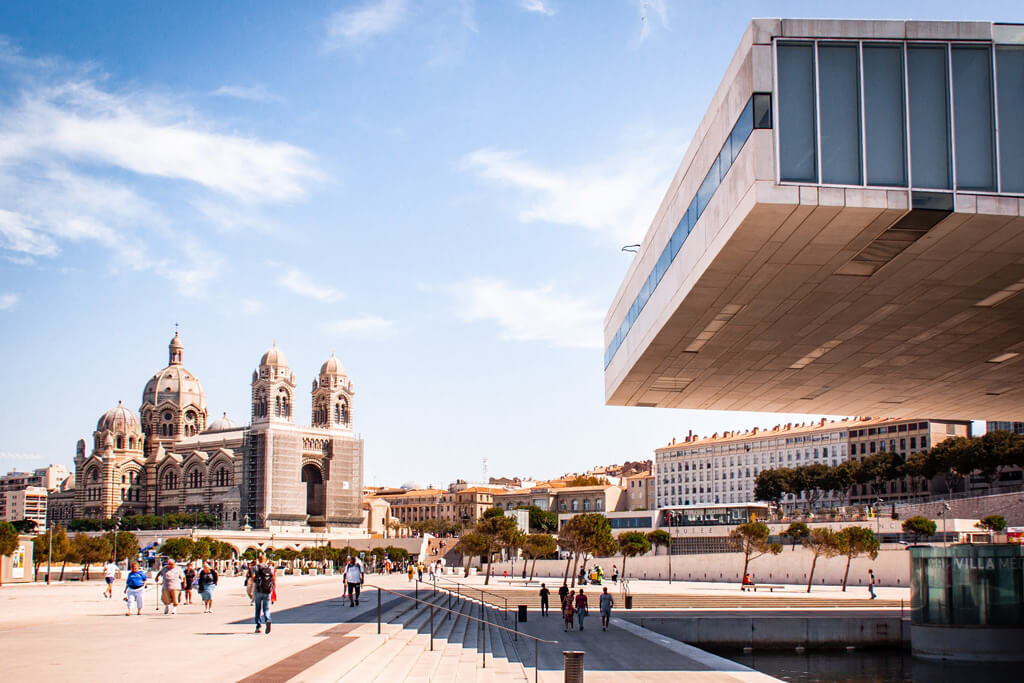
Spend Three Days in Marseille (if you can …)
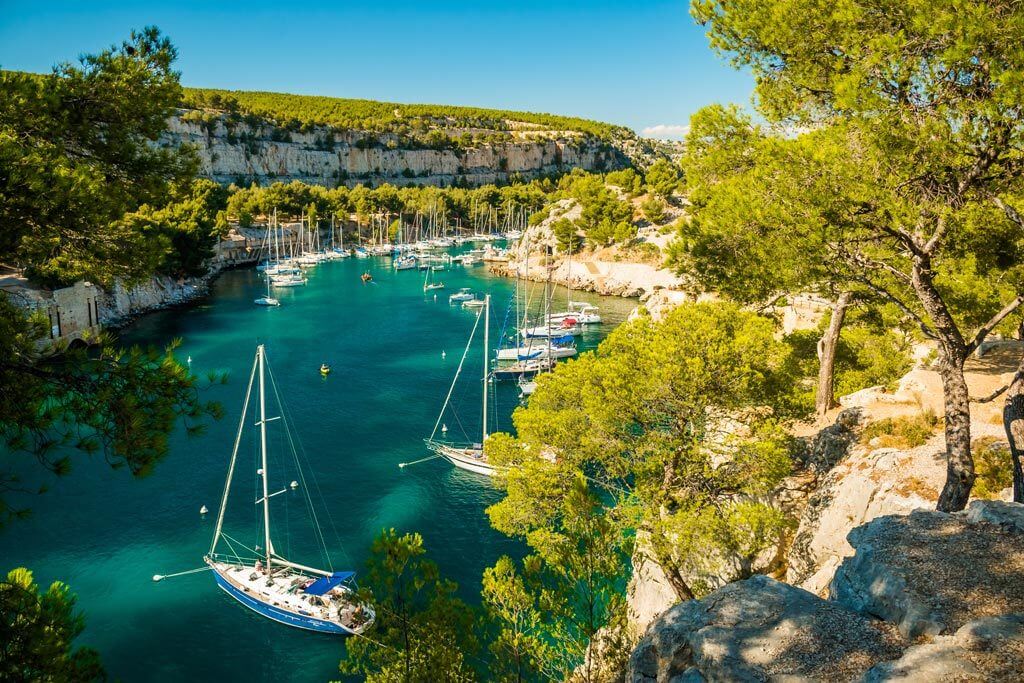
If you can make it to spend 3 days in Marseille, don’t miss the Calanques de Marseille – Cassis , they are wonderful! We visited part of the Calanques on a day hike with a picnic on-site and a cold beer at the end of the hike in Cassis before going back to Marseille by bus.
A great way to visit the Calanques is to join this top-rated catamaran cruise with lunch . With the catamaran, guests can access the most secluded creeks for a refreshing bath far from crowds.
You can also rent a boat in Marseille , with or without a skipper, and craft your own itinerary far from the crowds.
Practical Information for Your Marseille 2-day Itinerary
How to travel to marseille.
BY PLANE: Marseille-Provence (MRS) is one of the main international airports in France , and it covers many international destinations in Europe, Africa, Asia, the Middle East, and America via regular or seasonal flights – Click here for flight schedules and prices . If you need transportation, click here to book your transfer from Marseille airport to the city .
BY TRAIN: Marseille is well connected with other main cities in France. Count on taking it 3h 35 min for a Paris-Marseille, 2h 43 min for a Marseille-Nice, and 1h 44 for a Marseille-Lyon. Click here for schedules and prices .
Don’t forget your travel insurance!
HeyMondo offers travelers insurance that combines medical and travel-related coverage for single trips (leisure and business trips), annual multi-trip, and extended stays (with COVID-19 coverage included). Use this link and get a 5% off for being our reader .
2 Days in Marseille: Where to Eat
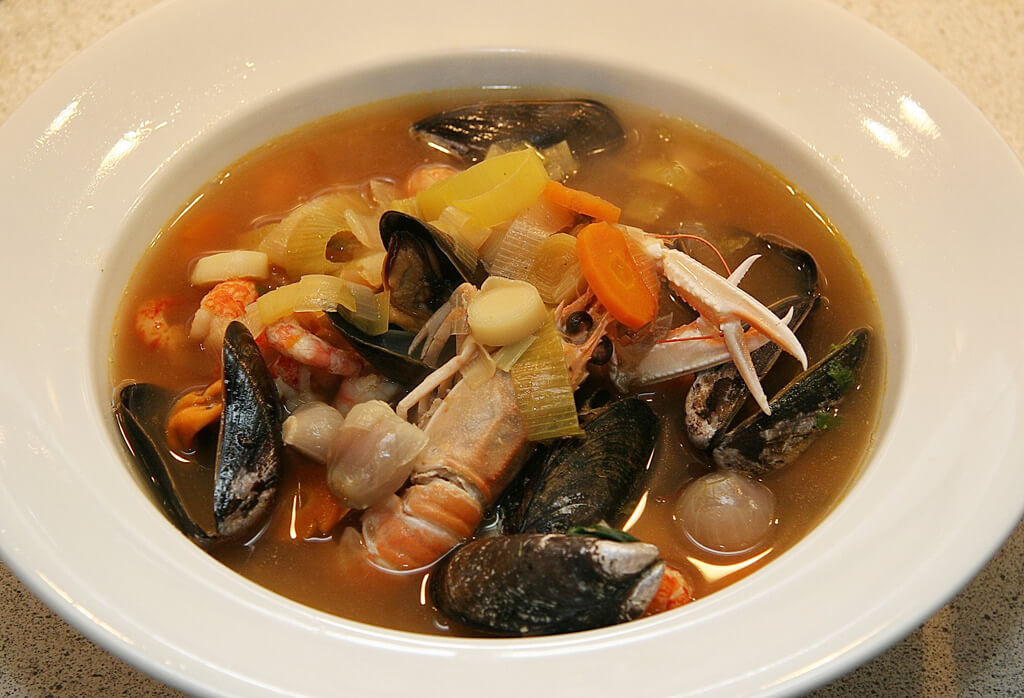
If you don’t know what to eat in Marseille, here’s a quick guide to food in Provence .
LA PASSARELLE: For a casual lunch in the area, head to La Passarelle (52 Rue Plan Fourmiguier). Sit in its beautiful garden under the arbor, and expect good Mediterranean cuisine prepared with fresh products and served with a smile.
UNE TABLE AU SUD: Head to Quai du Port for a good meal with a view. On the first floor of a building, Une Table au Sud (2 Quai du Port) has a fantastic view of the Old Port and even more amazing cuisine. Its chef, Ludovic Terac, is one of Marseille’s most inventive young chefs. Don’t miss this restaurant, which is also open on Sundays.
LE MOLE: This is the MuCEM’s rooftop restaurant, which offers meals with great views of the Old Port.
For a special treat in the evening, the Vallon des Auffes boasts two of Marseille’s very top fish restaurants: the Michelin-starred L’Epuisette (158 Rue du Vallon des Auffes) and the historic Chez Fonfon (60 Cor Président John Fitzgerald Kennedy), both well-known for their bouillabaisse (best quality for a fair price).
CHEZ JEANNOT: Also at Vallon des Auffes, Chez Jeannot (129 Rue du Vallon des Auffes) is a friendly family-owned pizzeria and a kind of institution in Marseille, whose history dates back to 1949. It has a pleasant terrace and a big space protected from the Mistral. Come to Chez Jeannot to taste its savory pizzas but also for the grilled fish and seafood.
Click here for more City Guides
Back to Homepage
Disclaimer: This article may contain compensated links, meaning we get a small commission if you make a purchase through our links. It costs you nothing more (in fact, if anything, you’ll get a nice discount) but helps us to go on creating incredible French content for you. We trust all products and brands promoted here and would never recommend anything that isn’t of value. Please read disclaimer for more info.
(C) Copyright 2019 - 2024 France Bucket List. All Rights Reserved. Designed & Developed by France Bucket List || Disclaimer || Privacy Policy || Contact |
- Best Time to Visit
- Weather & Climate
- Marseille Provence Airport Guide
- Neighborhoods to Explore
- Best Hotels
- Public Transportation
- 48-Hour Itinerary
- Day Trips From Marseille
- Top Things to Do
- Best Beaches
- Where to Go Shopping
- Food to Try in Marseille
- Best Restaurants
- Nightlife Guide
- Search Please fill out this field.
- Newsletters
- More to Explore
- Things To Do
The 14 Best Things to Do in Marseille, France
:max_bytes(150000):strip_icc():format(webp)/profilepic-CTraub-5b6ff65d46e0fb00505577c1.jpg)
Pocholo Calapre / EyeEm / Getty Images
One of France's largest urban centers, the Mediterranean city of Marseille is as distant from Paris as you can imagine—both geographically and culturally. It's an ancient port that has long been a center of trade; "les Marseillais" (the locals) are proud of their distinctive culture and centuries-long history. It's known for its beauty, but also for being a bit "rough around the edges"—and that's all part of the appeal.
At once laid-back and vibrant, Marseille has it all: superb beaches and coastlines ; varied, fascinating neighborhoods; awe-inspiring historic monuments; and delicious local dishes and drinks that are certainly worth sampling. Add the opportunity for day trips to nearby national parks and postcard-perfect Provençal towns , and you'll soon see why the city makes an ideal hub in southern France. Here are some of the best things to see and do in Marseille, especially on a first trip.
Explore the Old Port
TripSavvy / Paula Galindo Valle
Old Port of Marseille
There's something timeless—even mythical—about Marseille's Vieux Port (Old Port), the waterfront that has seen some 26 centuries of trade and cultural exchange. The Phoenicians founded a colony called Massalia here in around 600 BC, and it became a major center of commerce in the Mediterranean, incorporated into the Roman Empire before being christianized during the 5th century. During the medieval period and religious wars known as the Crusades, the Port was guarded by the forts of Saint-Nicolas and Saint-Jean ; both continue to dramatically flank the port, and can be visited.
The Vieux Port may have tons of history, but it's still a vibrant center of present-day life in Marseille. Come take a stroll on the waterfront and admire the countless boats and ships moored in the harbor. Sit out at a terrace overlooking the port and enjoy a glass of wine or pastis, a typical Marseille liqueur flavored with anise and botanicals. Take a tour of the two forts, and/or a boat cruise out to the Friouil archipelago and islands beyond.
Visit the Chateau d'If, an Old Fortress and Prison
Château d'if.
One of Marseille's most dramatic landmarks, the Chateau d'If looms near the coast of the old city, on the smallest island of the nearby Frioul archipelago. Built by King François I and completed in 1571, the formidable compound has served as a defensive fortress designed to protect Marseille from military invasions, as well as a state prison. Protestants and anti-monarchy figures were the most frequent prisoners between 1580 and 1871.
In 1844, French author Alexandre Dumas brought the Chateau d'If worldwide fame by placing it at the center of his novel "The Count of Monte Cristo." Today, it's an essential tourist destination and affords fantastic views over the sea and Old Port.
Getting there: From the Old Port, you can take a boat shuttle operated by Frouil If Express ; boats depart several times daily.
Head to the Beaches
During long summer days, planting a big beach umbrella in the sand and spending the whole day swimming, sunbathing, or boating can be an idyllic prospect. And even if you're visiting in the winter when chilly winds and cool temperatures often reign, you'll still probably want to hit the beaches around Marseille for activities such as coastal walks and sea views.
Where to find the best beaches in Marseille and its surrounding area depends on your style and preferences. If you're after a quick swim close to the city center, Catalanes Beach is only a 15-minute walk from Vieux Port. It's not the prettiest beach in the area, but it's ideal for a spontaneous dip.
For lifeguarded swimming during high season, head to the Plage du Prado or the Plage du Prophète , both wide, sandy beaches that are ideal for families, sunbathers, and sports enthusiasts. If you're drawn by wild beaches with stunning natural scenery or opportunities for snorkeling, head to the Calanques National Park and its remarkable coves.
Taste the City's Best Bouillabaisse
kabVisio /Getty Images royalty-free
Not everyone will think that Marseille's most-famous dish, bouillabaisse, sounds appealing. But unless you're vegetarian or vegan, we still strongly recommend you try a big, steaming bowl of this centuries-old fish stew originating in ancient Greece, and imported by the Phoenicians who colonized the area. Typically made with the fresh catch of the day or a variety of local seafood specialties, the stew is composed of an herb and saffron-rich broth, olive oil, and seasonal vegetables. Traditionally, you'd enjoy it accompanied by a toasted hunk of baguette and a spicy, garlic-rich paste called rouille.
The stew is so popular that you'll find it all over the city, year-round. But some of the best (and most picturesque) places to taste it are found on the Vieux Port; these include Le Miramar and Restaurant Michel .
See the City's Iconic Basilica—and Enjoy Panoramic Views
Basilica of notre-dame-of-la-garde at marseille.
Looming over one of the city's highest points, Notre Dame de la Garde is widely seen as the symbol and figurative guardian of Marseille. The basilica is locally referred to as "La Bonne Mère," meaning "The Good Mother," and a bronze and gold-leaf statue of the Virgin Mary emerges from the bell tower.
Consecrated in 1864 on the site of several former chapels, the basilica was built in a Roman-Byzantine style. Come not only to admire its opulent façade and interior—rich with gold leaf, mosaics, elaborate dome structures, and stones in multiple hues—but also to enjoy sweeping panoramic views over the city, Old Port, and the waters beyond.
Getting there: We recommend taking the Petit Train de Marseille sightseeing train from the Old Port to the Basilica; this is also a great way to get an overview of some of the city's other key sites.
Take in the Splendor of Calanques National Park
Massif des calanques.
Detractors sometimes describe Marseille as a city lacking in "traditional" beauty, yet they've clearly overlooked that the city is surrounded by some of the region's most stunning and well-protected marine environments. The Calanques National Park , sprawling between the outskirts of Marseille and the pretty port town of Cassis, is remarkable for its azure waters, which wend through craggy creeks (calanques) teeming with lush Mediterranean greenery.
Swim in protected coves whose waters are too blue to believe, or go snorkeling, boating, hiking, or rock-climbing in the park's seemingly endless calanques.
Getting there: From Marseille's Old Port, drive or take a taxi south to the national park (around 35 minutes). Alternatively, you can take the train to Cassis; from the town center, the "Port Miou Calanque" is around 30 minutes away on foot. There are numerous other trail departure points there as well.
Wander and Shop the Canebière District
J Boyer /Getty Images Plus
To get an authentic local sense of daily life, head to La Canabière , the longest and widest avenue in the city. Built in 1666, it was greatly expanded during the end of the 18th century, and its grand neoclassical-style buildings reflect the period. It now extends all the way to the Vieux Port, making it an easy access point from the waterfront to the city center.
This is a popular place to stroll, browse for clothes and other items in the avenue's many boutiques, window-shop, and people watch from café terraces. Department stores, grand hotels, and restaurants also occupy the long avenue, which is adjacent to some of the other best shopping streets in Marseille, including rue Paradis, rue Saint Ferréol, and rue de Rome.
Get a Taste of Local Culture at the Capucins Market
Pharmacie marché des capucins.
If you share our enthusiasm for local farmers' markets and the opportunities for cultural discovery and exchange they tend to afford, this place is for you. Located in close reach of La Canebière shopping district, the Marché des Capucins is well known for proffering some of the city's best, and least expensive, fruit and vegetables.
You'll also find numerous stalls selling food products, spices, and textiles from North Africa and other parts of the Greater Mediterranean. You might say the market—also referred to as the Marché de Noailles—carries forth Marseille's centuries-old tradition as a bustling, diverse center of trade and cultural exchange.
Bask in Mediterranean History at The MuCEM
Mucem - museum of civilizations of europe and the mediterranean.
If you're interested in learning about the region's history—including Marseille's—spend some time exploring MuCEM (Museum of the Civilizations of Europe and the Mediterranean). It only opened in 2013, but is now one of the world's 50 most-visited museums. Tracing diverse traditions from the Antiquity to the present, its collections and special programs tell the fascinating story of Mediterranean cultural practices, archaeology, art history, cultural traditions, and contemporary art,
The main site near the Old Port, designed by Rudy Ricciotti and Roland Carta, stands beside the 17th-century Fort Saint Jean. Footbridges between the new and old structures dramatically symbolize how the Mediterranean forged powerful connections between European and Middle Eastern cultures.
Wander Old Marseille in the Panier District
Situated just north of the Old Port, Le Panier (literally, "the basket") has had inhabitants since around 600 BC, making it the oldest part of the city. It was once the center of a Greek colony called Massalia, from which Marseille's name is derived. During the 17th century, it was abandoned by more affluent residents for new developments to the east, and became a principally working class district populated by sailors and fishermen. It has also welcomed waves of immigrants from Italy, Corsica, and North Africa over the centuries. As evidenced by the old almshouse (La Vieiille Charité), it was until recently one of the city's poorest districts.
Today, Le Panier's narrow little streets, cheerful squares, and hidden corners are dotted with café terraces, hip restaurants, street art, and boutiques selling everything from Marseille soap (savon de Marseille) to jewelry. Be sure to take in the ochre and bright yellow façades, stone stairways, and hilly passageways; then wander through a few boutiques before settling for lunch on one of the area's sun-soaked squares.
Stroll or Drive La Corniche, Marseille's Coastal Road
Chris Hellier/Getty Images
One fantastic way to see the ancient port, sea, and islands from different vantage points is to take a long (often blustery) stroll along La Corniche , a boardwalk-style pathway built parallel to the coastal road of the same name. You can also drive it if you choose to rent a car.
The promenade stretches for 3 miles from the Catalanes beach to the Prado beach. Along the way, you'll see noteworthy sites including the aforementioned Chateau d'If and Iles du Frioul (Frioul islands), opulent villas and mansions like the one pictured above, and excellent sea views.
Getting there: Pick a sunny day to enjoy the route or path to the fullest—not a difficult task in a city that gets an average of more than 300 days of sun a year. To walk, follow the signs and easy path from the Old Port to La Corniche.
Take a Train to Cézanne's Favorite City
Jean-Pierre Lescourret/Getty Images
Hop on the train from the Marseille Saint-Charles station and spend a few hours roaming Aix-en-Marseille , one of the prettiest towns in the region. The birthplace of French painter Paul Cézanne, Aix and its surrounding mountains are the subject of many of his paintings. The popular market town is also renowned for its historic district, where you can bask in the sun on Provençal squares lined with warm-colored buildings and shaded by large trees. Have a drink or al fresco lunch on one of the terraces in the Cours Mirabeau, and take in the sights, colors, and traditions of the farmers' markets on and around Place Richelme.
Getting there: Trains depart around six times daily from Marseille Saint-Charles to Aix, with the direct TGV (fast train) taking only around 15 minutes. Booking in advance generally means you'll get lower fares.
Play a Game of Boules
iStock/Royalty-Free/Getty Images
Especially during the warmer months, a common sight in Marseille is locals playing a game of pétanque , or boules. The game, similar to bocce, involves throwing grooved metallic balls on sandy pitches, aiming to get yours as close to the smaller target ball (called a "cochonnet") as possible. While some play it competitively, most locals enjoy it casually, as an excuse to catch up with friends and sip tall, ice-cold glasses of Pastis de Marseille mixed with water.
The game is widely played across the city, including around the Old Port and in local parks. To rent equipment and access pitches, you can head to recreation centers such as the Cercle des Boulomanes (50 Rue Monte Cristo).
Frolic at Borély Gardens & Château
Courtesy of Chateau Borély
Parc Borély
Situated around 3 miles south of central Marseille, the sprawling grounds and gardens of the Château Borély offer an ideal way to get a break from the urban ground and enjoy some fresh air. The Parc Borély is one of the city's most popular local green spaces, boasting enormous green lawns, botanical gardens harboring thousands of species of plants, poetic canals filled with ducks and swans, and playground areas. There's even a beach-side walk from the grounds.
The 18th-century château now houses the Museum of Decorative Arts and Fashion, whose collections are noteworthy for their fine ceramics and exhibits dedicated to the history of style.
Related Articles
More related articles.
National Geographic content straight to your inbox—sign up for our popular newsletters here

A guide to Marseille: beaches, bouillabaisse and street art on the French Med
As France gears up to host the Rugby World Cup, take the time to explore one of its key venues — a truly Mediterranean city in the midst of a decade-old renaissance.
“Marseille has a strong personality,” says tour guide Alexandra Blanc Véa as we take in the art of the graffiti-splashed Cours Julien district. A Paris native who’s been a resident of Marseille for over 20 years, she leads me down streets hastily sprayed with calls for strike action, to reach the grand, climate-conscious mural Man vs Wild. This piece by local artist Mahn Kloix covers the side of a house and shows a man in yellow trunks and flippers swimming to meet an enormous turtle.
“You either like it here or you don’t, but you can’t stay in the middle,” says Alexandra. Marseille has a fascinating past, and receives more sun than anywhere else in France. It has a glittering harbour, magnificent seafood and easy access to the rugged beauty of nearby Calanques National Park. But bits of it are undeniably falling apart, after a mid-20th century slump in its fortunes that has only recently begun to improve. Marseille wouldn’t be the first great trading port to combine grit and grandeur, but its unpolished image sets it apart from most French cities.
At least there is plenty of material for street art tours. Cours Julien’s colourful streets spider off from a central square lined with bistros and bars, all abuzz with chatter. Almost every square inch of concrete is a canvas for bug-eyed cartoons, surreal patterns or eviscerating political statements.
This hilltop neighbourhood is the heart of a youthful and modern Marseille, but down at the cinematic Vieux Port (‘Old Port’) there’s also a buzz from the departing tour boats, harbourside cafes and fishermen selling their morning’s catch at makeshift stalls. Bouillabaisse, a traditional seafood stew, originates in this city and is said to have been invented by its fishermen, who boiled some of their catch in seawater while out at sea.

Maritime history runs deep in Marseille, where a pair of imposing forts flank the harbour entrance and a scattering of small, rocky islands lie in the sparkling sea just beyond. It was founded by Greek-speaking Phocaeans 2,600 years ago, making it France’s oldest city. As French colonial rule expanded across the globe in the 19th century, Marseille’s strategic location on the Mediterranean transformed the city into a place where all kinds of people, goods and ideas converged. But its hard-edged reputation in the late 20th century meant it never received the same attention as Cannes and Nice, further east along the Riviera.
Things changed in 2013 when Marseille served as European Capital of Culture and its waterfront was embellished with eye-catching projects. Foremost of these is the bold glass and black concrete lattice structure of Mucem, the Mediterranean culture museum, designed by Algerian-born architect Rudy Ricciotti. Next to it is the angular, cantilevered Villa Méditerranée, which houses a replica of the south-coast Cosquer Cave and its prehistoric rock art engravings. And at the inner end of the Vieux Port is L’Ombrière de Norman Foster, with its clever, mirrored canopy, dreamt up by the eponymous UK architect.
“Because of this, a lot of tourists suddenly came to visit and they realised the city was very interesting,” Alexandra says. “And that you have to go further, beyond the reputation.” Ten years after it drew the eyes of the rest of the world, and as it prepares to host several games at the 2023 Rugby World Cup, Marseille is once again in the spotlight.
What to see & do
Part of Marseille’s post-2013 revival, this is the first museum dedicated entirely to the culture of the Mediterranean. Exhibitions cover everything from trade and conflict to questions on why the Mediterranean diet is thought to lead to longer lives. The museum’s concrete lattice shell rises from the Vieux Port’s north shore, and is linked by a footbridge 60ft above the lapping waves to the 17th-century bastion of Fort Saint-Jean, offering stunning harbour views.
Street art tour
Alexandra Blanc Véa’s tours of the Cours Julien neighbourhood and its street art give context and colour to Marseille’s distinct identity. Learn about how hip hop influenced the city’s graffiti culture, why new art is being painted directly onto street surfaces and what avoir la banane (‘to have the banana’) means. There’s also a chance to meet local street artists, such as Mahn Kloix, in their studios. Book tours in English via [email protected]
North of the Vieux Port, Marseille’s oldest district was settled by the ancient Greeks. These days, it’s a typically Mediterranean street scene, with hanging baskets and pastel-green shutters. Street art and sun-dappled corner cafes add further colour. Downhill from the neighbourhood is the grandiose, 19th-century Marseille Cathedral, with its Byzantine-style domes.

City beaches
Marseille’s coast may lack the glamour of Saint-Tropez and Antibes, but its 21 beaches still provide a change of pace. Those of the Prado are the largest, while Plage des Catalans is the closest to the centre, just a 15-minute walk from the Vieux Port. Its 100 yards of sand are popular with locals, from volleyball players to tracksuit-clad retirees striking yoga poses.
Château d’If
Two miles from the Vieux Port, and reached by frequent sightseeing boats, is the rocky fortress made famous by its fictional inmate Edmond Dantès, otherwise known as the Count of Monte Cristo. Completed in 1531, the main castle is flanked by three stone towers, and its imposing walls, prison cells and ramparts can be explored on a self-guided tour.
Calanques National Park
Six miles south of the city is a coastline of limestone cliffs, carved into deep inlets over millions of years. This landscape of secluded coves and white rock dotted with sparse, brilliantly green vegetation is a favourite day trip from Marseille. Despite the lack of soil, it’s home to around 9,000 plant species, as well as rare birds such as the Bonelli’s eagle. Boat tours of the coast are popular, as are kayaking and paddleboarding. Road access into the park is restricted, but hikes from inland trailheads can open up this remarkable landscape.
Where to go shopping
Torrefaction Noailles
With a wrought iron canopy above the door, and alluring oak, coffee and chocolate aromas permeating the air, this combined cafe and chocolaterie has been running for nearly a century, and its heritage seduces immediately on stepping inside. Head home with handfuls of shining pralines, spongy nougat and rainbow-coloured bonbons. There are branches around town — the flagship is on the central avenue of La Canebière.
Savonnerie Marseillaise de la Licorne
Marseille has been producing soap for over 600 years, mixing sea water, olive oil and alkaline ash from sea plants. Traditionally pistachio-green, it now comes in a variety of colours. Look out for a painted wooden boat in a shop window on the Vieux Port’s south shore, before entering a space filled with rustic maritime decor and a heady blend of sweet scents.
Trois Fenêtres
This concept craft store in Le Panier celebrates the warm tones of the Mediterranean through clothing, jewellery, decorations and photography. Locally designed T-shirts hang next to polaroid images of Marseille strung out on miniature clothes pegs, while potted plants add a homely charm to the room.

Where to eat in Marseille
Au Comptoir du Livre
Part cafe, part bookshop, this quirky spot in Cours Julien masters French morning staples such as powerful black coffee and fluffy croissants. The real draw, though, are the dusty shelves of classic novels, an incongruous 1950s rock ’n’ roll soundtrack and a hodge-podge of rustic decor, including patterned rugs and kitsch chandeliers.
Restaurant Fémina
Straw-hatted Mustapha Kachetel is the fourth-generation owner of this Marseille institution. The North African cuisine pays homage to his Berber family, who hail from northern Algeria’s mountainous Kabylia region. Barley couscous forms an inviting bed for lamb, beef and chicken stews, all of which can be enlivened with hits of fiery harissa.
Chef Christian Buffa’s fine interpretation of the quintessential Marseillais dish bouillabaisse is a masterclass in dramatic presentation and fidelity to the original recipe. Impeccably suited waiters in gleaming shoes glide between tables before presenting the classic fisherman’s soup, a richly flavoured Provençal broth of John Dory, anglerfish, eel and potatoes, with a dash of pastis added for good measure. The deboned fish are served separately.

Like a local
Secluded harbour
A 30-minute walk south of the Vieux Port, in part along the steeply set coast road, lies the more secluded Vallon des Auffes, a tiny enclosed fishing harbour flanked by some lovely wine bars and bistros. The craggy surrounding cliffs and stone bridge arching across the harbour entrance make for a postcard scene, but this languid afternoon sun trap is best enjoyed with a cold drink in hand.
Pizza passion
While bouillabaisse is the dish most associated with Marseille, the city also has a deep affection for pizza. The wood-fired offerings are sublime at beloved, 25-seat La Bonne Mère, which sits on a small square in the hilly Vauban neighbourhood. Don’t miss the punchy anchovy pizza on a simple tomato base dotted with olives.
Market scenes
Assorted markets set up every morning on the streets of this historic trading port. The Marché des Capucins in the old-world Noailles district brings an array of powerful North African spice aromas, while the Marché de la Plaine hawks everything from potent red chilli peppers to colourful puffer jackets.

Where to stay in Marseille
Hôtel Le Corbusier
Swiss-French architect Le Corbusier’s iconic Cité Radieuse is a UNESCO-listed modernist apartment building that also houses 21 hotel rooms. The wooden panelling and splashes of colour in its minimalist rooms are effortlessly cool. It’s two miles from the city centre, close to the stadium that will host the rugby. The private rooftop offers wonderful views.
Maison Montgrand
Scandi-modernist rooms spread across two converted 18th- and 19th-century townhouses in a relatively quiet neighbourhood just a few minutes on foot south of the Vieux Port. The bamboo garden is a welcome secluded green space in this part of the city, and one of Marseille’s finest breakfast settings.
Sofitel Marseille Vieux Port
From this hotel’s hilltop perch, guest rooms offer some of the best views of the harbour’s shimmering waters, bobbing masts and distant jumble of rooftops. Expect exceptional service and generously sized rooms, and don’t miss the sun-drenched rooftop cocktail bar.
After hours in the city
La Maison Hantée
Pounding beats reverberate through the walls of this live rock venue, in business for over 30 years and located on a sloping side street off Cours Julien. Despite its rock focus, theme nights take in everything from hip hop to soul. It’s a low-key, fairly intimate space, drawing an eclectic crowd.
This laid-back bar in the foothills behind the ramparts of Fort Saint-Nicolas, south of the harbour mouth, is the only one in Marseille to make all its wine on site; the metal vats where the grape juice is vinified can be seen behind the counter. A regularly updated chalkboard announces food pairings, which could range from tuna sashimi to devilled eggs.
Beer District
Hemmed in between a cigar shop and a Tunisian restaurant near the Vieux Port, this lively spot is deceptively spacious inside and its taps pour over 25 different beers, explained in detail on a big screen above the bar. Nineties grunge often thumps through the stereo, while a vast range of sours, stouts and IPAs keeps the patrons happy.
Related Topics
- CITY GUIDES
- CULTURAL TOURISM
- FOOD TOURISM
You May Also Like

A culinary guide to Amman—the historic capital shaking up its food scene

A food guide to Barcelona, from historic markets to atmospheric vermouth bars
Become a subscriber and support our award-winning editorial features, videos, photography, and much more..
For as little as $2/mo.

A city guide to Bergamo, Italy

Liked ‘The Bear’? Eat your way around Chicago with these iconic dishes

The essential guide to visiting Dublin

Are these the hottest chefs in the Southern states?

Paprika, peppers and plums: experiencing a family meal in Budapest
- Best of the World
- Environment
- Paid Content
History & Culture
- History & Culture
- Out of Eden Walk
- Mind, Body, Wonder
- Terms of Use
- Privacy Policy
- Your US State Privacy Rights
- Children's Online Privacy Policy
- Interest-Based Ads
- About Nielsen Measurement
- Do Not Sell or Share My Personal Information
- Nat Geo Home
- Attend a Live Event
- Book a Trip
- Inspire Your Kids
- Shop Nat Geo
- Visit the D.C. Museum
- Learn About Our Impact
- Support Our Mission
- Advertise With Us
- Customer Service
- Renew Subscription
- Manage Your Subscription
- Work at Nat Geo
- Sign Up for Our Newsletters
- Contribute to Protect the Planet
Copyright © 1996-2015 National Geographic Society Copyright © 2015-2024 National Geographic Partners, LLC. All rights reserved
Marseille Travel Guide
Courtesy of Deejpilot | Getty Images

9 Best Things To Do in Marseille
Updated Feb. 11, 2021
Meandering through Marseille's past, whether it's through the Basilique Notre-Dame de la Garde or the Le Panier and Vieux Port districts – or even the mysterious island on which Château d'If sits – is one of the best ways to experience France's
- All Things To Do

Le Panier Le Panier free
Le Panier – or the Basket – gives a glimpse of Old Marseille and real Marseille culture. From its narrow winding streets that spill into squares to its restaurants, ateliers (worskshops) and terraced homes, Le Panier is a delightful place to meander. It's also convenient to attractions, such as MuCEM and Cathedrale de la Major , among others.
Visitors say that this district is full of character, highlighting the street art and local restaurants and boutiques. Others describe it as charming and a great place to wander for a few hours.

Vieux Port Vieux Port free
Vieux Port started docking ships and boats back in 600 B.C., and it was a vibrant hub of the city until steamboats became the preferred mode of transport and Vieux Port was considered too shallow. Later in WWII, the Germans bombed the port, and it was left in disrepair until the mid-1900s when a revitalization project restored the port. These days, it is back to its former self, with scores of bobbing sailboats and an array of restaurants, bars and shops located just ashore.
Recent visitors said you could easily spend hours strolling through Vieux Port, perusing various shops and restaurants to satisfy any taste – and even hopping aboard a Ferris wheel. History buffs will be entertained here too, as there are several historical structures still standing, including Église Saint-Ferréol les Augustins, a Roman Catholic church that dates back to the 12th century.

Abbaye Saint Victor Abbaye Saint Victor free
Abbaye Saint Victor is a working Catholic church, which was founded back in the 11th century as an abbey and named for the Roman soldier and Christian martyr Victor of Marseille. Much of the abbey was destroyed in 1794, with the austere church and crypts remaining.
Visitors call the abbey simple – and somehow stunning in its stark design. Others highly recommend paying the 2 euros for access to the unique crypts.

Popular Tours

Catamaran cruise in the Frioul Archipelago in Marseille
(4 reviews)
from $ 274.83

Marseille Shore Excursion: City Sightseeing Tour of Marseille
(193 reviews)
from $ 90.85

Marseille Food Tour - Do Eat Better Experience
(369 reviews)
from $ 112.43

Basilique Notre-Dame de la Garde Basilique Notre-Dame de la Garde free
The Basilique Notre-Dame de la Garde – translated as Our Lady of the Guard – was built in the 1850s on the foundation of Marseille's ancient fortress. Today, this working Catholic basilica – filled with stunning marble, murals and mosaics – is a symbol of the city, the crowning point of its skyline and likewise, a wonderful place to enjoy sweeping views of the city below. You'll probably be able to spot it from the harbor, as a large, gilded statue of the Virgin Mary sits atop the bell tower.
Some visitors called the climb up to the top "tough," but the views worth it. Although travelers admit that the church is beautiful, they were most impressed with the panoramic views. However, several reviewers also warned of heavy crowds and potential pickpockets.

Fort Saint-Jean Fort Saint-Jean
Built in 1660 by Louis XIV, Fort Saint-Jean is a well-preserved fortress guarding Marseille at the entrance to the Old Port . Interestingly, it was built not to keep invaders at bay but to tamp down a local rebellion. Later, in the 19th and 20th centuries, it was used by the French military until German military forces occupied it during WWII. Today, the storied fort is a tourist attraction, where travelers stretch their legs and relax rather than prepare for battle.
Travelers of all ages rave about the peaceful atmosphere of Fort Saint-Jean and the wonderful views from the top. They also note that it's surprisingly accessible, with ramps and elevators.

Parc National des Calanques Parc National des Calanques
Visualize jagged limestone cliffs dropping into secret pebble beaches, which are lapped by the aquamarine waters of the Mediterranean Sea, and you'll start to get a picture of the Parc National des Calanques. Although many travelers view this national park from the sea, others say the hiking is absolutely magical too.
Recent visitors said pictures don't do the Parc National des Calanques justice, swooning that its cliffs, inlets and beaches are breathtaking. While tourists mentioned seeing locals sunbathing on the secluded beaches, rock climbing and rappelling, and hiking, travelers short on time might have to limit themselves to a boat tour. The tourism board recommends a number of operators , including Croisieres Marseille Calanques and Levantin . These boat tours range in price: For instance, a brunch tour with Levantin costs 69 euros in the winter low season and 79 euros in summer high season.

Mucem Mucem
The Musée des Civilisations de l'Europe et de la Méditerranée, which goes by its acronym Mucem, is Marseille's history and cultural museum that leads visitors on an anthropological journey through Mediterranean history. Architect Rudy Ricciotti designed the contemporary building, which connects to the 13th-century Fort Saint-Jean via a footbridge.
Travelers say this museum gives you a great understanding of the region's past all the way up to present-day. They also highlight the Mucem's rooftop gardens, saying that the views from these vantages are some of the best.

Cathédrale de la Major Cathédrale de la Major free
Where the Abbaye Saint Victor is unembellished in its design, the Cath é drale de la Major is ornate. But it's also younger: The Cathédrale de la Major was built in the mid- to late 19th century, and its unique Byzantine design reflects a period in time where Marseille port was "the gateway to the east." Inside, visitors will find mosaics, statues and side chapels.
Recent visitors said the Cath é drale de la Major is as impressive inside as it is outside. They also appreciate its location in Le Panier, near other top attractions, such as MuCEM and Fort Saint Jean.

Guided kayak excursion in creeks
(37 reviews)
from $ 56.78

Marseille Grand E-Bike Tour : "le tour du Fada"
(272 reviews)
from $ 39.75

Marseille Food Tour - Bakeries, Chocolate and Patisseries
(7 reviews)
from $ 123.79

Château d'If Château d'If
Château d'If is a 16th-century fortress, commissioned by King Francois I, set atop the smallest island in the Frioul archipelago less than a mile from Marseille. It was later used as a prison, considered ideal for its isolated, escape-proof location (similar to San Francisco 's Alcatraz ). Visitors to Marseille often travel by boat to this beautiful and mysterious monument, especially since it inspired the prison setting of Alexandre Dumas' famous book, "The Count of Monte Cristo."
Once on the island, visitors are free to wander Château d'If at their leisure. Recent travelers described the experience as interesting, both for the ancient history exhibited here, as well as for the stellar views of the bay and Marseille in the distance. Since the island boasts only one outdoor cafe, some wish that there was more in the way of eateries or gift shops – even as a place to shelter from the cold winds of the island and kill time before boarding the ferry back to the city.

Explore More of Marseille

Best Hotels

When To Visit
If you make a purchase from our site, we may earn a commission. This does not affect the quality or independence of our editorial content.
Recommended
The 28 Best Water Parks in the U.S. for 2024
Holly Johnson|Timothy J. Forster May 8, 2024

The 18 Best Napa Valley Wineries to Visit in 2024
Lyn Mettler|Sharael Kolberg April 23, 2024

The 25 Best Beaches on the East Coast for 2024
Timothy J. Forster|Sharael Kolberg April 19, 2024

The 50 Best Hotels in the USA 2024
Christina Maggitas February 6, 2024

The 32 Most Famous Landmarks in the World
Gwen Pratesi|Timothy J. Forster February 1, 2024

9 Top All-Inclusive Resorts in Florida for 2024
Gwen Pratesi|Amanda Norcross January 5, 2024

24 Top All-Inclusive Resorts in the U.S. for 2024
Erin Evans January 4, 2024

26 Top Adults-Only All-Inclusive Resorts for 2024
Zach Watson December 28, 2023

Solo Vacations: The 36 Best Places to Travel Alone in 2024
Lyn Mettler|Erin Vasta December 22, 2023

26 Cheap Beach Vacations for Travelers on a Budget
Kyle McCarthy|Sharael Kolberg December 4, 2023

France Travel Blog
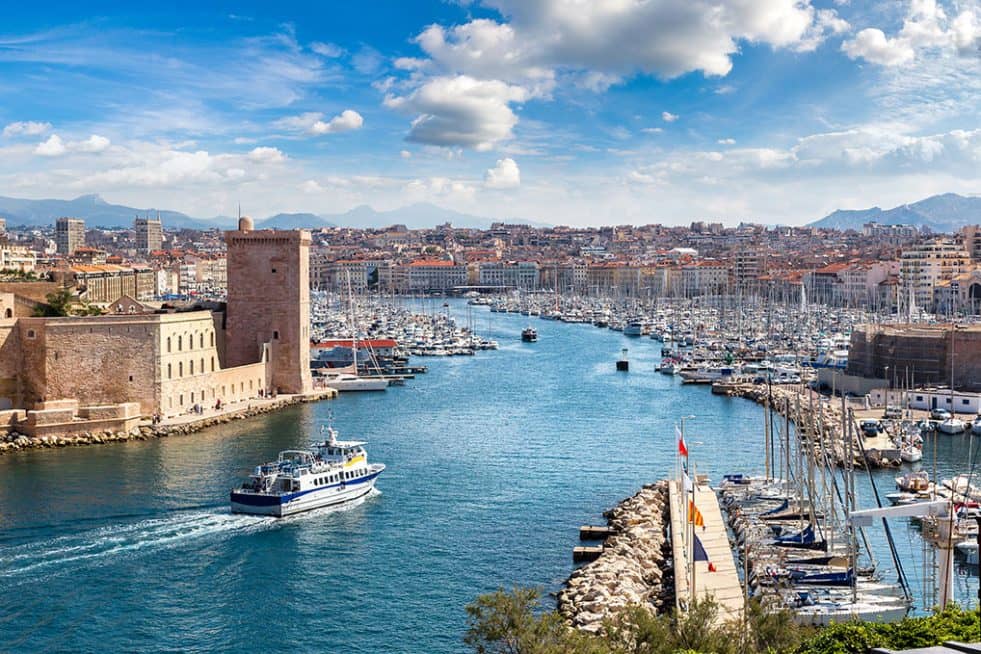
Marseille Travel Guide
Are you planning to visit France without a trip to the city of Marseilles? You might want to check this Marseille Travel Guide and include this breathtaking port city in your itinerary. With a busy harbor and vibrant urban vibe, Marseille emits an irresistible appeal to tourists from all over the world; that is what you might need to feed your travel inclination. Being the country’s oldest city and trailing Paris as the second largest, Marseilles has lots to offer from history and arts to sumptuous cuisines to peachy beaches.
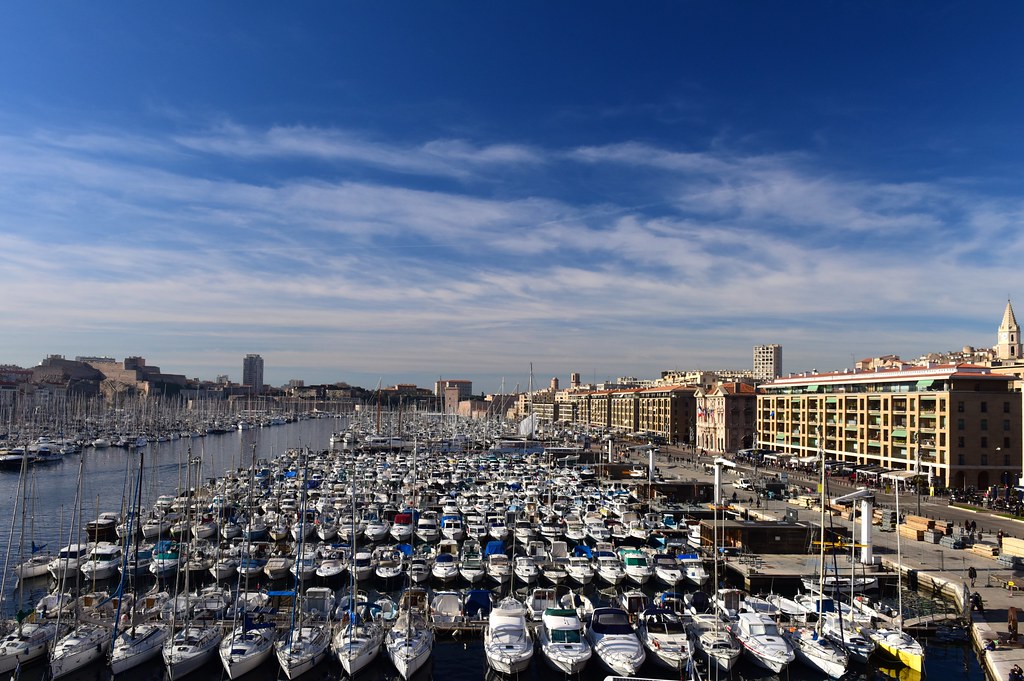
Specially poised, its gorgeous seaside scenery is strikingly beautiful. Whether strolling in an old street or feeling the refreshing breeze that is always imposing, visitors are close to the tranquil blue waters everywhere in the city. Marseille is a culturally diverse and colorful city with a multiethnic heritage soul. Therefore, you will have the chance to experience not French culture alone but a potpourri of cultures. Its sizeable community of North Africans lends credence to this. I hope this Marseille Travel Blog will help you make the most out of your trip.
Here Are Some Marseille Travel Tips for a Fascinating Travel Experience:
Basilique notre-dame de la garde.
Situated in a breathtaking top location, this humongous church stands on the peak of Marseille as its most prominent landmark. From almost anywhere throughout the city, you can see the church’s structure resting where it is. It used to be an observation point in ancient times, and it also housed a pilgrimage chapel. The Basilique Notre-Dame de la Garde today is a beacon for the faithful, with an incredible glided Madonna crowning the belfry.
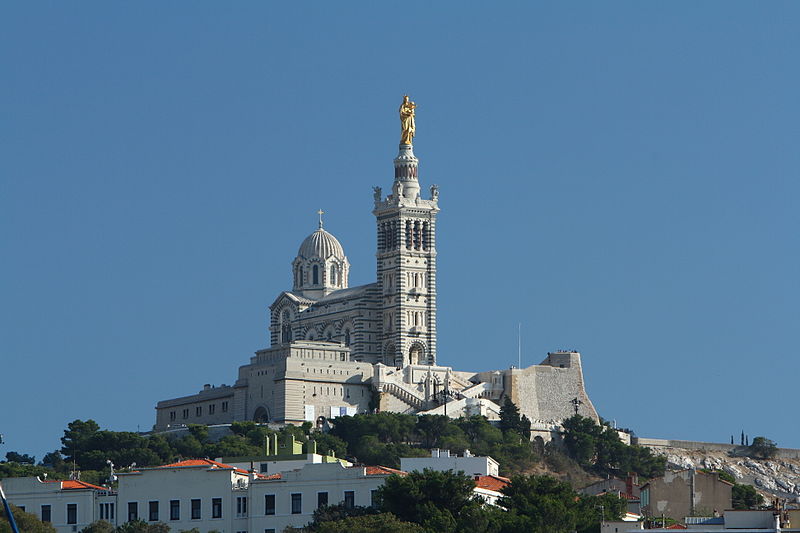
It was built between 1853-1864, lavishly styled with Neo-Byzantine interior of light and dark marble arches that support glided mosaic cupolas. In its crypt, you will find votive tablets and model aircraft given by aviators. After viewing the magnificence of the interior, visitors can also spend some time on the fantabulous terrace. The panorama extends from the red tops of Marseille’s buildings and the harbor to the Frioul Islands in the Mediterranean Sea; thereby offering a splendid view.
>>Also Read: Must-See Cathedrals in France
Witness History at The Vieux Port (Old Harbor)
The Vieux Port is the symbol of Marseille’s origin. It is where the city started off as a Greek port around 600BC. Circumvented by calm, serene blue waters, the Old Port is situated in the West of Marseille near the Canebière Boulevard. A walk around this old harbor will give visitors a rare feel for the city’s lively Mediterranean atmosphere.
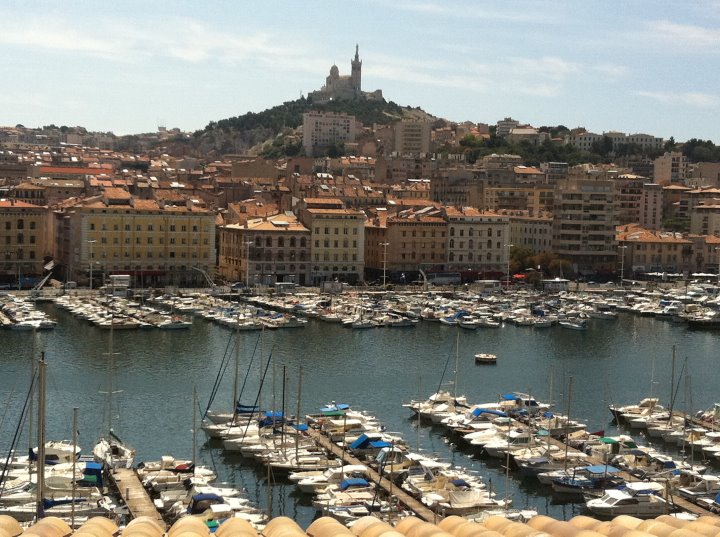
The thriving waterfront is also regarded as the main attraction for visitors, and as many say, this area is the best place to find bouillabaisse. That is a flavorful seafood stew that is all a specialty of Marseille. Quai des Belges, on the east side of the harbor, hosts a fish market every morning. Used to be a major commercial port, today Vieux Port is majorly used by sports craft and fishing boats. And if Château d’If and the Calanques near Cassis are on your itinerary, the Old Port is a perfect launching point for ferries to sail to.
>> Day Trips From Marseille
Hear the Heartbeat of Le Panier (Old Town)
Brilliantly positioned on a hillside atop the Vieux Port is the Old Town. This lively neighborhood is often referred to as the historic center and cultural heart of Marseille. Inhabited since the Greeks settled there in 600BC, Le Panier is the city’s oldest quarter. With its steep, narrow winding streets and quaint pastel buildings, this quarter gives a peep into the enticing character of Marseille.
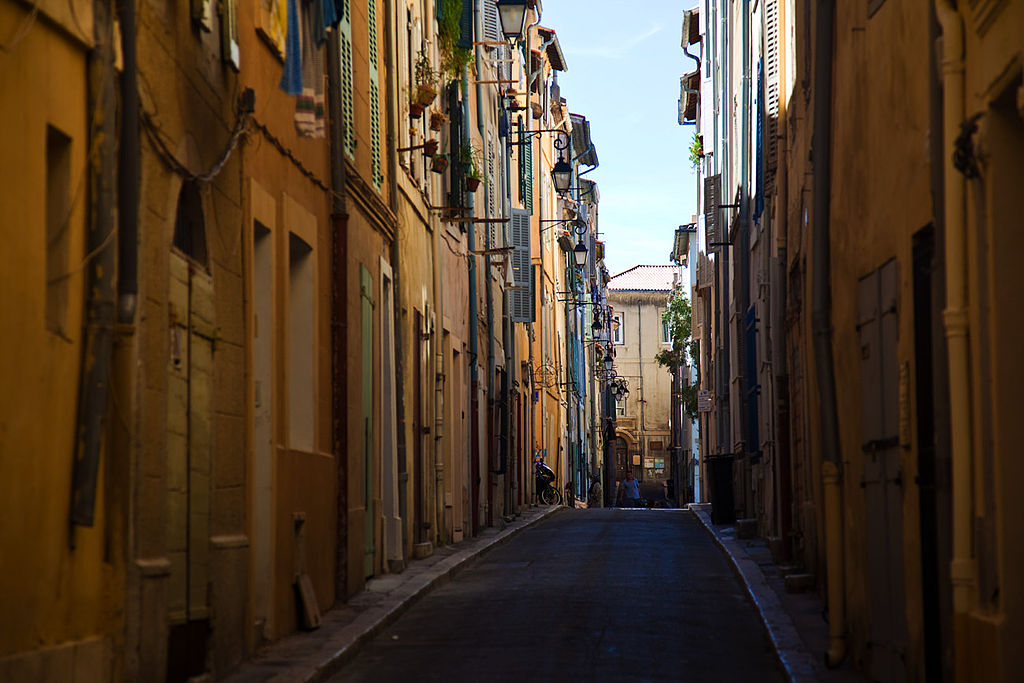
It used to be a working-class area but gentrified now. However, it still preserves many of its unique Algerian cuisine, art galleries, local artisan boutiques, and gourmet food shops. As a thriving residential area, its typical houses have shuttered window and lines of laundry that suggests family abode. Visitors to the Old Town can begin a walking tour on the north side of the Vieux Port harbor basin at the Quai du Port and then proceed to the La Canebiere, a bright and active boulevard. You will see several famous monuments like the Genoese-inspired Hôtel de Ville (Town Hall), which was built in the second half of the 17th century. Other landmarks worth seeing are Cathédrale de la Major and the Vieille Charité which boasts of a museum with exquisite modern artworks.
>> Most Famous Monuments in France >> Hotels Near Vieux Port in Marseille >> How To Get From Paris To Marseille

Appreciate Nature at the Calanques National Park
The city’s southern and eastern suburbs are located in an area of amazing natural beauty. The Calanques are rocky white limestone cliffs and creeks that reach astonishing heights and descends sharply to the sea. Whether by land or sea, nature lovers would adore this national park for its unique natural compositions and craggy elegance.
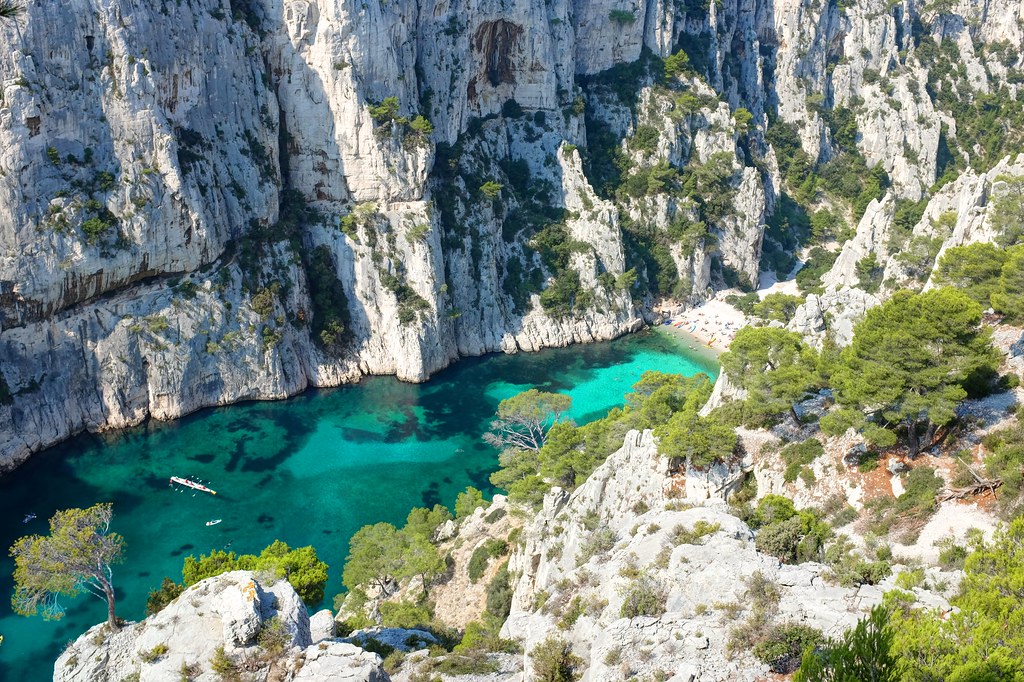
You can hike as well, and if you do, you might need a courage spirit, as the GR 98 from Marseille to Cassis usually takes about 11 hours as it leads you into some tough country. However, the captivating scenery evens up for the toil. Also, some mini-cruises leaves from the old port and guided kayaking adventures. Sounds very much like fun, doesn’t it?
Admire the Stade Vélodrome
Marseille locals and Olympique de Marseille, the city’s major football club, are two inseparable lovers. Make a stop at the city’s football spiritual home, the sublime Stade Vélodrome. Designed by Henri Ploquin in 1937, the stadium has a 67,000-plus capacity. And even before the extensive renovation, it underwent in the build-up to Euro 2016 football tournament, Stade Vélodrome is one of the most gripping football cathedrals in world football.

It is the largest football stadium in France and is protected from the fierce Mistral wind by a huge moving roof. Although a city icon, the stadium has endured cruel treatments from the city and Olympique de Marseille’s fans. You will learn all you need to know the stadium on an hour-long tour. You will also be seeing the dressing rooms, the terraces’ peak, and the pitch-side.
>> Areas To Avoid In Marseille
Stop for a Delicious Bouillabaisse Experience
Add taste to your tours as you indulge Marseille’s very own bouillabaisse. It is a fish and seafood stew that is usually made with lean fish and have little market value but are better when cooked down, like scorpionfish, conger and sea robins. These are stewed with wine, saffron, and olive oil, although the remainder of the recipe varies from one restaurant to another.

A common feature of this dish is rustic bread smothered with rouille- a type of attractive mayonnaise and immersed in the soup. Bouillabaisse goes best with white wines from the Rhône Valley or Languedoc-Roussillon. And to wrap it up, you can go the French way as you take navettes, cute boast-shaped biscuits in a variety of flavors, from anis to chocolate.
Marseille Hotels
Golden tulip villa massalia.
Located at Place Louis Bonnefon, the Golden Tulip Villa Massalia is a high-standing hotel five minutes from the Prado beach. The hotel offers many luxury services to visitors, to make their stay a momentous one. You can enjoy the outdoor swimming pool, or the oriental spa Le Siwa, which offers massages and beauty cares with natural oils, a sauna, a fitness room, a Jacuzzi, and a hammam.
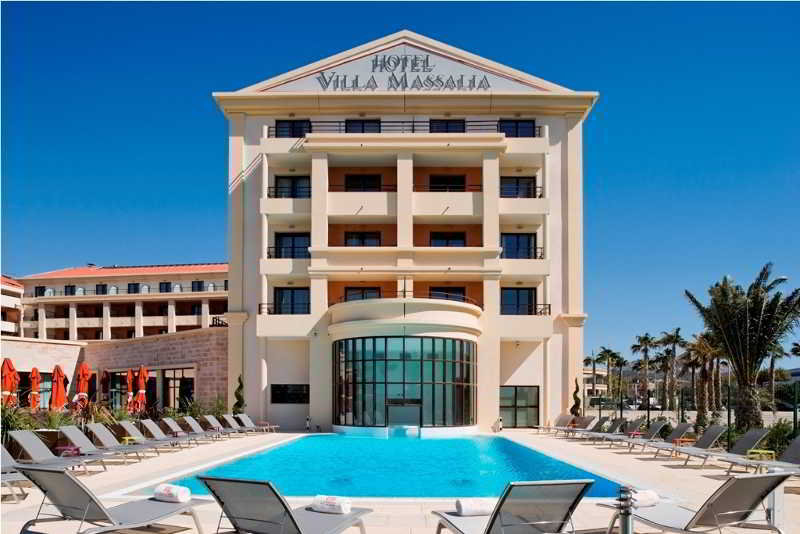
The Golden Tulip also has a brilliant array of gastronomic options. For example, the Yin-Yang restaurant has Mediterranean foods with a view from the terrace overlooking Borély Park, and the Asian bar Chang’An offers cocktails and snacks. In addition, the rooms come with air conditioners, free Wi-Fi and a television. Though not available to every room, on request, you can book a room with a balcony or terrace that has a great view of the sea.
Les Chambres de Jeannette
Situated in the 9th district of the city, and ten minutes away from the Stade Velodrome stadium, Les Chambres de Jeannette offers you home away from you. It welcomes visitors with the hospitality and spontaneity of a guesthouse. Sainte-Marguerite Dromel metro stations are also 200 meters away and give you access to the heart of the city and the Vieux Port in a timely fashion.
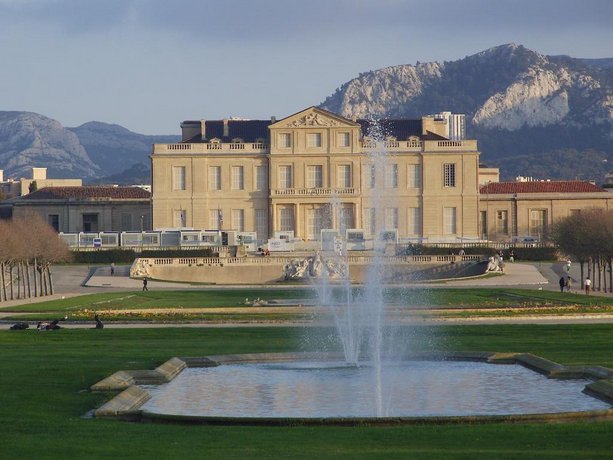
In this hotel, all the rooms come with a soundproof system and the internet is free. Other features are; a television, a private bathroom, and aircon, with a design and modern décor. Some do have a living room as well. The customer experience here is topnotch. As a plus, the hotel’s staff knows the city incredibly well. Hence, they will not hesitate to help if you need it.
The Ryad Boutique Hotel
Looking to change the environment or just in need of premium luxury, Ryad Boutique hotel is the place to be. Located in the first district of Marseille, it is only 10 minutes’ walk away from the Saint Charles railways satiation. This is a Moroccan hotel in every sense of the word: from its interior décor to its restaurant’s menu. The restaurant is usually opened from Thursday to Saturday, and they serve mint tea, fruit juices, and delicacies every day.
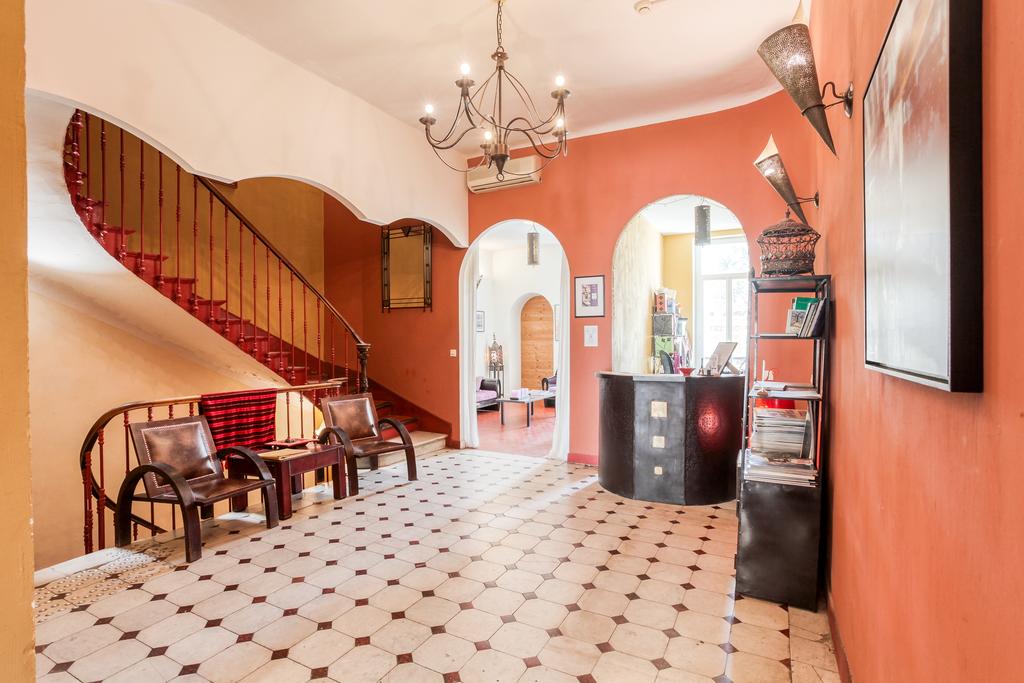
Ryad boutique hotel’s rooms have a unique way to impress visitors with their decorations. The rooms are with air conditioners and a private bathroom. For the bon vivant, they can dine and have a swell time in the hotel’s garden- where nature meets pleasure.
Marseille Beaches
Do relax at beaches in the city which all offer pleasant Mediterranean weather, closeness to the allure of the old port, and a variety of pebbly or sandy beaches. And while other beaches at the French Riviera have more charm than the ones at Marseille, the city’s own is well worth a morning or afternoon of sunbathing or swimming and diving.

>> Things To Do In Marseille
Below Are Some Of The Best Beaches In Marseille
Plage du prado.
Plage du Prado enjoy the titles of the most popular and the main beach in Marseille. You can take a bus or taxi from the central part of Marseille to convey you to this beautiful and exciting beach. Accommodation ad relaxation is common themes here as you will find bars and restaurants close to the beach. More so, its attention-grabbing credentials won the beach the 2008 FIFA Beach Soccer World Cup hosting right. Major sports events in beach volleyball, football, and other sports have all been hosted on Plage du Prado’s sandy areas in recent times.
Plage Escale Borely
This somewhat pebbly beach south of downtown Marseille in to perfect for lounging around the sand. However, it is the place to visit for windsurfing during summer and surfing during winter. During winter there are usually lovely waves, but there is a lot of competition to catch them. By going there on a weekday, you avoid the crowds who might want the waves too. Showers, restaurants are among amenities in place at Plage Escale Borely.
Plage de la Pointe Rouge
Plage de la Pointe Rouge is one of Marseille’s beautiful sand beaches located in the south of the city. Blessed with a stunning ocean view, it is an idyllic destination for families and children. Here the sand is soft and comfortable as the ocean floor shelves downwards, making the water shallow and warm. In summer, Plage de la Pointe Rouge tends to be full of people as restaurants and food stands are all around the beach. During such times, it is difficult to find a parking space. For lovers of kite-surfing, they can rent a paddle-boat to get on the water. Safety is paramount here; it is why you will see lifeguards around.
Plage des Catalans
This is another beach you will love to visit. It is the closest beach to the Old Port of Marseille, and famous for its convenience. Though close to the buildings of the town, the sand is pleasant. You will find a beach volleyball court, showers, and lifeguards, and restaurants by the roadside. Granted the view is probably not the best of Marseille’s beaches because it is surrounded by roads and buildings. However, you can look out on the ocean and swim in the clear blue waters.
>> Best Beaches in France >> Beaches On The French Mediterranean >> Best Nudist Beaches in France
Marseille Travel Blog – Conclusion
Marseille is the second-largest city in France and is located on the Mediterranean Sea in the province of Provence. It is 771km (479 miles) south of Paris; 187km (116 miles) southwest of Nice and 31km (19 miles) south of Aix-en-Provence. It is one of the most important cities because it is the largest commercial port in France. Marseille is the capital of the Provence-Alpes-Côte d’Azur région and is surrounded by many historical buildings. Despite this, Marseille is a modern city with charming beaches and shopping centers.
Marseille was known as Phocee; this was because of its founders, the Phoceans. The city then became a commercial port having the famous ‘Savon de Marseille’ as one of its products. It also became important as a crossroad for many ships in the Mediterranean.
This is a very elegant city, and now that can easily visit from Paris, it is much more accessible for visitors. As it has always been one of the main points of entry to France, Marseille has attracted many immigrants -mainly from North Africa-, making it into a multicultural melting pot. Marseille has some problems in the past with corruption, the Mafia, crime, racial discrimination, and unemployment, mostly in the poorer, immigrant neighborhoods. Nowadays, though, the city is in a renaissance period and is now one of the most visited cities in France.
Marseille is definitely a city worth visiting. It offers some outstanding architectural pieces, unique cuisine and one of the oldest ports in Europe that you can enjoy. Do not forget to put Marseille in your itinerary for at 2-3 days. There are also a lot of activities you can participate in not available in any other part of France.
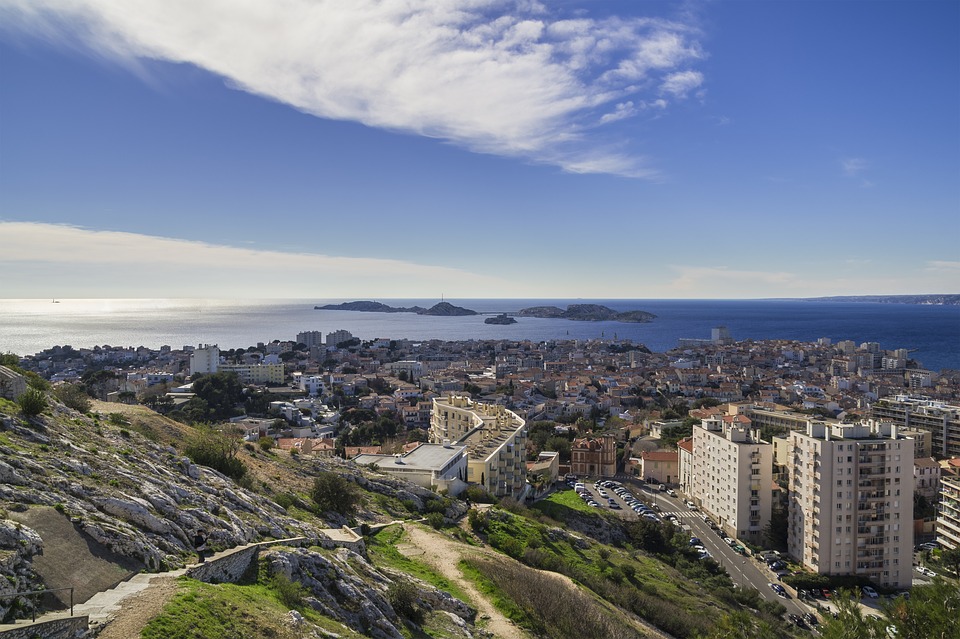
Do you have anything else to add in this Marseille Travel Guide? Leave your comments down below!
Peter is the editor of France Travel Blog. He has traveled to France many times and is ready to share the knowledge in this travel guide for France.
Related Posts
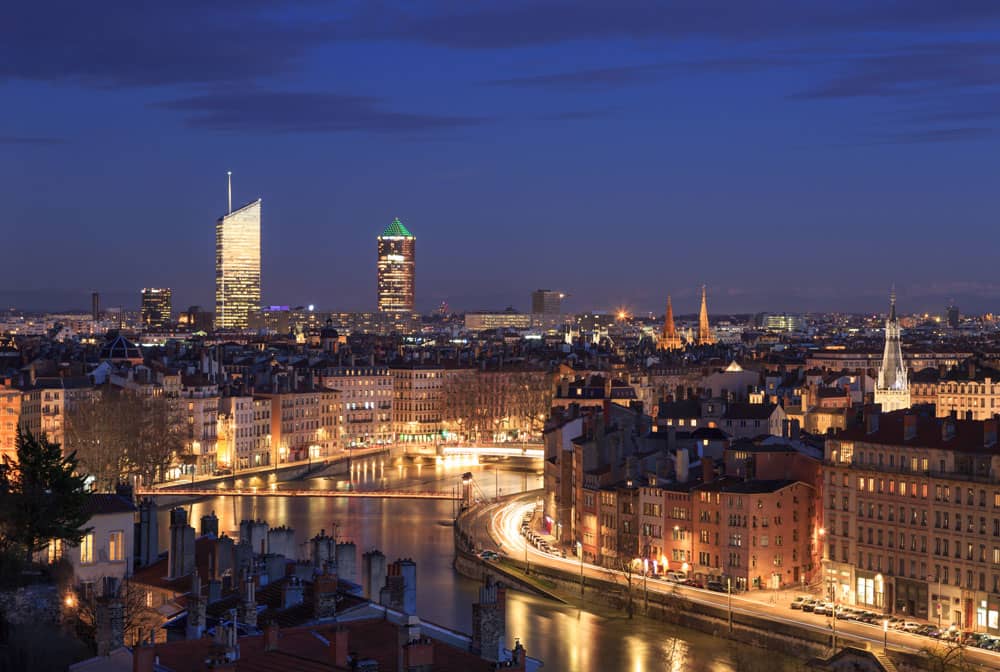
Lyon Travel Guide

Gordes Travel Guide: Tips for Visiting Gordes
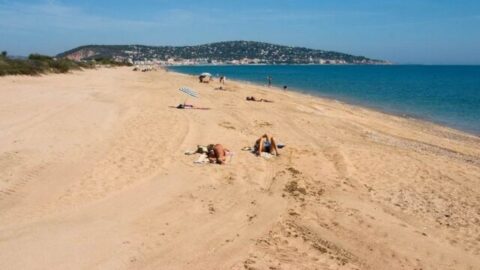
Best Beaches near Sete

10 Places To Visit On Your Next Europe Travel
Recent posts.
- Get Amazing Hotel in New York – Your Guide to Exclusive Deals
- The Gorges du Verdon: A Scenic Road Trip In Southern France
- Marseille Unveiled: Immerse Yourself in the Charm of the Mediterranean with a Captivating City Break
- A Beginner’s Guide to Road Cycling
- 5 Things to Look for When Buying Digital Cameras
- Entertainment
- Things To Do
- Travel Guides
- Travel Ideas
Social Links
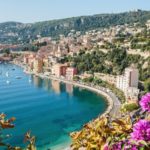
Nice Travel Guide

Not Sure What To Pack For Your Upcoming Trip? This Checklist Can Help

Montmartre Neighborhood Guide in Paris

Most Beautiful Coastal Villages in France

Visa Requirements to Travel to France from Ukraine
Hit enter to search or ESC to close.

Marseille Travel Guide
Last Updated: August 9, 2023
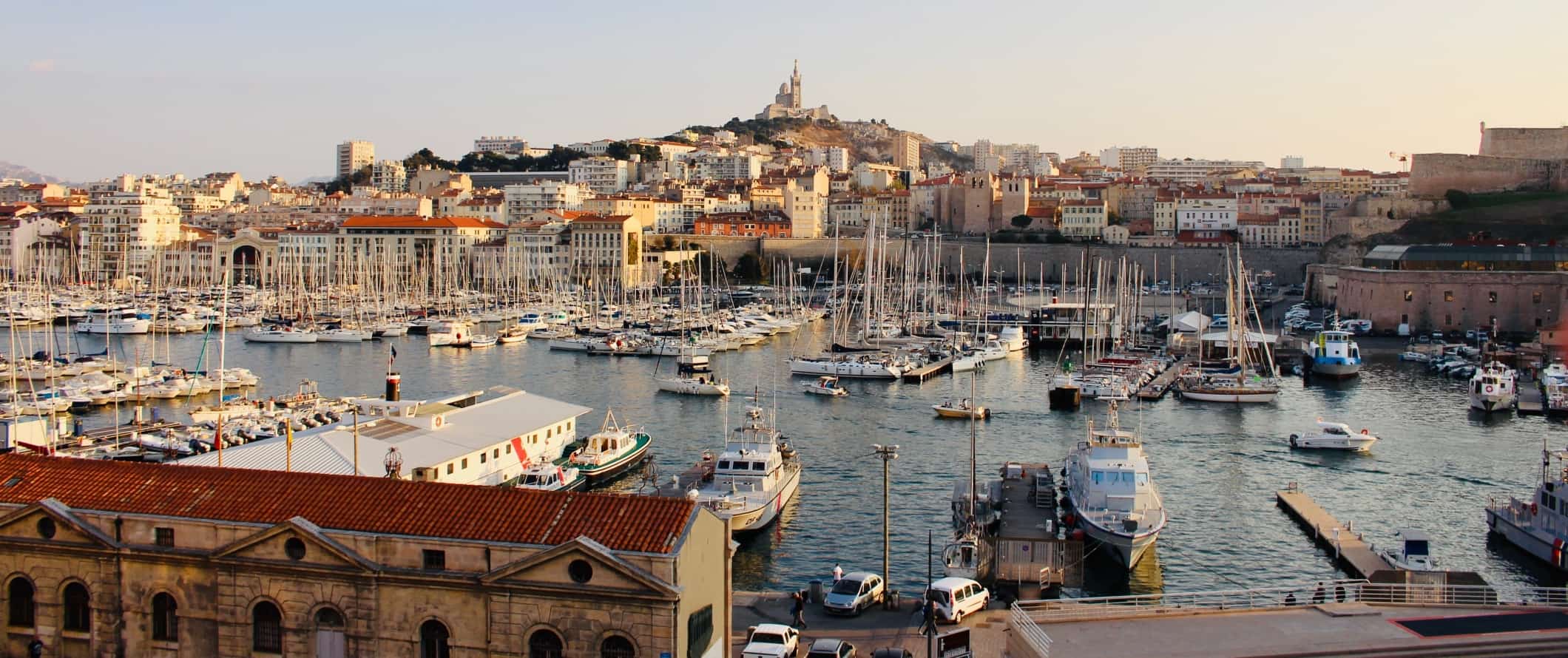
Located in southeastern France, Marseille is France’s second-largest city. Founded around 600 BCE as a Greek port city, Marseille is a maritime hub and one of the most diverse cities in all of France. It’s also the oldest city in the country.
Modern Marseille is filled with nightlife, enticing restaurants, theaters, museums, and even an international soccer stadium. The city was chosen to be the European Capital of Culture in 2013 and, after Paris, has the most museums in the country. Marseille lacks the iconic beauty of Paris but, while the city is a bit gritty, I think the beautiful waterfront and historic buildings give it a unique vibe. It’s worth at least two nights here.
This travel guide to Marseille can help you plan your trip, save money, and make the most of your visit!
Table of Contents
- Things to See and Do
- Typical Costs
- Suggested Budget
- Money-Saving Tips
- Where to Stay
- How to Get Around
- How to Stay Safe
- Best Places to Book Your Trip
- Related Blogs on Marseille
Top 5 Things to See and Do in Marseille
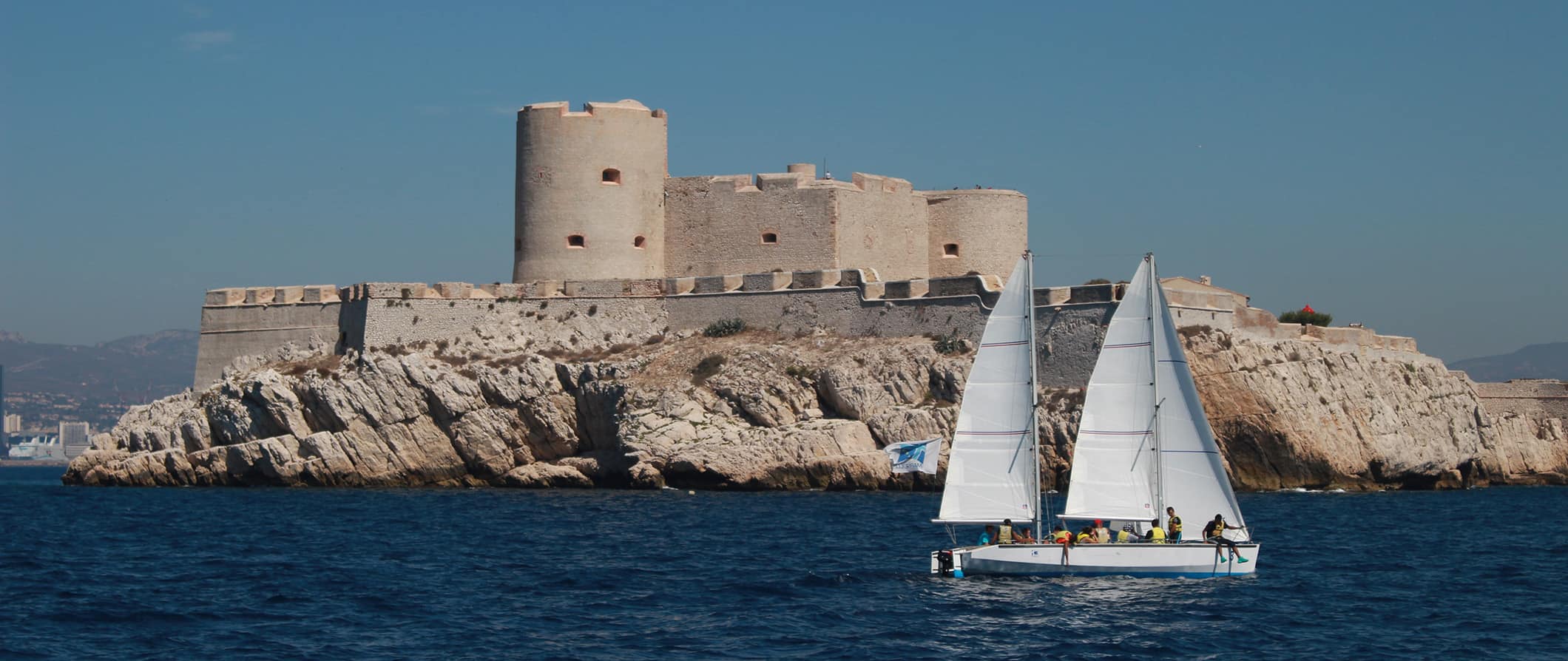
1. Visit Le Vieux Port
The Old Port of Marseille is ideal for watching fishermen sell their fresh seafood. You can also hire a boat for the day here. For a relaxed visit, simply sit, read a book, eat, and gaze at all the expensive yachts in the harbor.
2. See the Notre Dame de la Garde
Known as “the big church,” this Byzantine and Romanesque Revival basilica sits at the highest point overlooking the city, making for one of the best views of Marseille. Old fishermen used to have their boats blessed in this church. Entrance is free but dress respectfully.
3. See the Vieille Charite
Home to the Museum of Mediterranean Archaeology and Museum of African, Oceanian, Amerindian Arts, Vieille Charite is a former almshouse built in the mid-17th century. Its architecture consists of an impressive three-floor corridor on a rectangular courtyard, with a domed Italian Baroque chapel in the center.
4. Walk La Corniche
This striking seaside walkway winds along the coast for 5 kilometers (3 miles), offering lovely scenic views over the sea, as well as Chateau d’If and Les Calanques (a steep-walled inlet made of limestone and dolomite) to the east. It’s a good way to spend a few hours!
5. Admire Château d’If
Other things to see and do in marseille, 1. roam around le cours julien and la plaine.
This trendy part of Marseille is full of bookstores, cafes, vintage clothing stores, fountains, and colorful street art. Every Thursday and Saturday morning, La Plaine market takes place here, offering the opportunity to shop for everything from clothing and knick-knacks to shoes and delicious food. Treat yourself to dinner at Lacaille or opt for tapas at Le Couz’in.
2. Relax in Borély Park
Borély Park is known as one of the most remarkable parks in France and its captivating gardens are a highlight of visiting Marseille. Located near the ocean, this park was created in the 17th century by French merchant Joseph Borléy. You can wander the flowing English garden, the perfectly manicured French garden, and a Zen garden. Borély Park is also home to Château Borély, an 18th-century country home that now houses the Museum of Decorative Arts, Earthenware and Fashion. Admission is free.
3. Visit Le Panier
This is the oldest area of Marseille, dating back to around 600 BCE. In French, its name means “the basket” and was named for an inn that had a basket as a sign. In time, the hilltop neighborhood became known by the same name. Today, Le Panier is known as an artistic hub, with colorful street art adorning the buildings and artist studios dotting the neighborhood. Be sure to visit the Vieille Charité, a 17th-Century villa that has museums and exhibitions.
4. Go to La Place Castellane
This historic roundabout in the 6th arrondissement was built in 1774 and contains a magnificent fountain (the current fountain was added in 1913 to replace the original). The fountain represents the three Provençal rivers (Durance, Gardon, and Rhône). An obelisk was originally part of the fountain, but it was relocated in 1911 to the 9th arrondissement. The square is named after the aristocrat who funded the project, Henri-César de Castellane-Majastre, and was mentioned in Joseph Conrad’s 1919 novel The Arrow of Gold (Conrad also wrote the famous novel Heart of Darkness ).
5. Wander the Mazargues War Cemetery
Over 9,000 square meters, Mazargues War Cemetery is the final resting place of allied soldiers from World War I and World War II. The bodies of soldiers and laborers were buried in various cemeteries in Marseille during WWI, however, after the war and before Armistice, the grounds of Mazargues Cemetery were expended and the remains of hundreds of soldiers were moved from the smaller cemeteries and laid to rest here. It is located about 6 km (3.5 miles) from central Marseille.
6. Visit the Palais de Longchamp
This monument opened in 1869 and celebrates the completion of the Durance canal, which brought fresh potable water into Marseille. The famous animal sculptor Antoine Louis Barye made the lions and tigers at the entrance, while the monumental fountain in the middle of the colonnade is by Jules Cavelier. It also hosts the Musée des Beaux-Arts, Marseille’s oldest museum, with its large collection of 16th-19th century Provencal and Italian artwork. Admission is free.
7. Eat in Noailles
This area of the city (around the Noailles subway station) is known for its Arab, Indian, and Chinese communities. It’s filled with delicious places to eat for. Try places like Les Portes de Damas, Caffé Noir, and Le 5.5 karaoke bar. There is also daily market where vendors sell North African specialties including spices, dried fruit, sticky pastries, flatbreads, and more.
8. Go diving
Diving may not be the first thing that comes to mind when you think of France, but Marseille is making a name for itself as the country’s diving capital. Take a trip out into the Mediterranean, where you can explore tunnels, caves, and admire colorful sea sponges, anemones, and sea fans. You can also spot moray eels and octopus as well as numerous of shipwrecks, such as Le Liban (1882) and Le Chaouen (1961). June to October, when the water is a bit warmer, are the best months for diving here. Prices start at 100 EUR.
9. Go on a Food Tour
Explore the historic district of Marseille on a 3.5-hour walking food tour. Food tours can be a fun way to learn about the history and culture of the city, while sampling regional foods such as tuna and shrimp tartare, tapenade, panisse, and roasted Camembert. Tours with Do Eat Better Tours start at 85 EUR.
10. Tour the Museum of Civilizations of Europe and the Mediterranean (MuCEM)
Inaugurated in 2013, this museum is located next to Fort St. Jean towards the entrance of the harbor. Designed by French architects Rudy Ricciotti and Roland Carta, the museum is a 15,000 square meter cube surrounded by a latticework of fiber and concrete. The museum features two levels of exhibits devoted to Mediterranean and European history, as well as an underground auditorium, and bookshop. The restaurant on the top of the museum offers one of the best viewpoints in the city. Tickets are 11 EUR, but you can walk around the exterior for free.
11. Go on a Wine Tour
When visiting Marseille, it is hard to pass up an opportunity to go on a wine tour. This is, after all, Provence. You can choose from half-day or full-day tours. Provence Wine Tours offers a full-day tour around Aix-en-Provence for 110 EUR, lunch not included. They also offer half-day tours for 70 EUR.
For more information on other cities in France, check out these guides:
Marseille Travel Costs
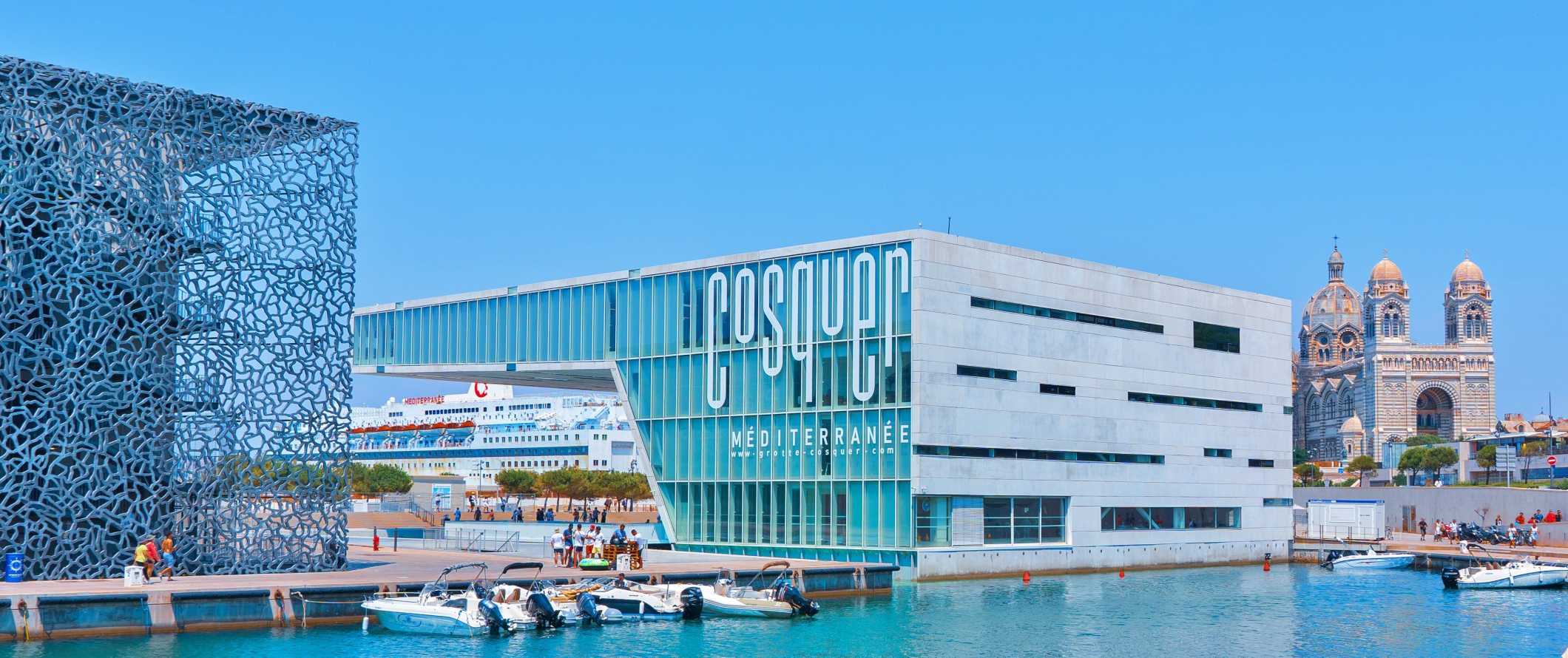
Hostel prices – A dorm with 4-6-beds costs 25-32 EUR per night. Private rooms start at 70 EUR. Free Wi-Fi is standard but no hostels in the city have self-catering facilities or include breakfast.
For those traveling with a tent, camping is available outside the city for 17 EUR per night for a basic plot without electricity.
Budget hotel prices – A budget hotel room with basic amenities like free Wi-Fi and AC costs around 65 EUR per night.
On Airbnb, private rooms cost about 40 EUR, while full apartments start at 65 EUR per night but average double that if you don’t book early).
Food – Food in France has a long history and is intricately intertwined with the culture at large. Fresh bread, tasty local cheeses, and plentiful wine may be stereotypical staples of the cuisine, but they really are some of the go-to foods in the country. Wine is especially popular in this region, as are olives and fresh olive oil. Seafood, lamb, sausage, and goat cheese are all especially popular here as well.
Marseille boasts plenty of traditional French restaurants, as well as numerous African, Corsican, and Mediterranean restaurants. Cheap sandwiches like falafel or a kebab cost about 5 EUR. Most lunch specials cost around 10 EUR for a meal.
In Vieux-Port, CopperBay Marseille is a cocktail bar that offers small plates such as pickled mussels, burrata cheese, and other savory snacks. Dishes cost around 9-13 EUR and cocktails are 8-12 EUR.
Neighborhoods such as Opéra and Noailles are also home to delicious restaurants, bars, and cafés. Deep on rue Giandeves, in Opéra, is probably one of the best coffee shops in the city.
A main dinner dish costs around 15-25 EUR, while a glass of wine costs 5-8 EUR. Expect to pay 10-13 EUR for a cocktail.
Fast food (think McDonald’s) costs around 9 EUR for a combo meal. Beer is 4-5 EUR while a latte or cappuccino is around 2.75 EUR.
If you’re cooking for yourself, expect to spend around 50 EUR per week on groceries. This gets you basic staples like pasta, rice, seasonal produce, and some meat or seafood.
Backpacking Marseille Suggested Budgets
If you’re backpacking Marseille, my suggested budget is about 70 EUR per day. This budget covers staying in a hostel dorm, cooking all of your meals, using public transportation to get around, limiting your drinking, and sticking to mostly free and cheap activities like free walking tours and enjoying nature.
A mid-range budget of about 145 EUR per day covers a private Airbnb room, eating at cheap restaurants for a few meals, enjoying a few glasses of wine, taking an occasional Uber to get around, and a couple of paid activities such as diving and visiting some museums.
On a “luxury” budget of 290 EUR or more per day, you can stay in a hotel, eat out for all your meals, drink more, take more taxis or rent a car, and do whatever yours and activities you want (including wine tours). This is just the ground floor for luxury though. The sky is the limit!
You can use the chart below to get an idea of how much you need to budget daily. Keep in mind these are daily averages – some days you’ll spend more, some days you’ll spend less (you might spend less every day). We just want to give you a general idea of how to make your budget. Prices are in EUR.
Marseille Travel Guide: Money-Saving Tips
Marseille is built for the luxury traveler and there’s not a lot of cheap things to do here. However, if you want to lower your costs, here are some ways to save money in Marseille:
- Explore on foot – Marseille is small enough to walk around and it’s a great way to experience the architecture and the vibes of the city without spending any money.
- Get the set lunch menu – If you eat out, do so at lunch and get the prix fixe menu (two- or three-course set menu). Restaurants throughout town offer this set menu during lunch, and with prices between 10-20 EUR, it’s a way better deal than the regular dinner menu.
- Get discount museum prices – Pick up a City Pass for free public transportation, free entry to museums and attractions, and discounts on tours. A one-day pass is 27 EUR, a two-day pass costs 37 EUR and a three-day pass costs 43 EUR.
- Take a free walking tour – If you want to learn more about the city, a free walking tour is a great place to start. You’ll learn about the history and architecture while getting to see all the major sights. Marseille Free Walking Tour is the best one. Just be sure to tip at the end!
- Stay with a local – If you want to save money and get some local insight into the city, use Couchsurfing. Staying with a local is the best way to get a feel for the city and learn some insider tips.
- Save money on rideshares – Uber is cheaper than taxis and is the best way to get around a city if you don’t want to wait for a bus or pay for a taxi.
- Bring a water bottle – The tap water here is safe to drink so bring a reusable water bottle to save money and reduce your plastic use. LifeStraw is my go-to brand as their bottles have built-in filters to ensure your water is always clean and safe.
Where to Stay in Marseille
There are only a few hostels and budget hotels in Marseille. Here are my recommended places to stay in Marseille:
- Vertigo Vieux-Port
- Pitchounette & Olives
- Pension Edelweiss
- The People Hostel
How to Get Around Marseille
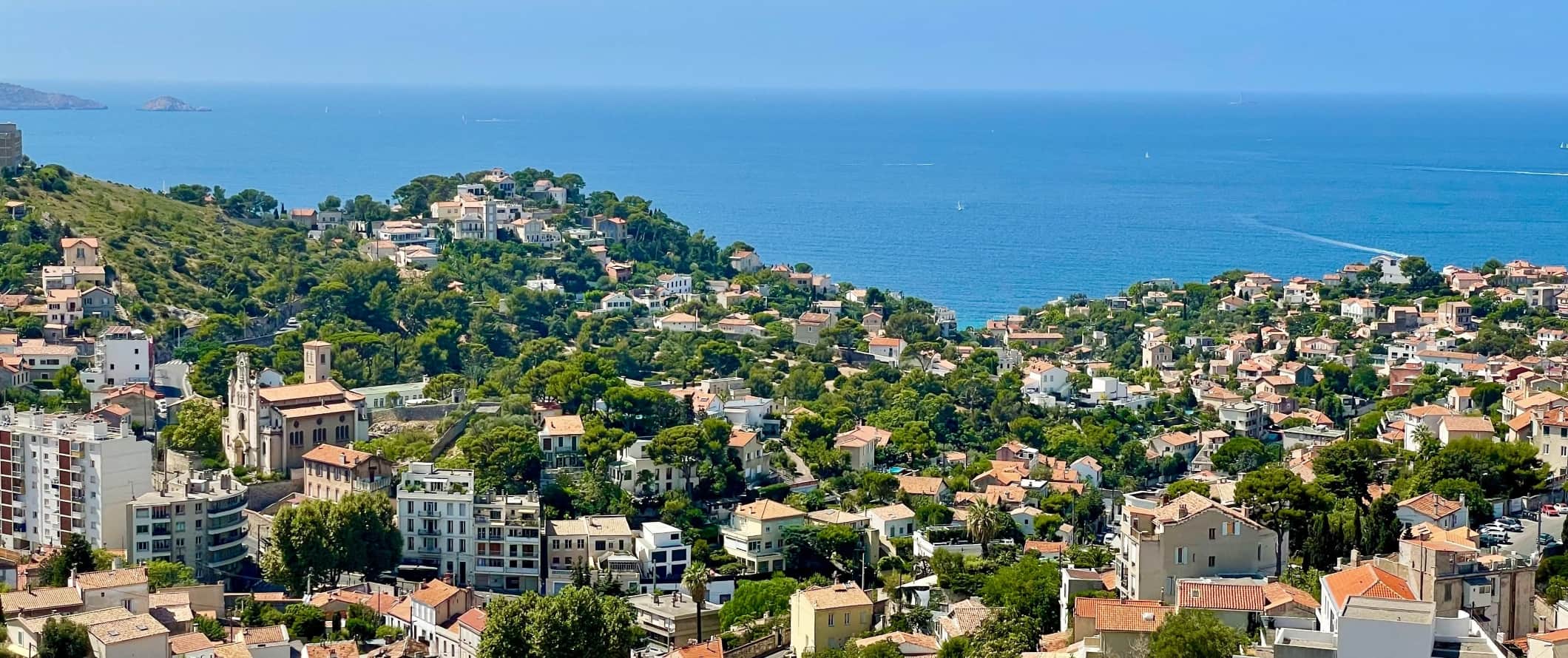
Public transportation – Tickets for the bus and the metro can be bought in metro stations, at tourist offices, or anywhere displaying the RTM sign. It’s best to buy groups of tickets at 3.40 EUR (2 trips) or 15 EUR (10 trips) to save a bit (prices on board the bus cost 2 EUR per trip). A day pass costs 5.20 EUR, a 3-day pass costs 10.80 EUR, and a 7-day pass costs 15.50 EUR.
Most public transportation in the city center stops running regularly around 9pm, so consider taking an Uber or a taxi if you’re in a hurry. There are, however, a couple of night buses that run through central Marseilles. Consider downloading the RTM app for current public transportation schedules.
If you get a City Pass tourism card, you’ll be able to ride the public transit for free.
Ferry – RTM also operates a ferry service between Vieux-Port and Estaque or La Pointe Rouge. Ticket prices are 5 EUR one-way. You can also take a ferry across Vieux-Port for 0.50 EUR, one-way.
Bicycle – Le Vélo is a public bike-sharing system that lets you rent bicycles around the city once you register online. It costs 1 EUR to register, which gives you a 7-day pass. The first 30 minutes are free and it costs 1 EUR per hour after that.
Taxi – Taxis are expensive in Marseille, with a base rate of 2 EUR plus about 1.72 EUR per kilometer. This rate may increase in the evenings so skip the taxis if you can — they add up fast!
Ridesharing – Uber is available in Marseille and is generally cheaper than taxis. That said, the city is small so you shouldn’t really need to use it much.
When to Go to Marseille
Summer is the most popular time to visit Marseille. This is also the hottest time of the year, with temperatures daily highs reaching 30°C (86°F). Summer is peak season in Marseille, and the streets are filled with backpackers and European vacationers who want to soak up the ambiance of the south of France in all its hot glory.
September and October, when the average high temperature is 24°C (75°F), is an ideal time to visit Marseille. In autumn, the crowds lessen considerably and the Mediterranean is still perfect for swimming. The days are usually warm, but the nights can be cooler.
In spring, Carnaval de Marseille takes place (April) in Bolély Park, with colorful costumed floats, live music, games, and family entertainment. The temperature in spring averages around 18°C (65°F).
The Christmas season, although chilly, is an excellent time to explore the markets and festivities. The Santon Fair, one of the oldest fairs in Provence, takes place throughout the month of December and features hand-painted terracotta nativity figurines created by local artisans. The average temperature in winter is 10°C (50°F).
How to Stay Safe in Marseille
Marseille is very safe and the risk of violent crime here is very low. As in any destination, avoid walking through unfamiliar areas alone at night and beware of pickpocketing and petty theft. Pickpocketing is most common around the train station and tourist areas so always keep your belongings secure and out of reach.
Solo female travelers should feel safe here, though the standard precautions apply (never leave your drink unattended at the bar, never walk home alone intoxicated, etc.)
As with most major cities, there are neighborhoods to avoid. It’s a good idea to be extra cautious in neighborhoods like Quartiers Nord, Malpassé, Felix Payat, and Le Caillols where crime is a higher risk.
If you’re worried about getting scammed, you can read about this post on common travel scams to avoid.
If you experience an emergency, dial 112 for assistance.
Always trust your gut instinct. Avoid isolated areas at night and be aware of your surroundings at all times. Make copies of your personal documents, including your passport and ID.
The most important piece of advice I can offer is to purchase good travel insurance. Travel insurance will protect you against illness, injury, theft, and cancellations. It’s comprehensive protection in case anything goes wrong. I never go on a trip without it as I’ve had to use it many times in the past.
Marseille Travel Guide: The Best Booking Resources
These are my favorite companies to use when I travel. They consistently have the best deals, offer world-class customer service and great value, and overall, are better than their competitors. They are the companies I use the most and are always the starting point in my search for travel deals.
- Skyscanner – Skyscanner is my favorite flight search engine. They search small websites and budget airlines that larger search sites tend to miss. They are hands down the number one place to start.
- Hostelworld – This is the best hostel accommodation site out there with the largest inventory, best search interface, and widest availability.
- Booking.com – The best all around booking site that constantly provides the cheapest and lowest rates. They have the widest selection of budget accommodation. In all my tests, they’ve always had the cheapest rates out of all the booking websites.
- Get Your Guide – Get Your Guide is a huge online marketplace for tours and excursions. They have tons of tour options available in cities all around the world, including everything from cooking classes, walking tours, street art lessons, and more!
- SafetyWing – Safety Wing offers convenient and affordable plans tailored to digital nomads and long-term travelers. They have cheap monthly plans, great customer service, and an easy-to-use claims process that makes it perfect for those on the road.
- LifeStraw – My go-to company for reusable water bottles with built-in filters so you can ensure your drinking water is always clean and safe.
- Unbound Merino – They make lightweight, durable, easy-to-clean travel clothing.
- Top Travel Credit Cards – Points are the best way to cut down travel expenses. Here’s my favorite point earning credit cards so you can get free travel!
- BlaBlaCar – BlaBlaCar is a ridesharing website that lets you share rides with vetted local drivers by pitching in for gas. You simply request a seat, they approve, and off you go! It’s a cheaper and more interesting way to travel than by bus or train!
Marseille Travel Guide: Related Articles
Want more info? Check out all the articles I’ve written on backpacking/traveling France and continue planning your trip:
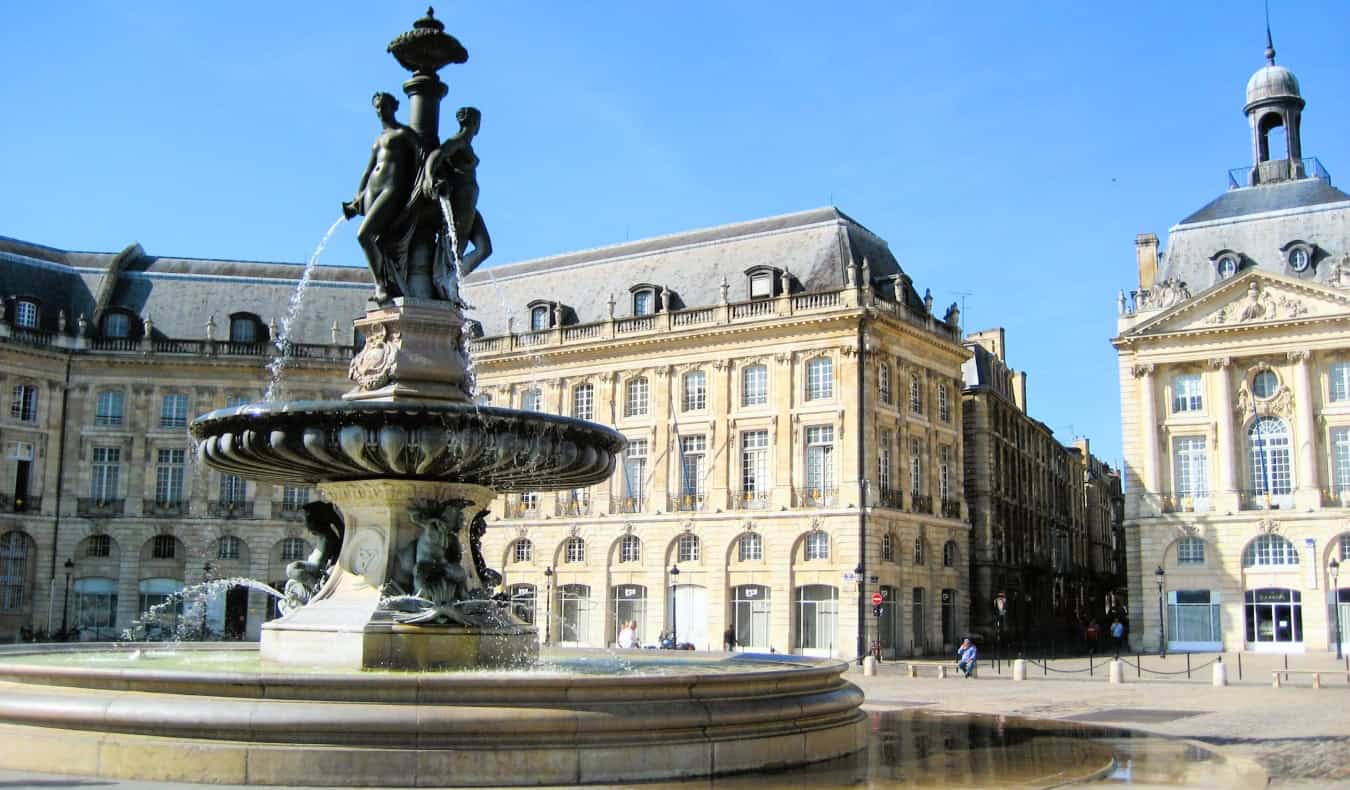
The Best Walking Tours in Bordeaux
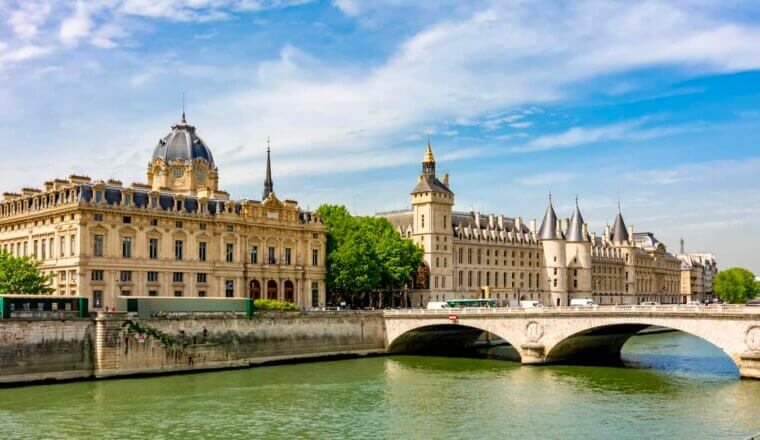
The 8 Best Hotels in Paris
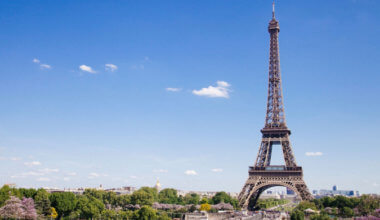
How to Spend 5 Days in Paris
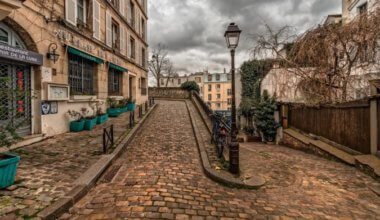
13 Off-the-Beaten-Path Things to See and Do in Paris
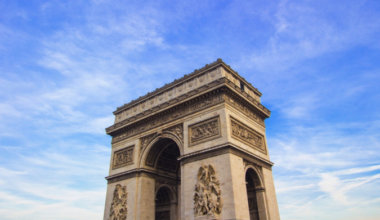
The Best Walking Tours in Paris

Life in Paris, Part 3: Nothing Lasts Forever
Get your free travel starter kit.
Enter your email and get planning cheatsheets including a step by step checklist, packing list, tips cheat sheet, and more so you can plan like a pro!

- Where To Stay
- Transportation
- Booking Resources
- Related Blogs

What to See in Marseille: A Three Day Itinerary of France’s Eclectic Port City
June 21, 2022 September 23, 2017 | Paroma
Wondering what to see in Marseille during in 72 hours? This port city of France is unlike any other place in the country that you’ll ever visit, thanks to a mish mash of North Africa meets Europe cultural influences. Read my 3 days in Marseille guide for the best things to do in Marseille in 72 hours!
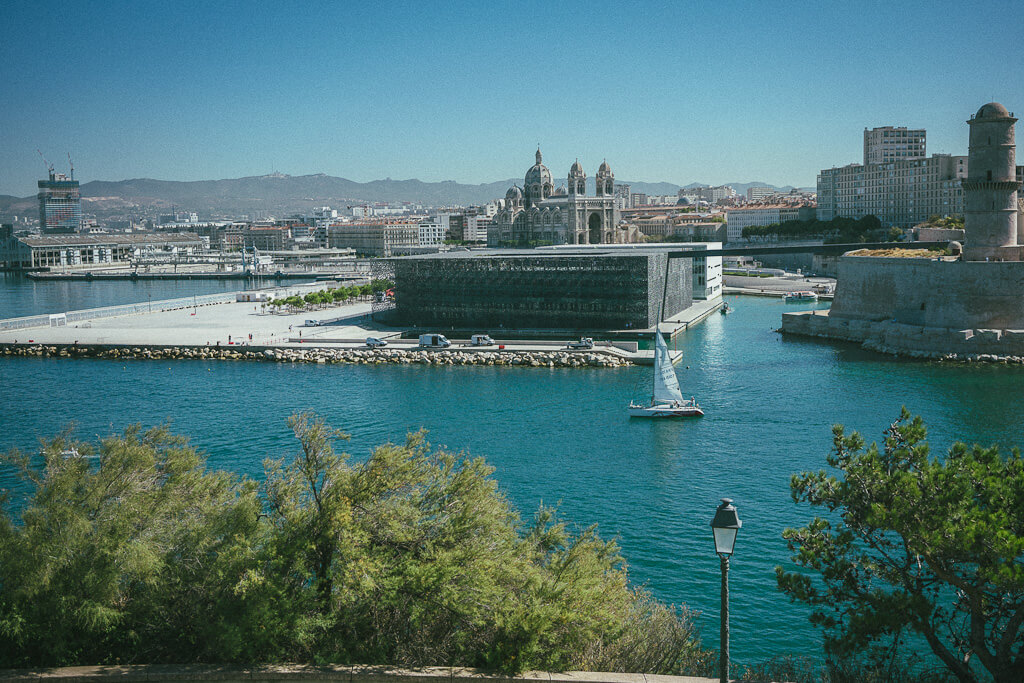
Disclaimer: This blog post may contains some affiliate links. Clicking on them to make a purchase may earn me a small commission at no extra cost to you for the product. Thank you!
WHY SPEND THREE DAYS IN MARSEILLE, FRANCE?
Marseille, France bears the vibrancy, hues and eclectic charm associated with a port city given the intermingling of colors, faiths and nations ferried across the Mediterranean for commerce and livelihood.
Beyond the dirt and grime that takes a life of its own in the orange haze of the settling Mediterranean sun, Marseille comes alive in a cacophony of French splattered with Arabic, public walls glowing in the light of dazzling murals and streets coming alive with the din and chatter of meals at roadside cafes.
We spend three beautiful days in Marseille exploring the city along with a short day trip to Cassis, another delightful Provencal village and home to the famous Calanques. As you scroll down this post, I will provide my “slow travel and wander” take on what to see in Marseille to savor the city and it’s finest offerings.
Fingers crossed that you will stumble upon something that you really like in this 72 hours in Marseille itinerary that will make you want to visit this magical destination- a true melee of races, colors and faiths that has blossomed with human immigration, thereby enriching its culture. If you have more time, venture to southwest France and experience the beautiful region of Tarn-et-Garonne !
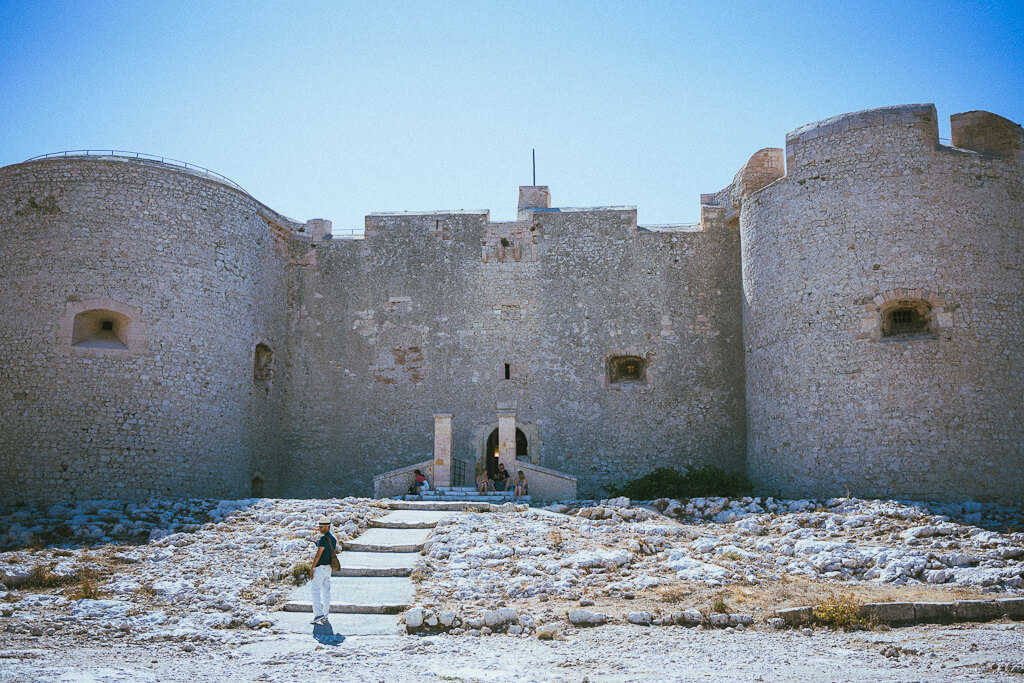
FAQs ABOUT VISITING MARSEILLE FOR 3 DAYS
Where to stay in marseille.
We stayed at the New Hotel of Marseille (a contemporary and surprisingly affordable hotel) with a prime location. If you want more affordable options to stay, check out this guide on hostels for solo travelers and groups in Marseille .
BEST TIME TO VISIT
Marseille is a port city in the southern part of France, but that does not guarantee mild weather year round unlike Northern California beach towns . We witnessed sweltering heat in August during our visit, with temperatures rising upto 90F (30+C). I recommend visiting in Fall, i.e. September-November. Spring, i.e. March and April are good options too.
HOW TO GET TO MARSEILLE FROM PARIS
Marseille was the very last leg of our France trip in 2017 when we visited Paris for one day , spent an incredible week in Provence exploring all the villages and spent two days in Saint-Tropez on the Provence-Alpes-Côte d’Azur. We took the train from Southern France to Marseille. But if you’re visiting from Paris, the same high speed TGV train will take you directly to Marseille as well.
WHAT TO SEE IN MARSEILLE: THE BEST THINGS TO DO IN MARSEILLE IN 72 HOURS
1) visit the chateau d’if.
I will start off this “ What to see in Marseille ” travel guide with the infamous penitentiary Chateau D’If , a ferry ride away from the mainland because let’s face it, this grim looking prison is what propelled Marseille to international fame. I am talking about Alexandre Dumas’ famous novel, The Count of Monte Cristo , with Marseille and the Chateau serving as crucial backdrops to the story.
The protagonist Edmond Dantés, a handsome sailor about to marry his sweetheart Mercédès in Marseille, was wrongly convicted of treason the day before his wedding and imprisoned in the Chateau. He spend 6 long years there and finally escaped taking the place of the dead Abbé Faria, a mad priest who was served as his mentor and had informed him about the island of Monte Cristo filled with treasures.
Edmond returns to France a rich man and successfully extracts his revenge against the people who had incarcerated him. Dumas, himself a man of color, has an equally fascinating history, which we read about in the small exhibition at the Chateau. Although both Edmond and Abbé Faria were fictitious characters, there are cells dedicated to them in the Chateau to rekindle our imagination of their time in captivity.
The best and the only way to visit the Chateau D’If is by ferry . Buy tickets online for boarding the ferry at Friole D’IF express (boards at the old port) and to enter the Chateau ( from it’s website ) for a hassle free experience. Once at the Chateau, you will get helpful guide books in English to help you familiarize with its history and significance.
Originally built as a fortress and later converted to a prison, the Chateau is an impressive structure that evokes both awe and a sense of foreboding as you think of the fate of the prisoners trapped in the middle of the sea, much like what we have at Alcatraz near San Francisco.
Having read the novel a million times as a kid and watched it’s movie adaptation , this was the reason why I chose Marseille as part of my first France visit itinerary. History, fiction and adventure all clash at the shores of the Chateau, like unruly waves and this place is thus a huge draw! Arrive either early or late (last ferry is around 4:30 PM) to avoid crowds.

2) ENJOY PANORAMIC VIEWS OF THE CITY
The best views of Marseille are undoubtedly from atop the Basilica Notre-Dame de la Garde , a Catholic Basilica towering over the city and is the most visited attraction. Irrespective of your faith or lack of it, the Basilica is a must visit (again, arrive early) if you want some of the most gorgeous 360 degree views of the city.
The other lookout point to get a bird’s eye view of the city, the harbor and the Rhone river, is undoubtedly Jardin du Pharo which is where Palais du Pharo is located. The palace was built by Napoleon in 1858 for Empress Eugénie, who gave it to the city after his death.
It was renovated and converted to a medical school in 1904. Right behind the palace is a statue named “Monument aux héros et victimes de la mer” (translates to “monument for heroes and victims of the sea”) and is a bronze statue depicting three sailors. We did not go inside the palace since the sun was gunning down in full fury, but wandered around, took a few photos and generally enjoyed the garden and the surrounding view for the short time that we were there.
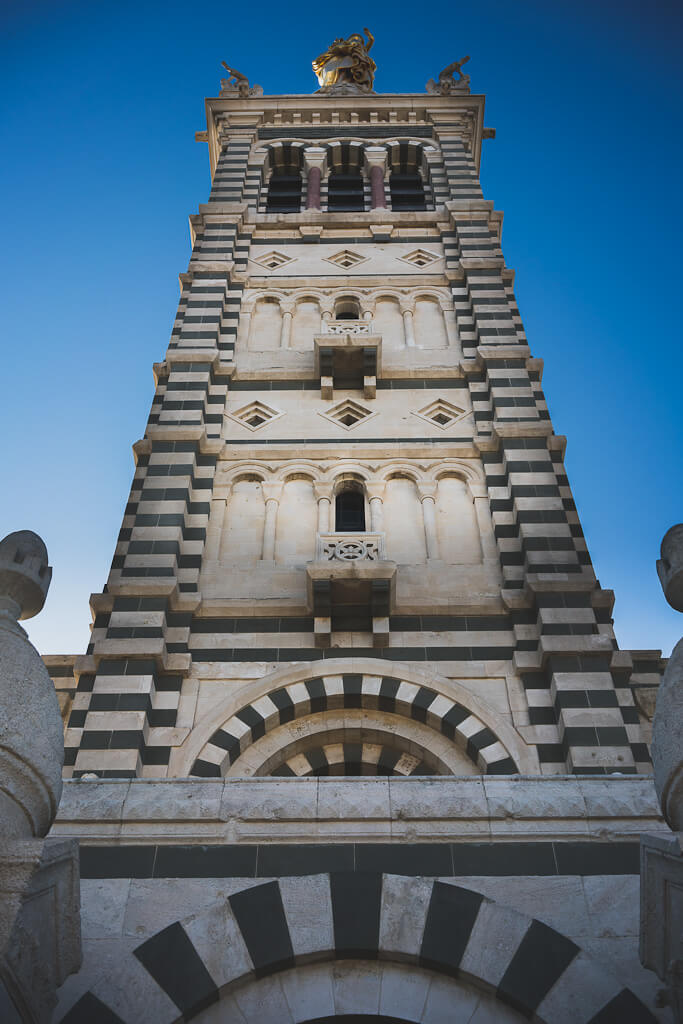
3) SPEND A DAY AT THE BEACH
Let’s face it, we are not beach people. When it’s 90F outside and it’s blazing hot, the beach appeals to me even less. Nevertheless, we dipped our toes in the sand at the popular Plages de Catalans which was teeming with sunbathers and beach volleyball players.
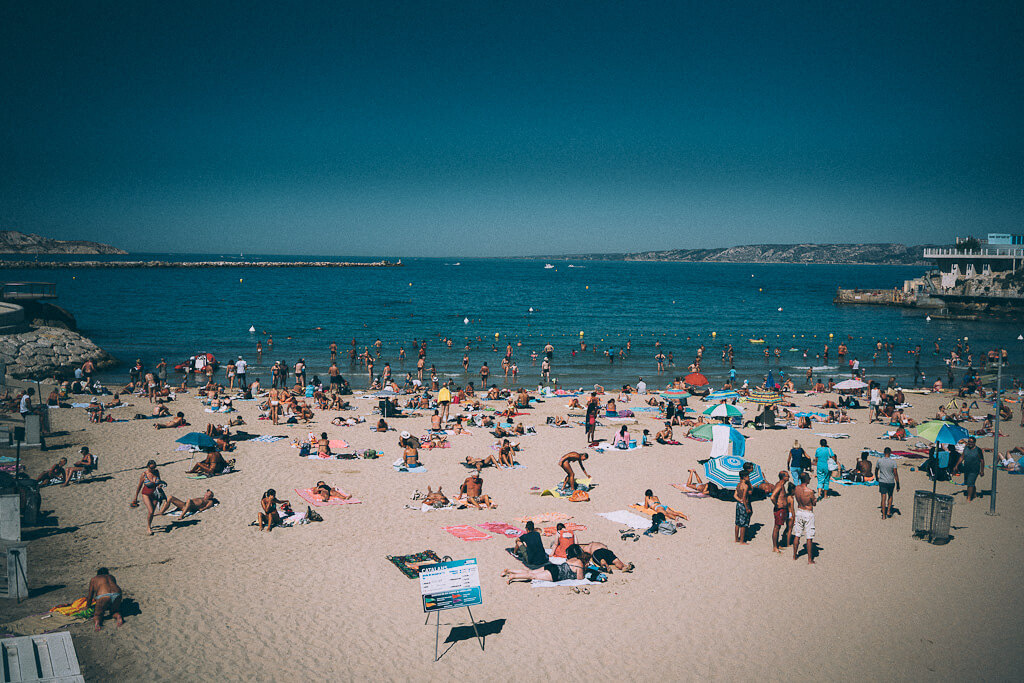
Right along that line you will find Monument aux Morts de l’ Armée d’Orient et des Terres Lointaines, a war memorial dedicated to the “Armée d’Orient” or the brave French soldiers who fought in the first world war at the Macedonian front. Walk below the arches of the memorial to see the Chateau D’If glistening in the morning sun at a distance.

4) ENJOY SOME HEARTY BOUILLABAISSE
Once you’ve had your fill of photographing the war memorial or sunbathing at the beach, head out to Chez Fonfon , a restaurant famous for its bouillabaisse, Marseille’s favorite fish stew . A plate of of the freshest catch of the day is shown to you before preparing the stew and it comes out in a spicy rich broth, a testament to French cooking meets North African spices. We got a window seat overlooking the beautiful quay lined with boats and pastel colored building.

5) VISIT THE OLD PORT OF MARSEILLE
The Old Port of Marseille (known as Vieux port) is essentially the heart of this town and forms an essential part of this “ what to see in Marseille ” guide. Walk along the paved pathway as the sun goes down on the harbor with the Basilica in the background or catch a street performer charming the crowds near the giant ferris wheel that gives of a twinkling glow at night.
Dig into a sumptuous Moroccan dinner (plenty of vegetarian options available) at the famous Le Souk right in the middle of Old Port while watching the endless wave of people from all parts of the Mediterranean strolling down to enjoy the evening breeze. The Old Port at the end of the Canebière, the major street of Marseille and has served as the city’s natural harbor for the longest time. This part of the city perfectly captures the multicultural spirit of the city and is a great place to relax and unwind after a day of sightseeing in Marseille.

6) GO ON A SELF GUIDED MURAL AND STREET ART TOUR
Le Panier, the oldest district of Marseille is definitely popular with tourists for its many attractions, including Cathedral Major (the national monument of France), shops, cafes and it’s mind boggling array of street art that are a visual delight.
Museum lovers should not miss La Viele Charité , a 16th century building that is now home to museum of anthropology and museum of contemporary art (we had to give it a miss due to lack of time). Do not forget to stock up on the famous and authentic Savon de Marseille (soaps manufactured in Marseille which have many fake versions so beware!) from La Grande Savonnerie who have an impressive collection of soaps in different fragrances, their best seller being the olive oil one.
The other neighborhood chock filled with murals and cute, local boutiques is Cours Julien, which is far away from the touristy crowd and is a residential neighborhood. After having our fill of the countless Marseille murals everywhere, we dined here on the busy rue des 3 Rois lined with ethnic eateries. We chose a tiny Ukrainian restaurant and had a hearty meal with borscht soup and Ukrainian stuffed crepes. Read my post on all the murals in Le Panier and Cours Julien to for a virtual tour of these dazzling murals.
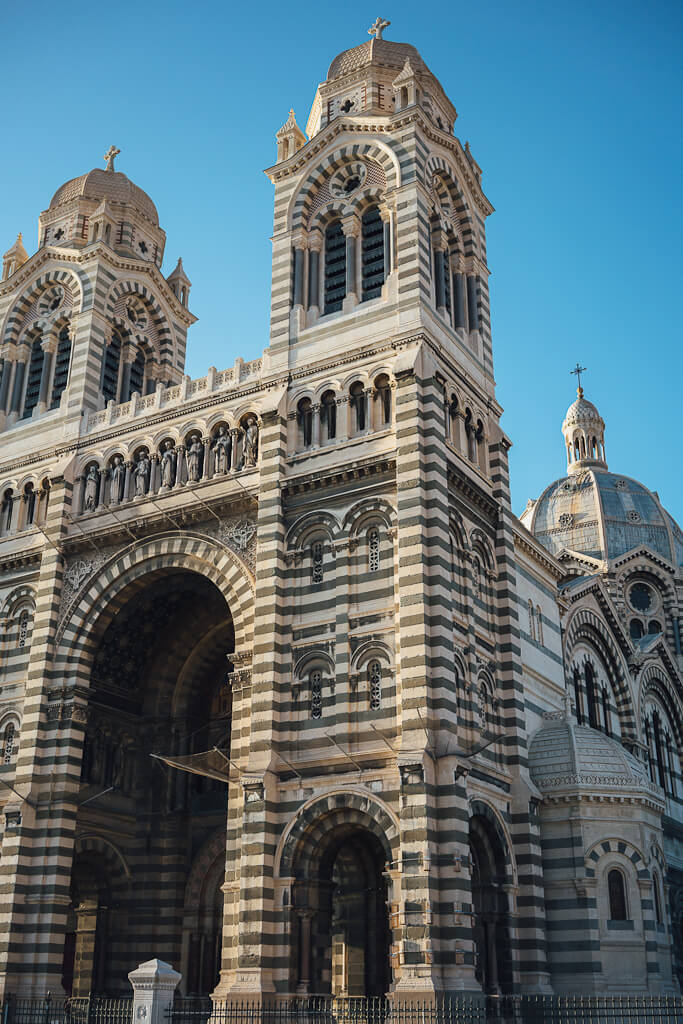
7) GO ON A DAY TRIP FROM MARSEILLE TO CASSIS
Cassis is that one seaside village that is an easy half day trip from Marseille and a must visit for one primary reason-the Calanques . The Parc National des Calanques in Cassis comprises of an unique ecosystem including white, calciferous cliffs (due to an abundance of limestone) flanking the azure blue waters of the sea with 140 protected flora and fauna species and 60 heritage marine species.
It is the 10th national park in France and is the only one to be peri-urban, marine and terrestrial at the same time! Stretching between Marseille, Cassis and La Ciotat, the calanques are best accessed from Cassis. You can get ferry/boat tickets at the tiny kiosk at Quai Saint Pierre, right next to the harbor, and there are options for visiting 3, 5, 8 or 9 calanques (16 Euros/person).
We chose to visit the three most popular ones for 45 minutes and toured Port-Pin, Port-Miou and En-Vau. You can also hike the Calanques but with the sun beating down on us and with not too much time on our hands, that is something we did not want to do.
The guides on the ferry/boats were speaking in either French or German (not sure why the latter) and so we had to be content seeing the sights only (since we couldn’t understand a word), which were spectacular! I highly recommend squeezing this in your Marseille itinerary .
Besides a boat tour of the Calanques, Cassis itself is a pretty village to stroll around. The harborfront, with the colorful boats, is a visual treat and there are many nice stores to shop at, such as L’art du Temps. We also had an excellent lunch at the two Michelin starred La Villa Madie which overlooked a tiny beach where people were sunbathing or canoeing.
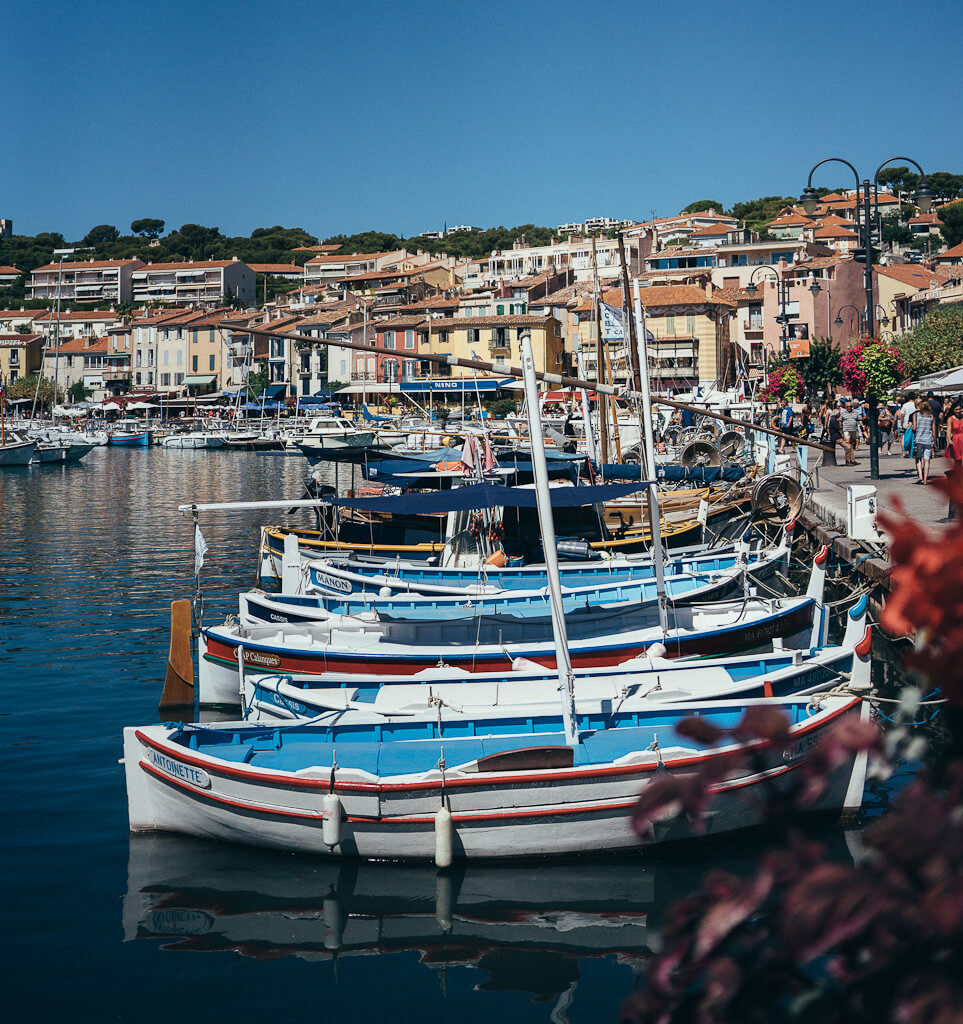
This brings me to the end of yet another post on France, i.e. how to spend 3 days in Marseille. I hope you enjoyed reading it and have gotten plenty of ideas for what to see in Marseille in 72 hours. Truth be told, I loved Paris but Marseille enamored me with it’s raw beauty! I can’t wait to go back someday and savor the city’s sights bathed in the golden sunset over the Mediterranean.
LIKE THIS POST? HOVER OVER THE IMAGES BELOW TO PIN

15 thoughts on “What to See in Marseille: A Three Day Itinerary of France’s Eclectic Port City”
oh man, I wish I found your post a few months ago! I was debating going here and now I am even more sad that I didn’t go! beautiful photos!!
I’ve heard only incredible things about Marseille – so much more interesting than Paris! I hope to make it there soon!
Stephanie | theFantasia.com
Wow! Your images are gorgeous. Oddly specific, but I love places that have an “old port” – I love how classic and beautiful the older style marinas and ports look compared the the newer/more industiral styles today.
I would love to go there! We are thinking perhaps next spring <3
Looks like such a lovely city and Cassis looks adorable! Love the whole concept of Mata traders too!
Your photos are stunning – the blues look amazing! Would love to visit Marseille, looks like there are so many cool things to do and see – thanks for sharing!
How gorgeous! This looks like such a beautiful town. I definitely have to add it to our France bucket list!
I LOVE guides like this! I love short trips so this is definitely being bookmarked for future travel. Your photos are incredible btw, they definitely have that nostalgic feel to them – do you have a guide on how you shoot/edit? I’d love to know more!
The photos and layout on this post are great, I really enjoyed reading through and having the photo story alongside. Mata Traders is such an amazing brand – we used to sell their dresses in a fair trade store I volunteered in but hadn’t thought about packing one of their dresses for trip. So cute.
Great post and pictures! I’m glad you did both Marseille and Cassis – they are both beautiful yet different!
Gorgeous photos! I love your pictures overlooking the rooftops with the boats nearby, it seems to really capture the vibe of the city 🙂
Marseille looks amazing! The food, architecture and street art are just up my alley 🙂 Thanks for sharing!
Everything about Marseille seems so dreamy…you’ve got me looking up flights right now to see when it would be possible to go! As much as I’m sure it’s a beach destination, it seems like it might be a great winter destination, too, since crowds would be minimal and there’s still a lot to do and see besides the beach. What do you think?
I think that’s a great idea.Winter in Marseille would be perfect:-) Let me know if you end up going!
great information, thank you for sharing!
Leave a Comment Cancel reply

Year of the Monkey is the participant in the Amazon Services LLC Associates Program, an affiliate advertising program for sites to earn advertising fees by advertising and linking to Amazon.
@2020 YROFTHEMONKEY, INC. /
PRIVACY • TERMS • GDPR • DISCLOSURES
Designed by WPGeared
Privacy Overview

11 Top-Rated Tourist Attractions in Marseille
Written by Lisa Alexander Updated Dec 26, 2023 We may earn a commission from affiliate links ( )
Author Lisa Alexander spent two years living in France and has traveled the country extensively.
With a busy harbor, vibrant urban energy, and a long list of things to do, Marseille appeals to visitors seeking an authentic tourist experience. This lively cosmopolitan city is France's oldest and the second largest after Paris .
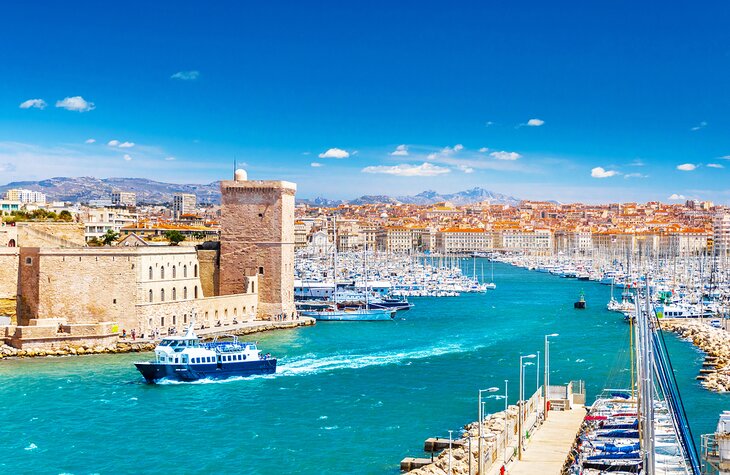
The city has a distinctly Mediterranean ambience, from its red-tile roofed houses to the fishing boats in its port. Everywhere in Marseille, visitors are close to the serene blue waters, whether walking along a charming old street with a view, or feeling the refreshing sea breeze.
The city's colorful, multiethnic heritage also makes Marseille a fascinating place to visit. Considered the bridge between Europe and North Africa, Marseille is home to a sizable immigrant population from Algeria. It's possible to find traditional Arab souks as easily as a classic French bouillabaisse.
Find out more about the top attractions and how to spend your time here with our list of the best things to do in Marseille.
1. Basilique Notre-Dame de la Garde
2. abbaye saint-victor, 3. explore the vieux port, 4. wander through the colorful streets of le panier, 5. musée des civilisations de l'europe et de la méditerranée, 6. enjoy nature walks and scenic boat tours at calanques national park, 7. château d'if, 8. musée d'histoire de marseille, 9. la vieille charité, 10. cathédrale de la major, 11. musée cantini, where to stay in marseille for sightseeing, tips and tours: how to make the most of your visit to marseille.
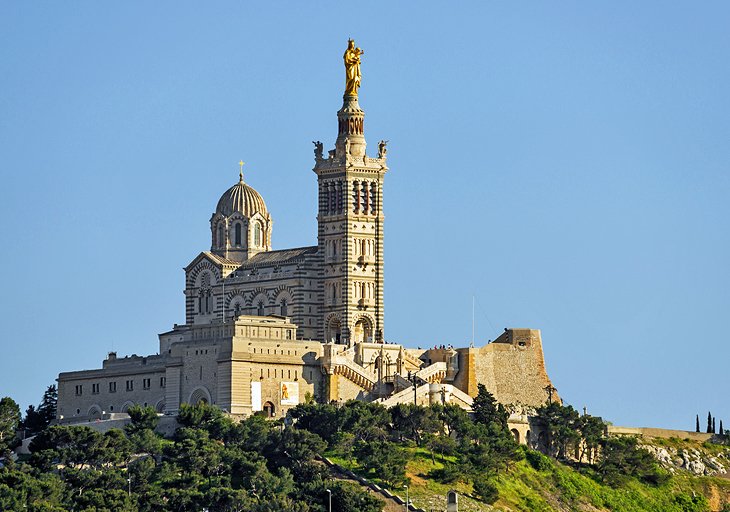
Perched on a hilltop above the harbor, this spectacular church is the most important landmark in Marseille. The site was used in ancient times as an observation point, and during the Middle Ages, was the location of a pilgrimage chapel.
Today, the Basilique Notre-Dame de la Garde is a beacon for the faithful, with an enormous gilded Madonna crowning the belfry. Built between 1853 and 1897, the church features an opulent Neo-Byzantine interior of light and dark marble arches supporting gilded mosaic cupolas. The lavish design has a mesmerizing effect.
After seeing the interior, visitors can spend time on the outdoor terrace that offers breathtaking views. The panoramas extend from the red-tile rooftops of Marseille's buildings to the Vieux Port (historic harbor), all the way to the Frioul Islands in the Mediterranean Sea.
Address: Rue Fort du Sanctuaire, Marseille
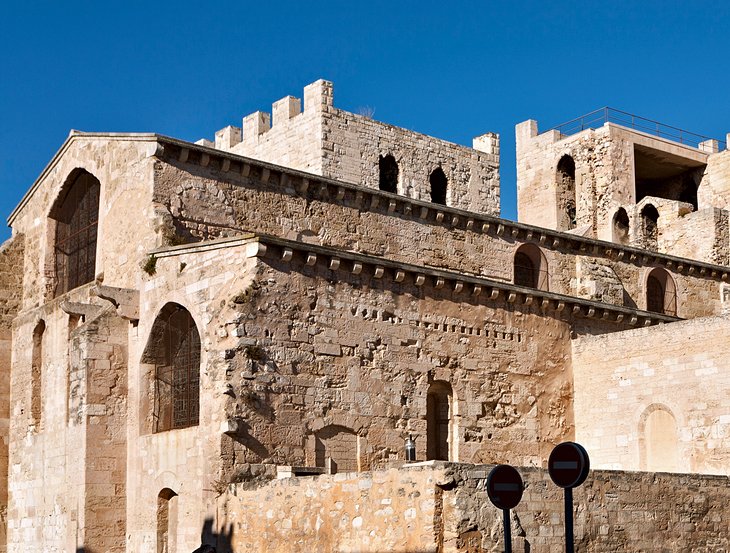
A short walk from the Vieux Port, the Abbaye Saint-Victor is another must-see tourist sight with splendid harbor views.
The Abbaye Saint-Victor was founded in the 5th century and incorporates the original basilica, which makes it one of the oldest buildings in Marseille that is still intact. The basilica, along with its crypt, is considered a gem of Early Christian architecture and art.
Most of the abbey was rebuilt in the 12th and 13th centuries during the Romanesque era. With its crenellated walls and towers, the foreboding exterior has the feel of a medieval fortress.
Inside, this 5th-century basilica reveals a simple and somber design, which gives it a special aura. The crypt houses a precious collection of sarcophagi from the 4th and 5th centuries, as well as the 11th-century tombstone of Abbot Isarnus. It is believed that the relics of Saint Victor are also buried in the basilica's crypt.
The Abbaye Saint-Victor is open for visits every day year-round.
Annually on Candlemas (February 2nd), pilgrims participate in a religious procession from the Vieux Port to the Abbaye Saint-Victor with a stop along the way at the Four des Navettes , an 18th-century bakery that makes the special boat-shaped biscuits of Marseille ( Navettes de Marseille ).
Address: 3 Rue de l'Abbaye, Marseille
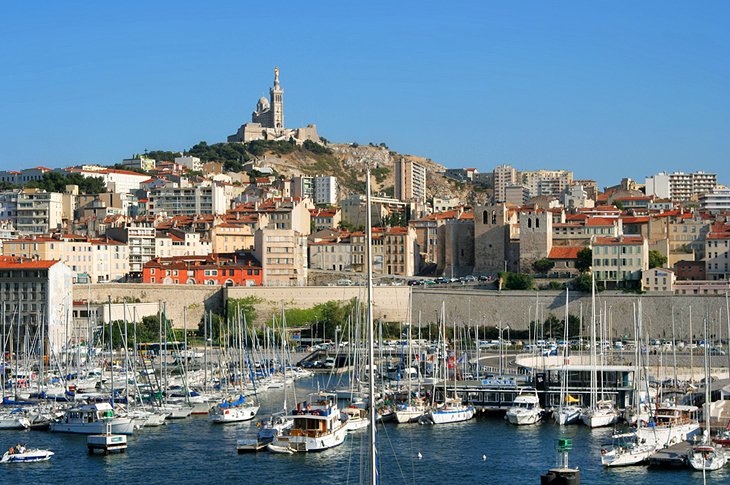
The Vieux Port represents the birthplace of Marseille. This is where the city began as a Greek port around 600 BCE. Surrounded by serene blue waters, the Old Port is located in the west of Marseille near La Canebière boulevard.
A stroll around this bustling harbor immerses visitors in the sights and sounds of a thriving Mediterranean port. The waterfront is a focal point for tourists, and many say it's one of the best places to visit in Marseille for authentic local cuisine. Seafood restaurants specialize in bouillabaisse , the flavorful seafood stew that is the city's signature dish.
On the east side of the harbor, the Quai des Belges hosts a fish market every morning. Once an important commercial port, the Vieux Port is now used primarily by fishing boats and sports craft.
The Old Port is also the launching point for the ferries that sail to two popular tourist destinations: the Château d'If and the Calanques near Cassis.
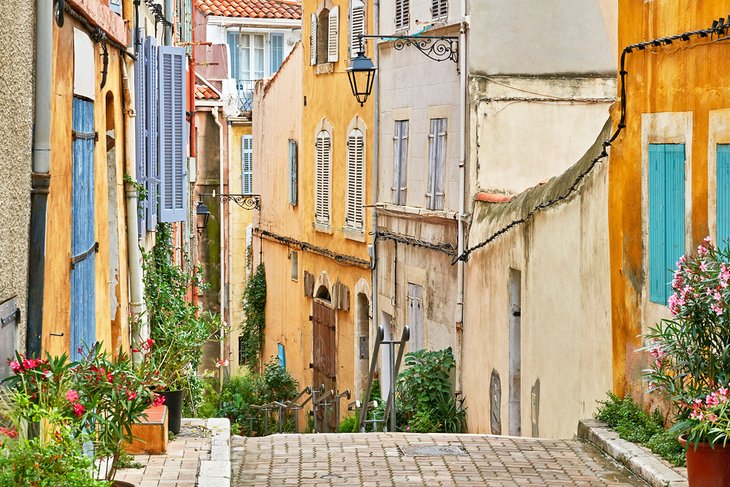
Splendidly situated on a hillside above the Vieux Port, this colorful neighborhood is the historic center and cultural heart of Marseille. Le Panier is Marseille's oldest quarter, inhabited since antiquity when the ancient Greeks settled here in 600 BCE.
With its steep, narrow winding streets and quaint pastel-painted buildings, this quarter offers a glimpse into the charming personality of Marseille. Once a working-class neighborhood, Le Panier is now a gentrified residential area, but the typical houses with shuttered windows and lines of laundry provide a glimpse of its old-fashioned character.
Visitors may begin a walking tour on the north side of the Vieux Port harbor basin at the Quai du Port and then walk up La Canebière , a vibrant boulevard that buzzes with activity.
Wandering through this atmospheric neighborhood leads to discoveries of local artisan boutiques, gourmet food shops, and art galleries. Le Panier also brims with inviting little restaurants that feature outdoor terrace seating. Many restaurants serve excellent fresh-caught seafood; others specialize in French, Italian, or authentic Algerian cuisine.
The quarter has several important monuments such as the Hôtel de Ville (Town Hall), which was built in the second half of the 17th century based on a Genoese architectural model.
Other landmarks include the Cathédrale de la Major and the Vieille Charité , a dormitory for the poor in the 17th and 18th centuries that now houses a museum of contemporary art.
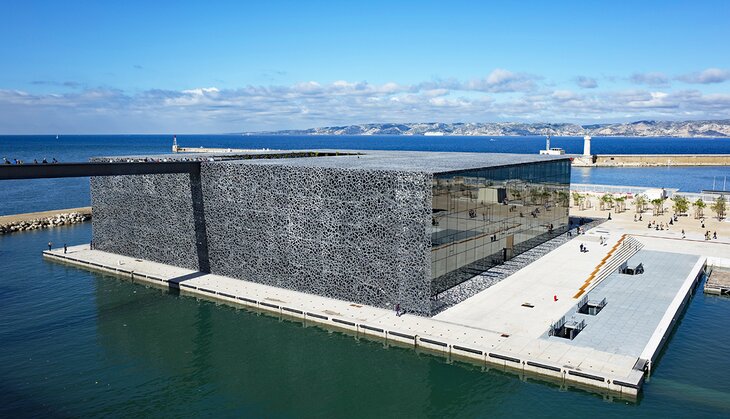
The Musée des Civilisations de l'Europe et de la Méditerranée, also known by its acronym Mucem , provides an in-depth look at civilizations of the Mediterranean Basin.
A stunning complex of three different sites, this expansive museum presents a wealth of exhibits in various disciplines: ethnography, art, history, and cuisine of Mediterranean cultures.
Covering this wide range of content, the museum's galleries display paintings, photographs, documents, antique furnishings, and everyday objects, as well as lectures and film screenings.
The newest part of the museum is a dazzling ultra-modern waterfront building (on the former J4 Pier) with outlooks onto the harbor and the Mediterranean Sea.
The J4 building displays the museum's most important permanent collections, as well as temporary exhibits, and also hosts cultural events. The J4 building contains the museum's main gift shop, which sells a wide range of books on topics related to European culture and history.
Gourmands will be happy to discover the dining options on the rooftop of the J4 building. With renowned chef Gérald Passedat at its helm, Le Môle Passedat (open for lunch and dinner) offers breathtaking sea views and traditional Mediterranean cuisine (including mezze ) prepared from seasonal ingredients.
Also on the rooftop, the casual restaurant La Cuisine is open for lunch and dinner, and Le Café serves coffee, refreshments, and snacks.
An aerial footbridge connects the J4 Pier building with another section of the museum in the vaulted rooms of the Fort Saint-Jean , a 12th-century monument that played a role during the Crusades. The Fort Saint-Jean includes lush Mediterranean gardens and a ramparts path where visitors can admire sweeping panoramas of the Marseille cityscape, the Vieux Port, and the sea.
The third site, Le Centre de Conservation et de Ressources du Mucem , is located in the Belle de Mai quarter. This center provides a behind-the-scenes look into the work of the museum.
Address: 7 Promenade Robert Laffont (Esplanade du J4), Marseille
Official site: http://www.mucem.org/en
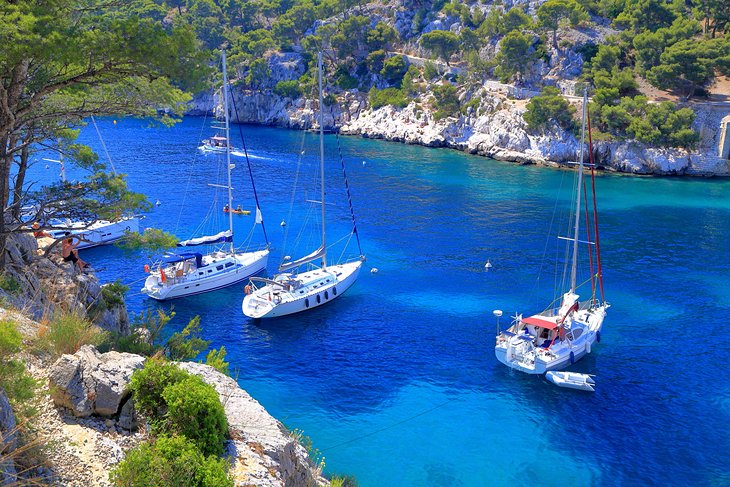
Between Marseille and the quaint fishing village of Cassis is the Parc National des Calanques , a splendid nature site where the Mediterranean meets the Massif des Calanques mountain range.
The landscape is distinguished by majestic limestone rock walls with fjord-like coves (" calanque " translates to "cove") filled with pools of saltwater in mesmerizing turquoise hues.
Outdoor sports enthusiasts will find many things to do at Calanques National Park, such as swimming, kayaking, rock climbing, and hiking. An excellent system of trails allows visitors to appreciate the pristine landscape and gorgeous coastal views.
For those who enjoy yachting and boat cruises, the fjords provide spectacular scenery on an idyllic journey through the tranquil maritime environment.
The largest calanques, Port-Miou, En-Vau, and Port-Pin, can be reached by car or by ferry from Marseille. It is also possible to take a guided boat tour or arrange a private boat trip.
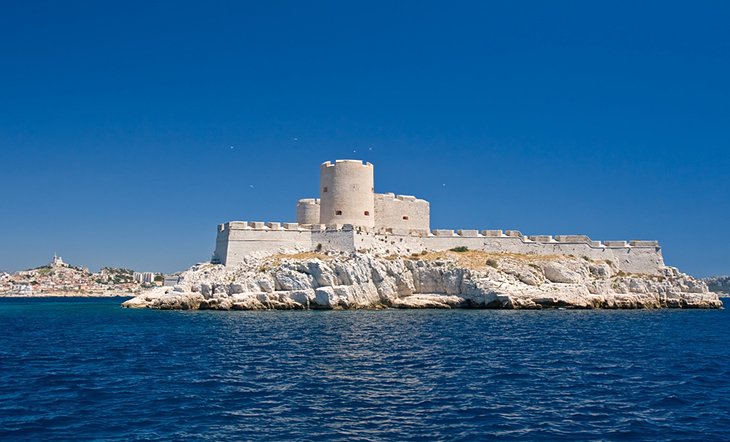
A short ferry ride away from the Vieux Port of Marseille, the Château d'If is located on the Île d'If in the Frioul Islands archipelago, a nature conservation area that includes the tiny islands of If, Pomègues, Ratonneau, and Tiboulen.
The spectacular scenery features protected coves, turquoise waters, pristine beaches, sandy creeks, and impressive limestone cliffs. Thanks to the Mediterranean sunshine, the light creates a serene shimmering effect on the water, and a microclimate allows rare floral species to thrive here.
In this beautiful natural setting, the Château d'If was built as a fortress by King François I in the 16th century. Soon after, the fortress was converted into a prison. The location is depicted in Alexandre Dumas' novel The Count of Monte Cristo .
Ferry boat service is also available from the Vieux Port in Marseille to the Île de Ratonneau , where tourists may sunbathe on the beach, go for a hike, or visit the 19th-century Fort de Ratonneau .
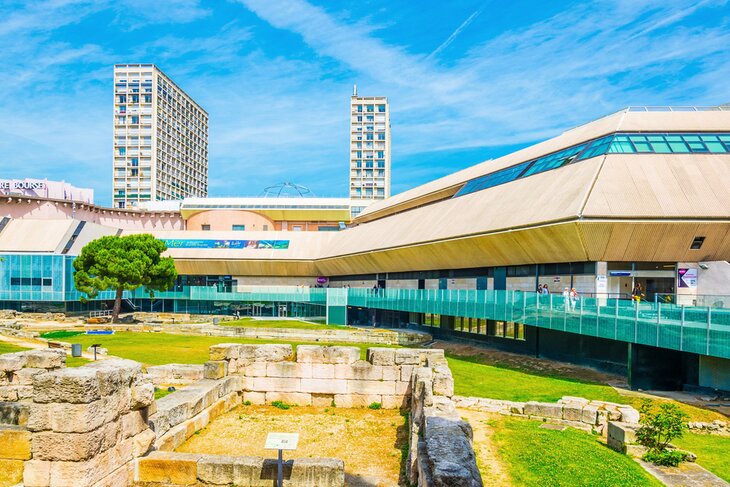
In Le Panier quarter, just a few steps away from the Vieux Port, the Musée d'Histoire de Marseille tells the story of Marseille from its Gallo-Greek origins through the Middle Ages to the present day. The museum offers an impressive collection of artifacts, covering 2,600 years of history.
The historical evolution of France's oldest city comes to life in this sleek modern museum's bright spacious rooms. The collections contain 4,000 items and hundreds of multimedia exhibits.
The museum also has a garden, the Jardin des Vestiges , which is actually the excavation site of the 3rd-century BCE port of Massalia (also spelled "Massilia").
Address: 2 Rue Henri-Barbusse, Marseille
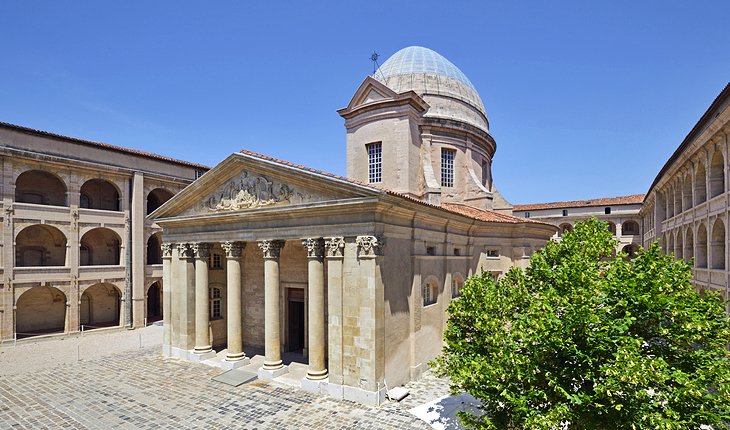
La Vieille Charité is located on the Place des Moulins that lies at the highest point in Le Panier .
The building was created in 1640 when the Town Council of Marseille decided to give impoverished residents decent accommodations, in compliance with a royal policy of "enclosing the poor."
In 1749, a three-floor public hospital with four wings was added to the building. There is a chapel at the center courtyard of the hospital complex. Built from 1679 to 1707, the chapel is a wonderful example of Italian Baroque architecture.
The facade of La Vieille Charité is more modern, dating from 1863. Upon close observation, visitors will notice the depiction of two pelicans feeding their young, to represent Charity looking after poor children.
Since 1986, La Vieille Charité building has been used to host scientific and cultural events and to house a museum, Le Centre de la Vieille Charité . This museum presents cultural events, ethnographic exhibits, and themed art expositions throughout the year.
Address: 2 Rue de la Charité, Marseille
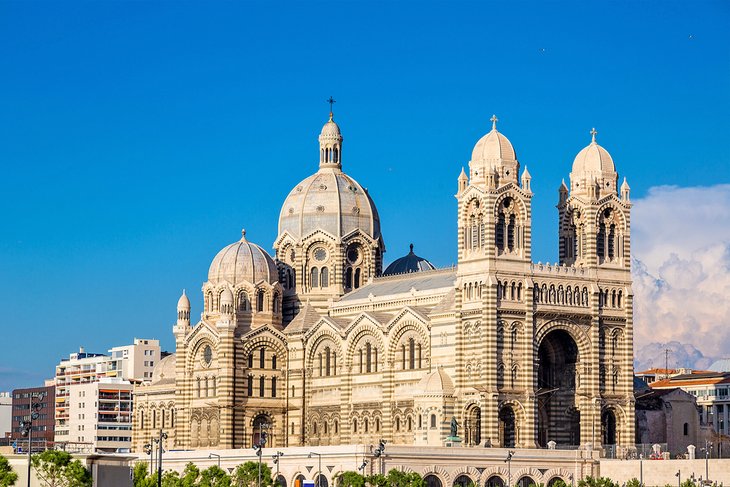
Near the northwest corner of Le Panier, the Cathédrale de la Major (Cathédrale Sainte-Marie-Majeure) stands majestically on an esplanade overlooking the waterfront. This ornate Neo-Byzantine cathedral seems to keep watch over the Old Port, with its soaring twin towers and 70-meter-high dome.
Louis-Napoléon Bonaparte commissioned the construction of this cathedral in 1852. Completed in 1893, the Cathédrale de la Major is the largest church (and the only cathedral) constructed in France during the 19th century.
Its dimensions (142 meters long by 20 meters high) are similar in scale to Saint Peter's Basilica in Rome. Classified as a Monument Historique , this cathedral incorporates an Early Christian baptistery that dates to the 5th century.
The lavish interior is richly decorated with Carrara marble and exquisite Venetian mosaics. An impressive assortment of statues is also found throughout the sanctuary.
At the foot of the cathedral is a plaza called " Les Voûtes ," a popular gathering place filled with shops, restaurants, and cafés. Locals and tourists alike enjoy strolling through this happening area. In addition to the trendy scene, Les Voûtes also offers fabulous sea views.
Address: 10 Place de la Major, Marseille
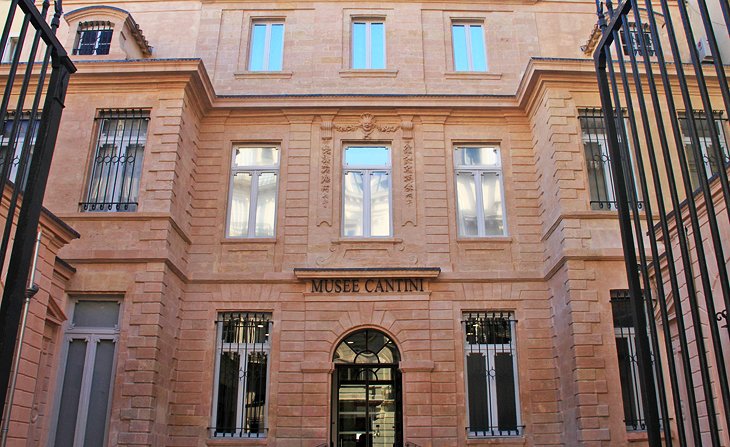
Art lovers will appreciate the superb collection of modern and contemporary art found at the Musée Cantini, displayed within a 17th-century hôtel particulier (mansion). The local art collector Jules Cantini bought this elegant house in 1888, and he bequeathed it to the city of Marseille in 1916.
The Musée Cantini boasts one of the country's most extensive assortments of modern art created between 1900 and 1960. Highlights of the collection include works by André Derain, Raoul Dufy, Wassily Kandinsky, Max Ernst, Joan Miró, and Pablo Picasso.
A short walk from the Musée Cantini is the Cours Belsunce , a wide esplanade designed in the 17th century as a place for residents to enjoy leisurely strolls.
Address: 19 Rue Grignan, Marseille
Most major attractions in Marseille are close to the Vieux Port and in Le Panier, the colorful and historic neighborhood of steep, narrow streets that wind up the hillside above the west side of Vieux Port. In these two quarters of Marseille, you'll find these highly rated hotels :
Luxury Hotels :
- The Hôtel La Résidence du Vieux Port features exceptional views of the waterfront and the Basilique Notre-Dame de la Garde across the harbor. This four-star hotel has been recently redecorated in a retro 1950s style.
- The InterContinental Marseille - Hôtel Dieu occupies a Monument Historique perched on a hilltop in Le Panier. This five-star hotel has a chic brasserie with an outdoor terrace, a Michelin-starred gastronomic restaurant, room service, and an upscale spa with a sauna, two hammams, an indoor pool, and a fitness center.
- Overlooking the Vieux Port, the Sofitel Marseille Vieux Port is nestled in a picturesque location next to a spacious park and near the Abbaye Saint-Victor. The five-star property has a spa, hair salon, and several restaurants.
Mid-Range Hotels:
- The three-star Hôtel Escale Oceania Marseille is just steps away from the Vieux Port in the city center near many restaurants and shops. Stylish modern guest rooms feature large windows, private balconies, and Italian-style "rain" showers.
- Located right on the waterfront, the Radisson Blu Hotel Marseille Vieux Port offers great views of the Old Port along with four-star amenities. Guests love the outdoor swimming pool and sun terrace area, as well as the gourmet restaurant with pleasant outdoor patio that overlooks the marina.
- The bright, spacious guest rooms at the four-star Grand Hôtel Beauvau Marseille Vieux-Port - MGallery are decorated in cheerful Provençal style. The hotel is near the Vieux Port in the city center.
Budget Hotels:
- The two-star Hôtel Hermès is a short walk to Le Panier quarter and has a rooftop terrace overlooking the Vieux Port. The services (24-hour front desk and concierge) are better than expected for a budget hotel.
- Near the train station and a 20-minute walk from the city center, the ibis Marseille Centre Gare Saint Charles provides basic accommodations at an affordable price. This three-star hotel offers taxi service, parking, a breakfast buffet, and a restaurant with pleasant outdoor seating.
- Sightseeing in and around Marseille: For the perfect combination of sightseeing and seaside scenery, consider the Provence, Marseille, and Cassis Sightseeing Tour . This half-day itinerary includes a tour of the historic landmarks in Marseille, a scenic drive along the Corniche des Crêtes, a stop in the Provençal fishing village of Cassis, and a 45-minute cruise through the Calanques National Park.
- Provence Day Trip: If you want to experience the best of Provence, the Provence Countryside Tour is a great way to do it. This full-day adventure takes you to explore Avignon, the "City of Popes;" the village of Châteauneuf-du-Pape, surrounded by vine-covered hills; and the fortified medieval town of Les Baux-de-Provence.
- Luberon Day Trip: Lavender fields, hilltop hamlets, and rugged mountain terrain are the highlights on the Perched Villages of the Luberon Day Trip . This full-day excursion begins with a scenic drive through the beautiful Luberon foothills to see several charming medieval villages (Roussillon, Lourmarin, and Gordes), and continues to the 12th-century Sénanque Abbey and the town of L'Isle-sur-la-Sorgue, known for its picturesque canals and wide selection of antique shops.
More Related Articles on PlanetWare.com
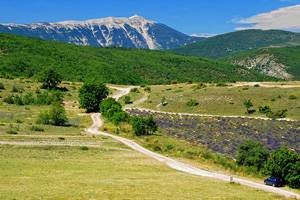
Exploring the Provence Region : Marseille is found in the heart of Provence , a favorite tourist destination in France. Many quaint hilltop towns and fishing villages, like Cassis, are easy day trips from Marseille . Also not to be missed are Aix-en-Provence (30 kilometers away) and Avignon (100 kilometers away).
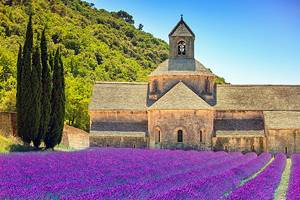
Traveling Off the Beaten Path : Slightly further afield (an hour's drive) is the unspoiled countryside of the Luberon region in Provence's Haut-Vaucluse , dotted with ancient abbeys and hilltop villages. About 120 kilometers away from Marseille, the historic town of Nîmes is well worth the journey to see its ancient Roman monuments and top-notch museums.
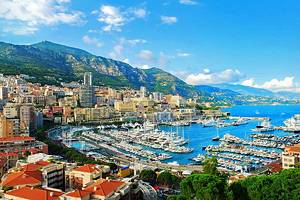
Seaside Scenery and Beach Resorts : Around Marseille, the coastline beckons with sunshine and beautiful Mediterranean scenery. The quintessential port town of Toulon is an hour's drive away, and the glamorous resort of Saint-Tropez , with its beautiful beaches, is a two-hour drive. Continuing along the Côte d'Azur are Cannes , Nice , and Monaco , famous for fancy beach clubs, upscale hotels, fine dining, and art museums.
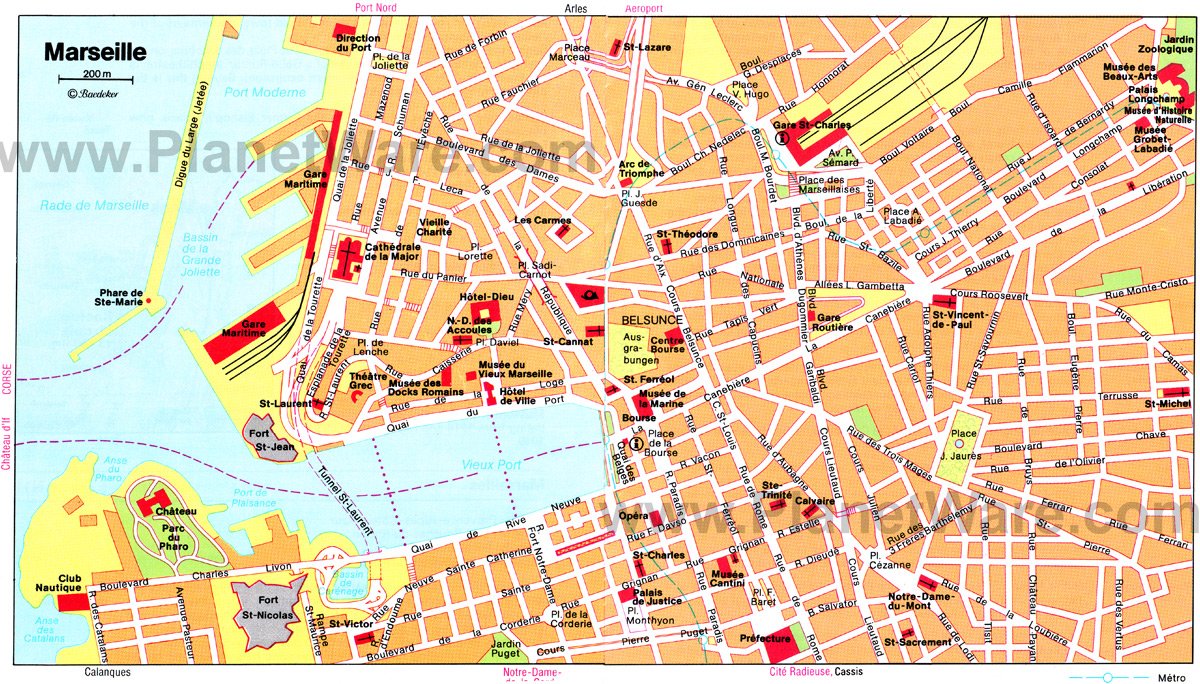
More on France


14 Best Things to do in Marseille, France
Written By: The Planet D
Updated On: February 9, 2024
Marseille is the second-largest city in France after Paris, the capital of Provence-Alpes-Côte d’Azur, and the oldest city in the country.
Located on the Gulf de Lyon, which is part of the Mediterranean Sea, Marseille is the perfect blend of African and French culture. Known as the bridge between North Africa and Europe, Marseille is a city that will charm you with its beautiful blue waters and historic old town. There are so many things to do in Marseille that you can easily spend a few days in this seaside city.
Table of Contents
Top Things to do in Marseille
From its dazzling Old Port to the legendary Chateau d’If, Marseille this Mediterranean City should not be missed when visiting Southern France .
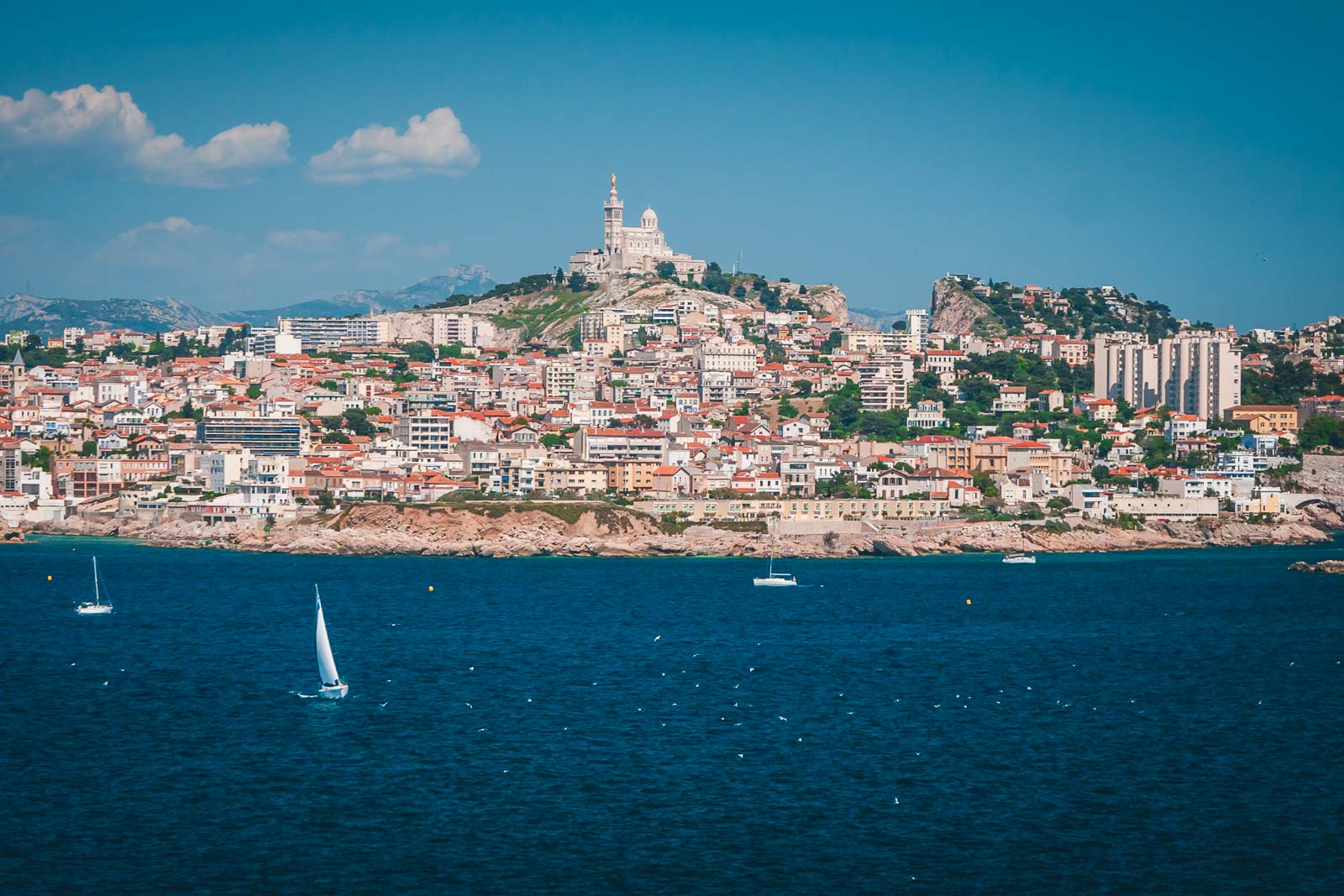
The majority of the cool things to do in Marseille are located in the Vieux port/Le Panier part of town. This natural harbor has been used for the last 2400 years and is the perfect place to start off your exploration of the city.
1. Old Harbour – Le Vieux Port
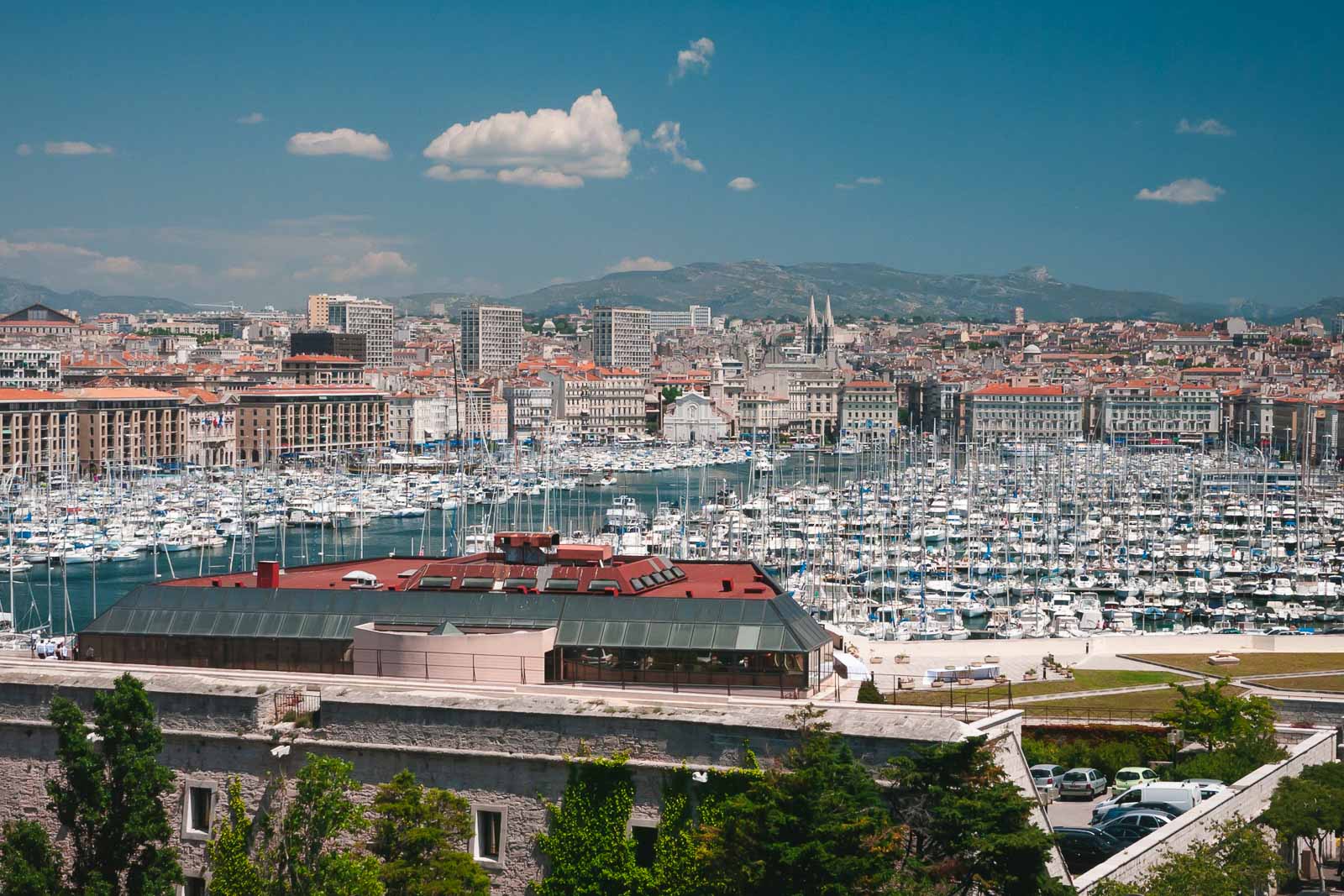
Marseilles is one of our favorite cities in France. Le Vieux Port of Marseilles is stunning and filled with the raw energy that you would expect from any lively port city. Surrounded by historic buildings and filled with fishing boats and leisure crafts, the port feels as if it has stood still in time. And it should, the Old Port of Marseille dates back to 600 BC!
The old fort stands proudly at the water’s edge and the cathedrals look down over the main square. Other than the slick bistros and cafes lining the boulevards, it looks as if it could be the setting for an old pirate movie . We could imagine what it was like back in the 17th Century when schooners would come into the Vieux port filled with sailors. And it feels like it hasn’t changed a bit.
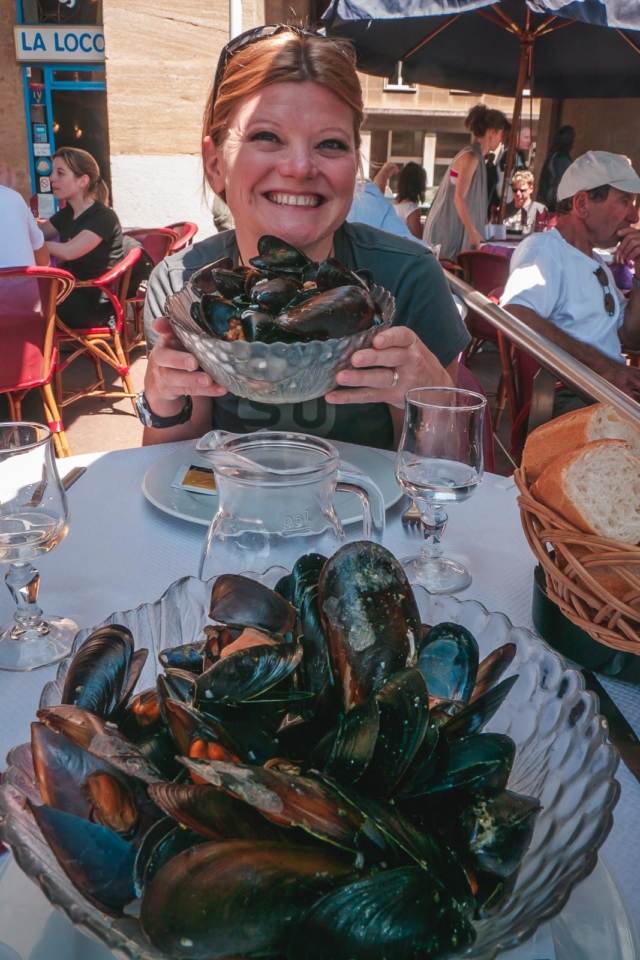
When visiting the Old Port, we suggest grabbing a spot at an outdoor patio with a glass of sparkling wine accompanied by fresh mussels to take in the energy and atmosphere.
When visiting Marseille, we suggest getting a Marseille City Pass – The city pass is valid for 1-3 days and lets you hop on hop off to see all the top tourist attractions. With unlimited access to public transportation plus a tour on the Tourist train to Notre-Dame de la Garde or through the Old Marseille. You’ll have entry to MUCEM, and Regards de Provence Museum, plus crossing Frioul Island, or If Island with entrance to Chateau D’If. There are plenty of discounts, entry to municipal museums, and a guided city tour. See details here.
2. Le Panier
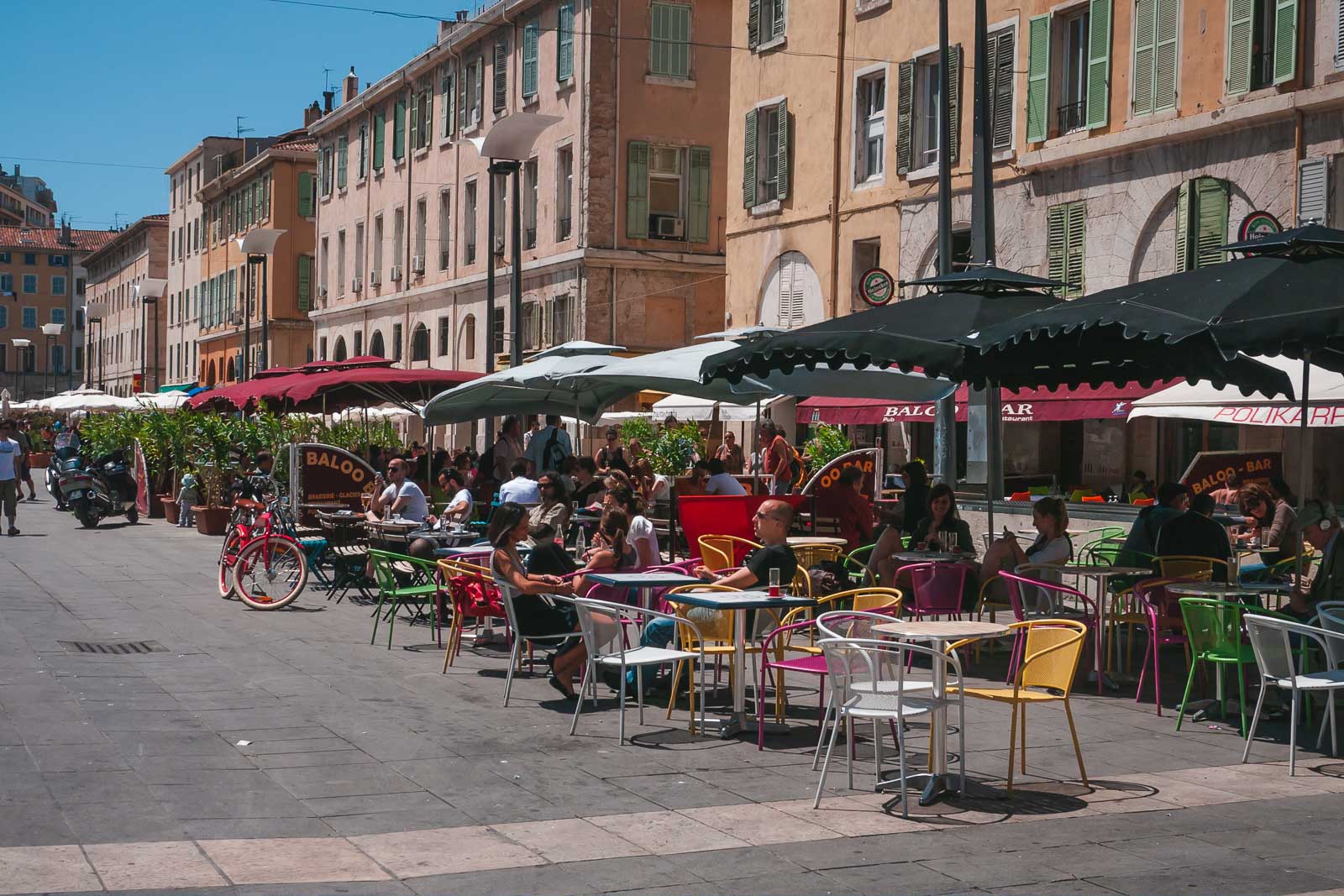
When visiting Europe, we always love getting lost in the old towns of its historic cities. And Marseille is no different. Le Panier, The Old Quarter dates back to 600 BC when the ancient Greeks settled in these parts. It is the oldest district in Marseille and was originally called Massala when it was founded and eventually morphed into its French name today. It has been the center of immigration to the city creating a multicultural flare filled with excitement.
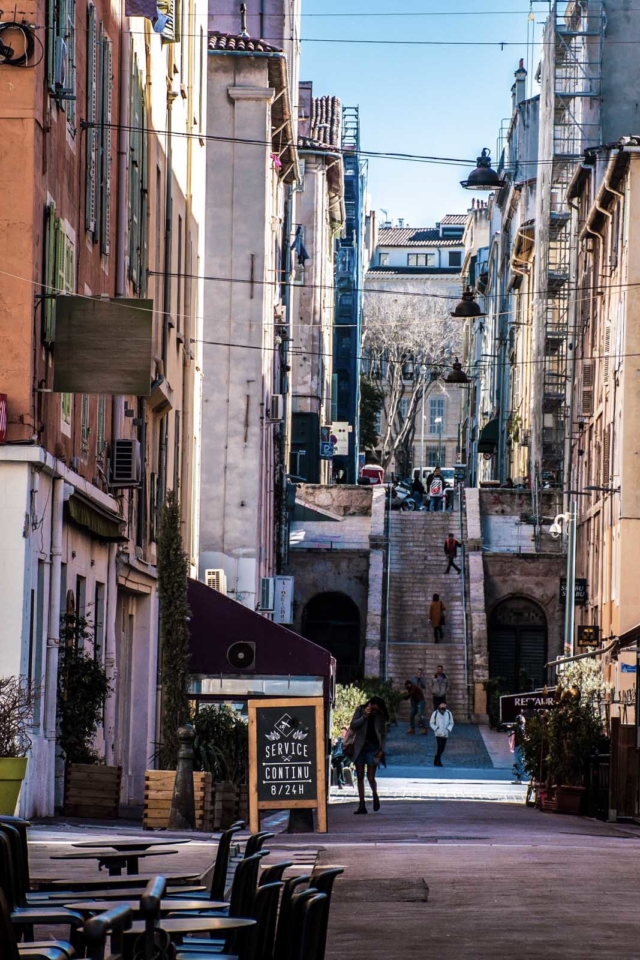
The narrow cobblestone streets lined with colorful shuddered windows make for a lovely walk through the daily lives of the locals and the area is filled with restaurants and cafes.
This guided audio tour lets you experience Le Panier, the historic district of Marseille where you’ll visit Vieux Port, City Hall, Saint Nicolas, and Saint-Jean forts, and the Notre Dame “Bonne Mère” Basilica.
3. Fort Saint-Jean
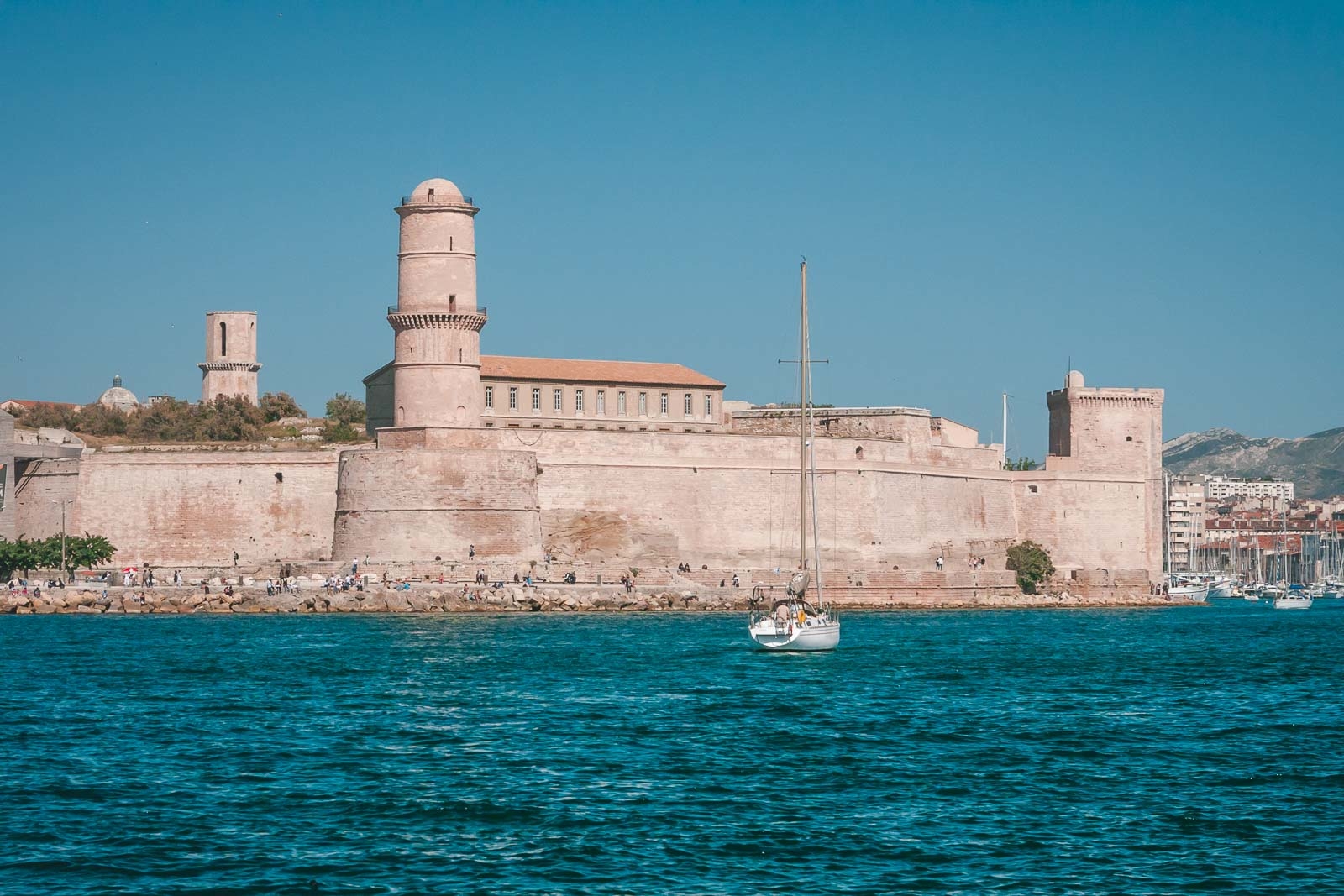
Standing front and center of the Old Town is one of the most visited monuments in Marseille. Fort Saint-Jean is connected by a footbridge to MuCEM (Museum of the Civilizations of Europe and the Mediterranean). Fort Saint-Jean can’t be missed with its tall watchtower. Built by shipowners in the Middle Ages to fortify the area and defend Marseille from invaders.
3. MuCEM – Museum of Civilizations of Europe and the Mediterranean
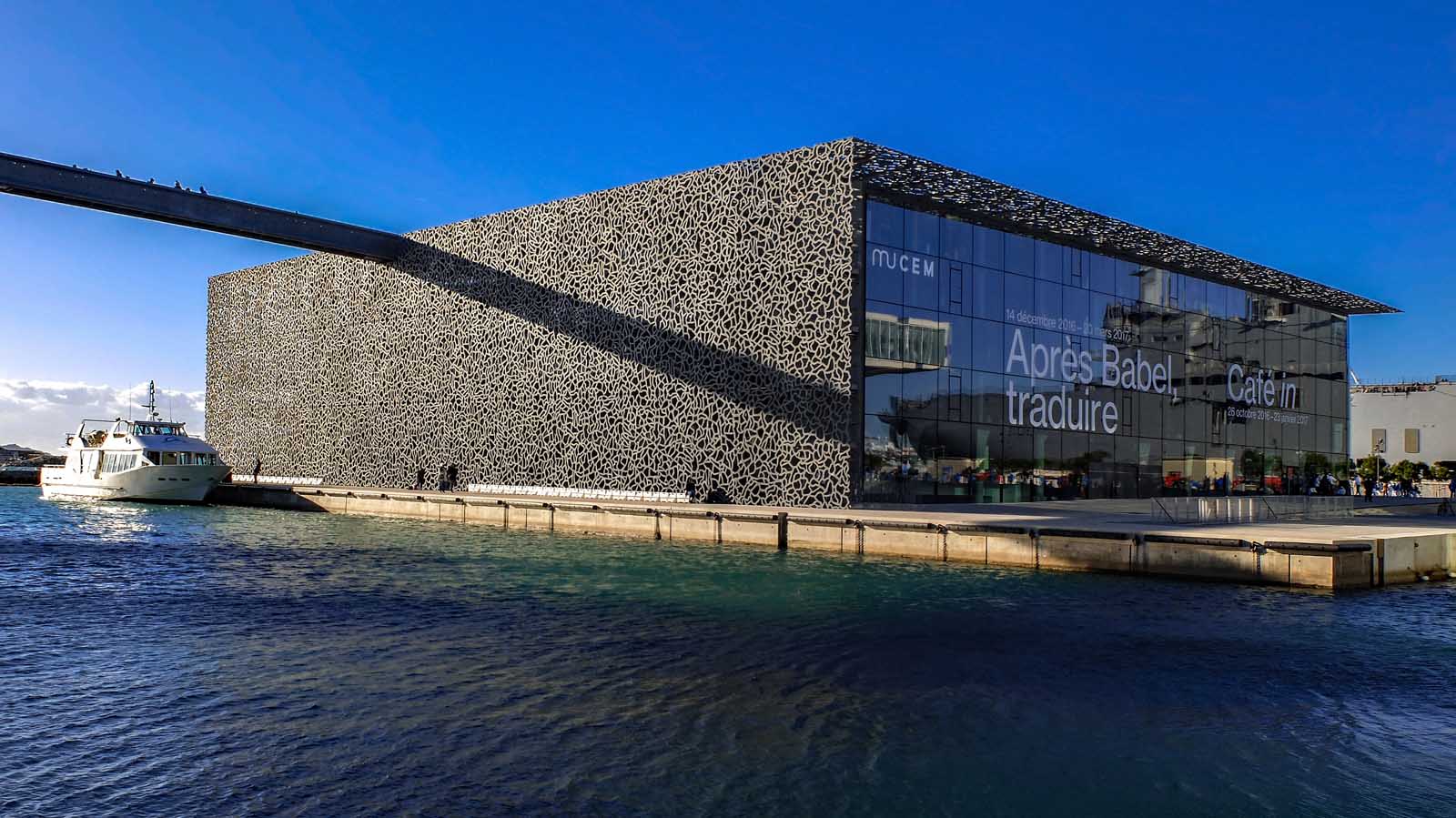
It is fitting that this museum stands in one of Europe’s oldest cities. In 2013, Marseille was named a European Capital of Culture and The MuCEM – Musée des civilisations de l’Europe et de la Méditerranée was opened as part of its inauguration. The modern structure is a sharp contrast to the historic architecture lining the waterfront. Built between land and sea, MuCEM, is located beside Fort Saint-Jean bringing life to the area.
While the museum is dedicated to the history of European civilization and Mediterranean Culture , it is the building itself that has caught the attention of tourists. It is the newest of Marseille’s tourist attractions and is quickly becoming the most popular thing to do in Marseille.
4. Chateau d’If
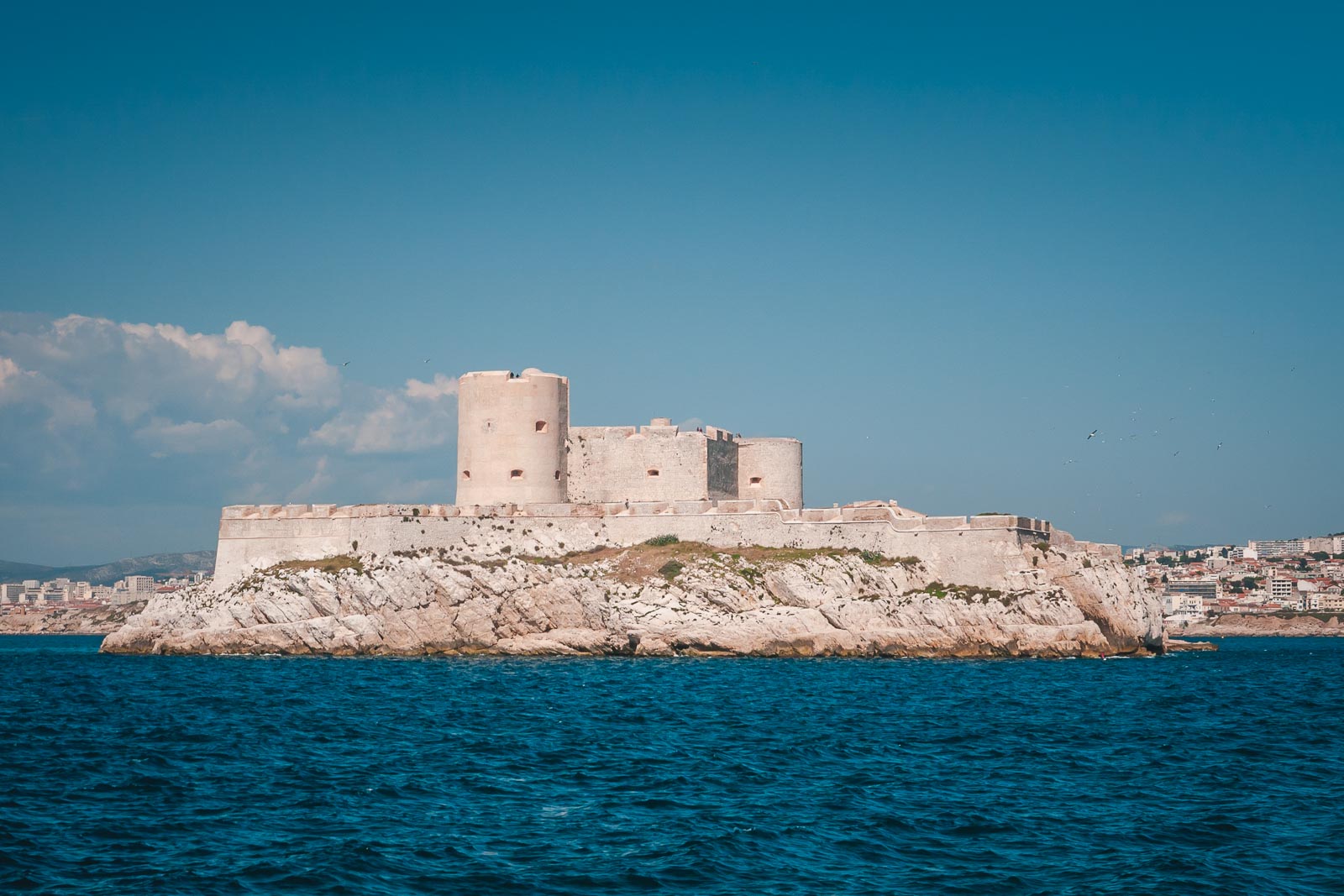
Marseille is the setting for this famous novel, The Count of Monte Cristo written by Alexander Dumas, but Chateau d’If is not a fictional location. It is very real and this island prison stands just off the coast of Marseille in the Mediterranean Sea.
Originally built as a fortress, Chateau d’if was later used as a prison for political prisoners. Take the boat over to If Island (included in our CityPass) and then explore the cells of the famous political prisoners who suffered a dreary fate with no chance of escape.
Surprisingly, the cells of Chateau d’If were quite large. The higher-ranking prisoners paid for better cells that were spacious and even had fireplaces. The poorer prisoners were condemned to the lower dungeons which were intolerable and we were not able to see.
If you have read The Count of Monte Cristo or are familiar with any of the movies, Chateau d’If must be added to your list. Poor Edmond Dantes was sent to the prison island of Chateau d’If where he spent 14 years suffering at the hands of his tormentors before escaping and taking his revenge. Get your copy on Kindle or Paperback here.
- €10 will get you a seat on the 20-minute ferry ride out to the island. You will have to pay another €5 once you arrive at Chateau d’If to see the sites.
- Or if you have a City Pass, the entry and crossing are included.
4. Basilique Notre-Dame de la Garde
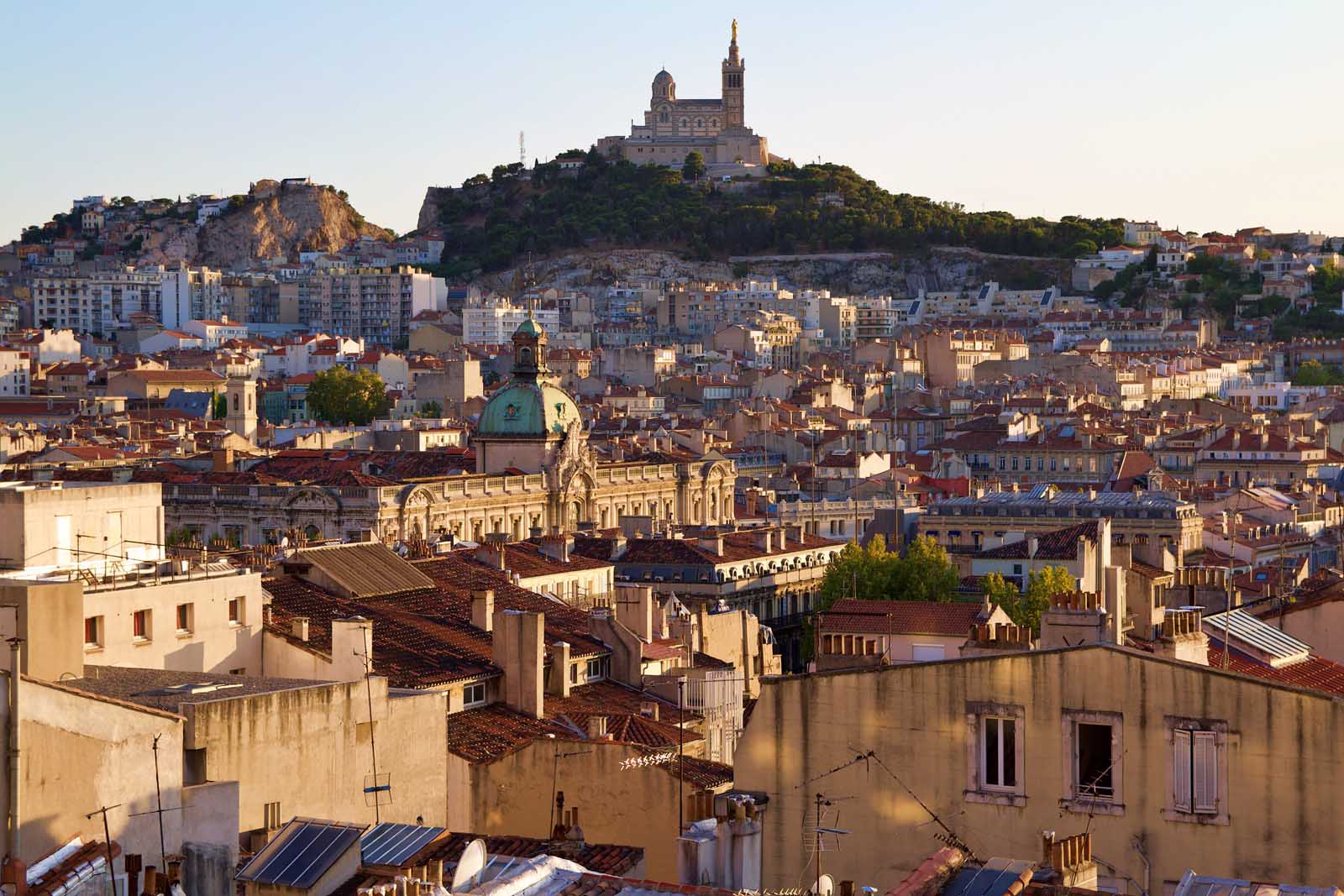
Paris isn’t the only city with Notre Dame. Marseille city has its own Notre Dame, the Notre Dame de la Garde standing high on a hilltop keeping watch on its ships. This is a great place to head up for views of the city of Marseille and its port. Make sure to look up, a large Virgin Mary sits atop the bell tower keeping watch over the sailors.
Also known as La Bonne Mère, this viewpoint is not to be missed. The steep walk up 150 meters is worth it but if you don’t want to walk, you can catch the tourist train up to see the views and the giant gilded statue of the Virgin Mary. Arrive early to beat the rush of tourists as it is Marseille’s most famous attraction.
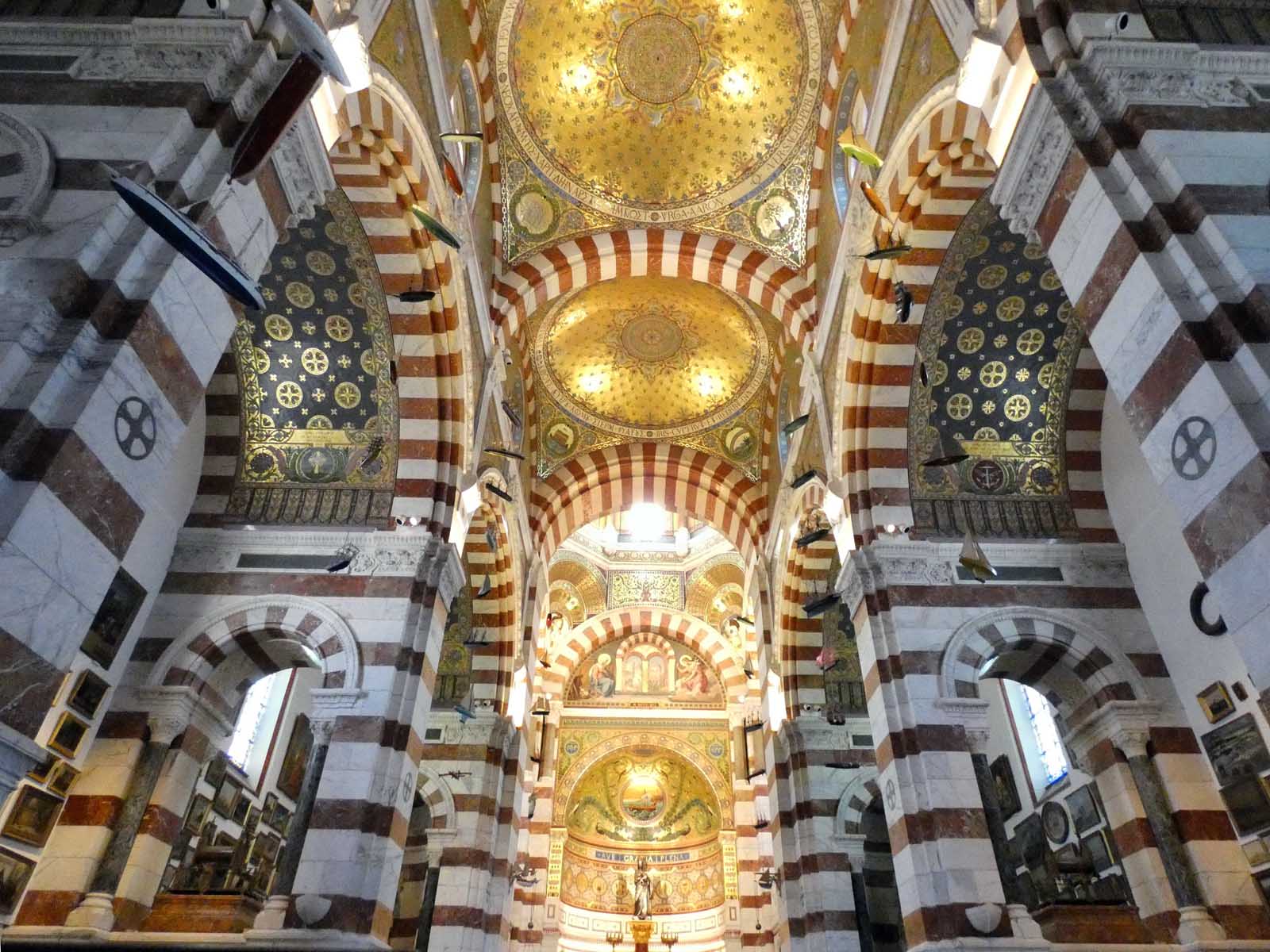
- This full-day sightseeing tour includes a visit to the basilica Notre Dame de la Garde plus many more attractions including, MuCEM and the Villa Méditerranée, Saint-Victor Abbey, and its 4th-century crypt, and much more.
5. Marseille Cathedral – Cathédrale de la Major
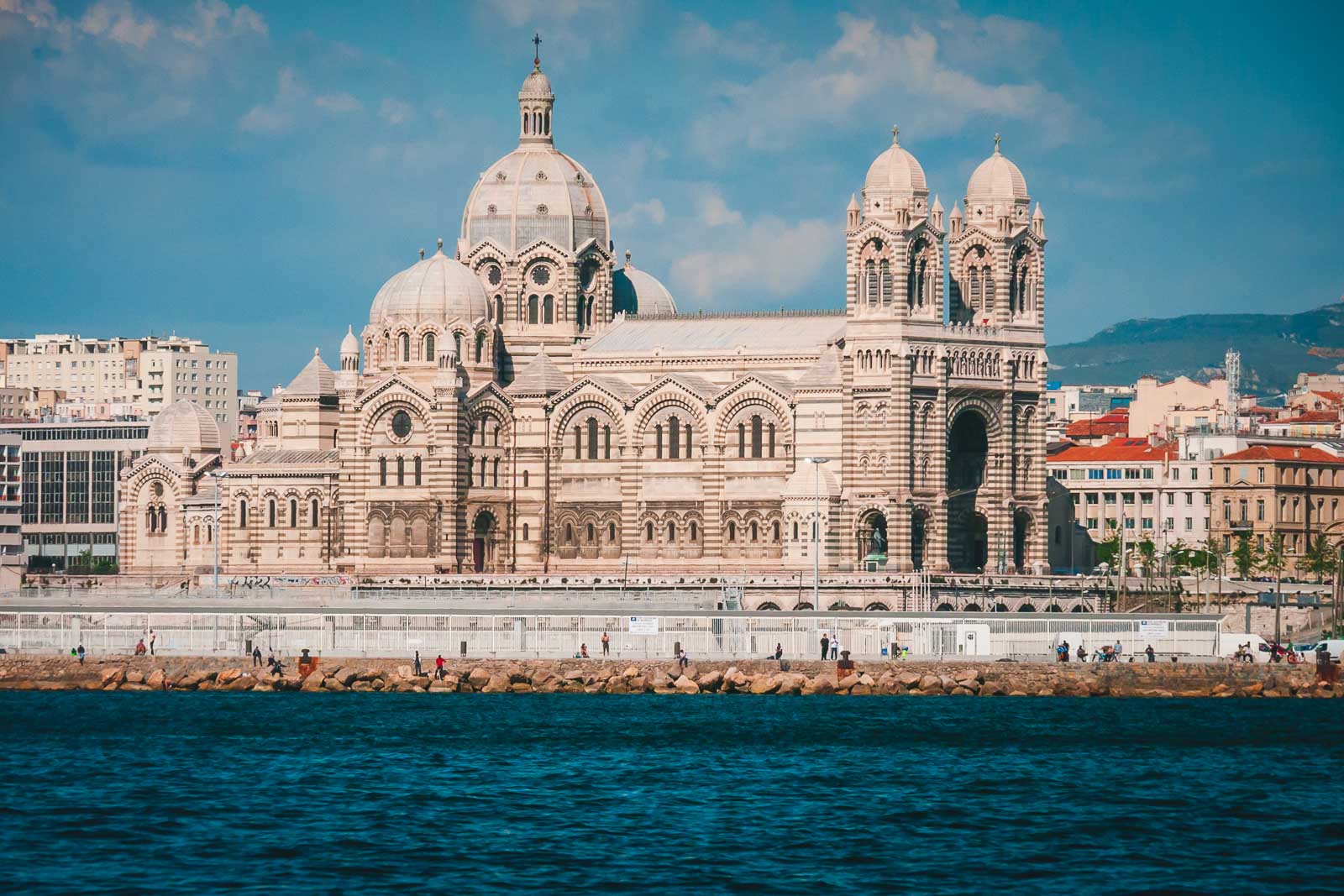
When visiting Europe, we always “find our religion” (well, at least we find an interest in seeing its monuments) Cathédrale de la Major is a beautiful monument on the waterfront dating back to the 19th century.
Like many of the buildings in Marseille, The Cathedral blends Romanesque and Byzantine styles. It is a massive cathedral spanning 141 meters (462 feet). Its dome towers reach a height of 16 meters (52 feet) This cathedral reminded us of the Duomo in Florence , but with a far more beautiful setting.
6. Parc National des Calanques
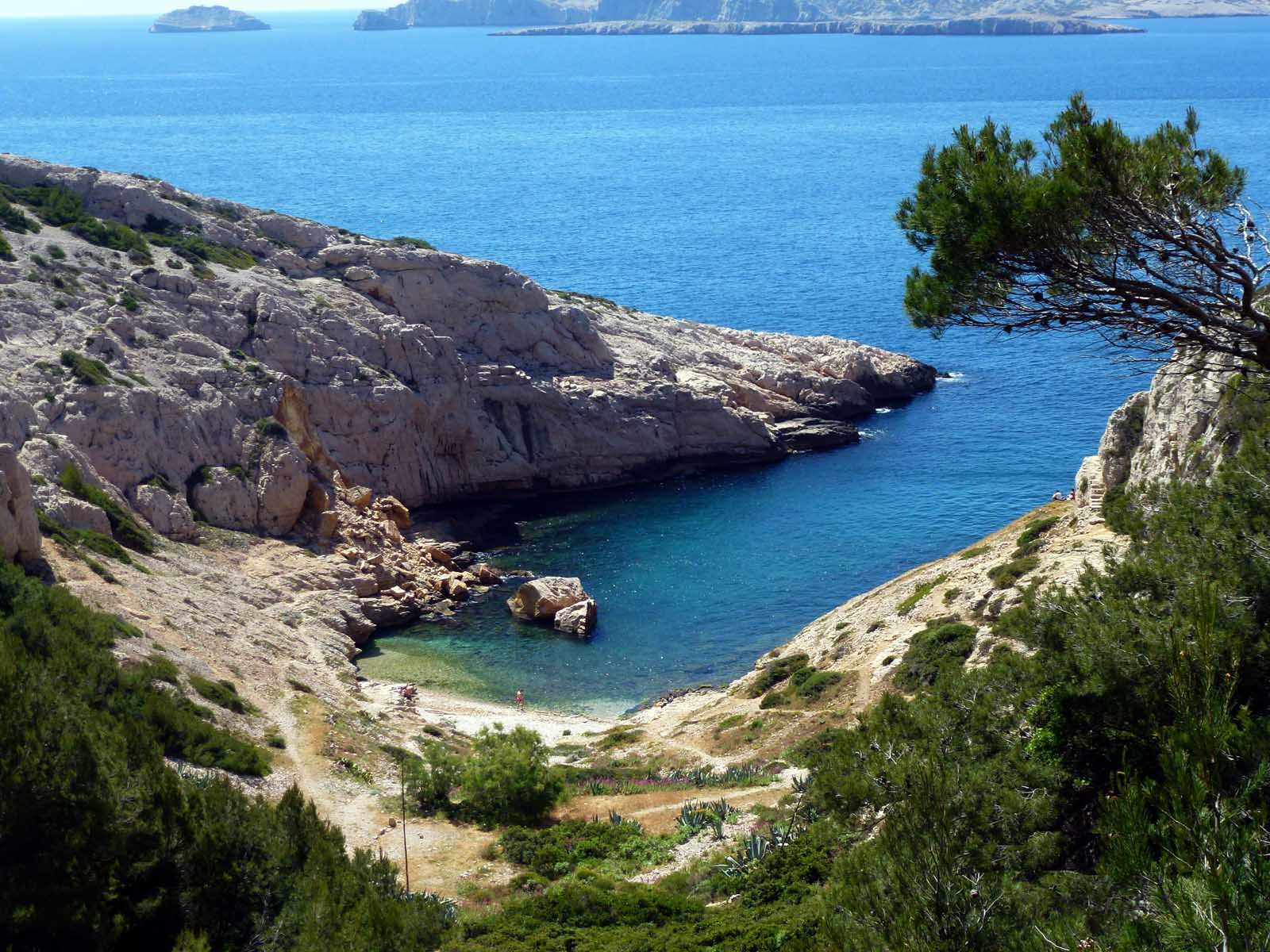
A good day trip from Marseille is Calanques National Park. It is the only national park in Europe that is located near urban areas and is both on land and sea. It is located directly beside Marseilles en route to Cassis.
Calanques National Park is a large park at 520 square km (201 square miles) and it most certainly looks like something from the Greek Islands . It was designated a national park in 2012 and has great hiking trails and areas for kayaking and exploring the limestone cliffs and quiet coves.
Take a boat ride to see the stunning coast and hidden fishing villages that line the shore. This Catamaran tour to Calanques National Park. This 5-hour tour goes along the Mediterranean Sea between La Madrague and the town of Cassis, via Les Goudes and Callelongue. It is a wonderful way to explore the coast.
9. History Museum – Musée d’Histoire de Marseille
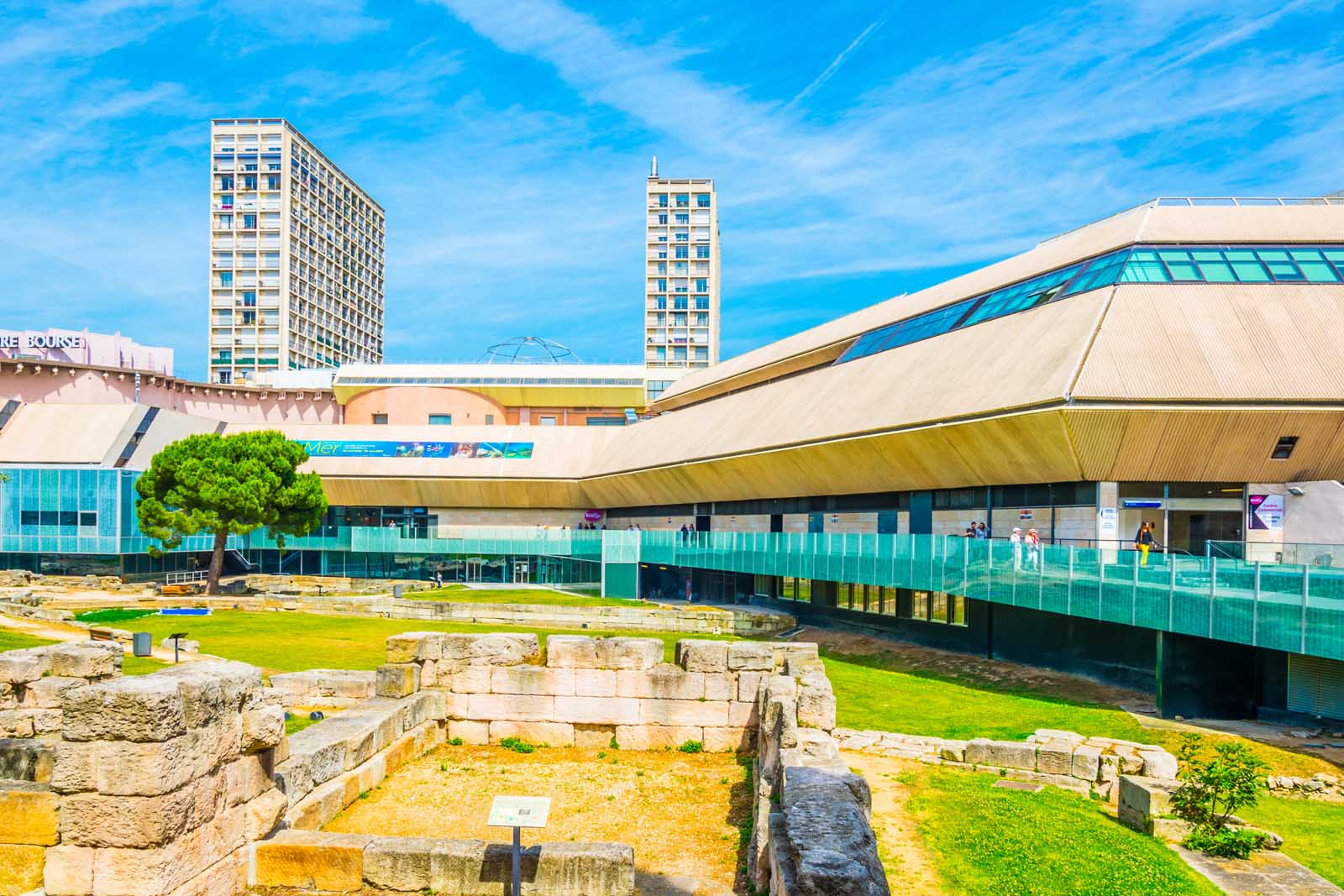
With Marseille being the oldest city in France, it is only fitting to visit the History Museum. The Musée d’Histoire de Marseille houses 4000 exhibits and interactive attractions showcasing the 26-century history of the city. Entrance to the History Museum is included in your City Pass.
10. Palais Longchamp
Palais Longchamp is a monument that was built to celebrate the completion of a long canal, The Canal de Marseille that supplies the city with water from the Durance River. It is a large green space with interconnected parks. It houses the Museum of Fine Arts dating back to 1801 and it is also home to the Natural History Museum. Its two wings are connected by a beautiful large water fountain and waterfall.
11. Abbaye Saint-Victor
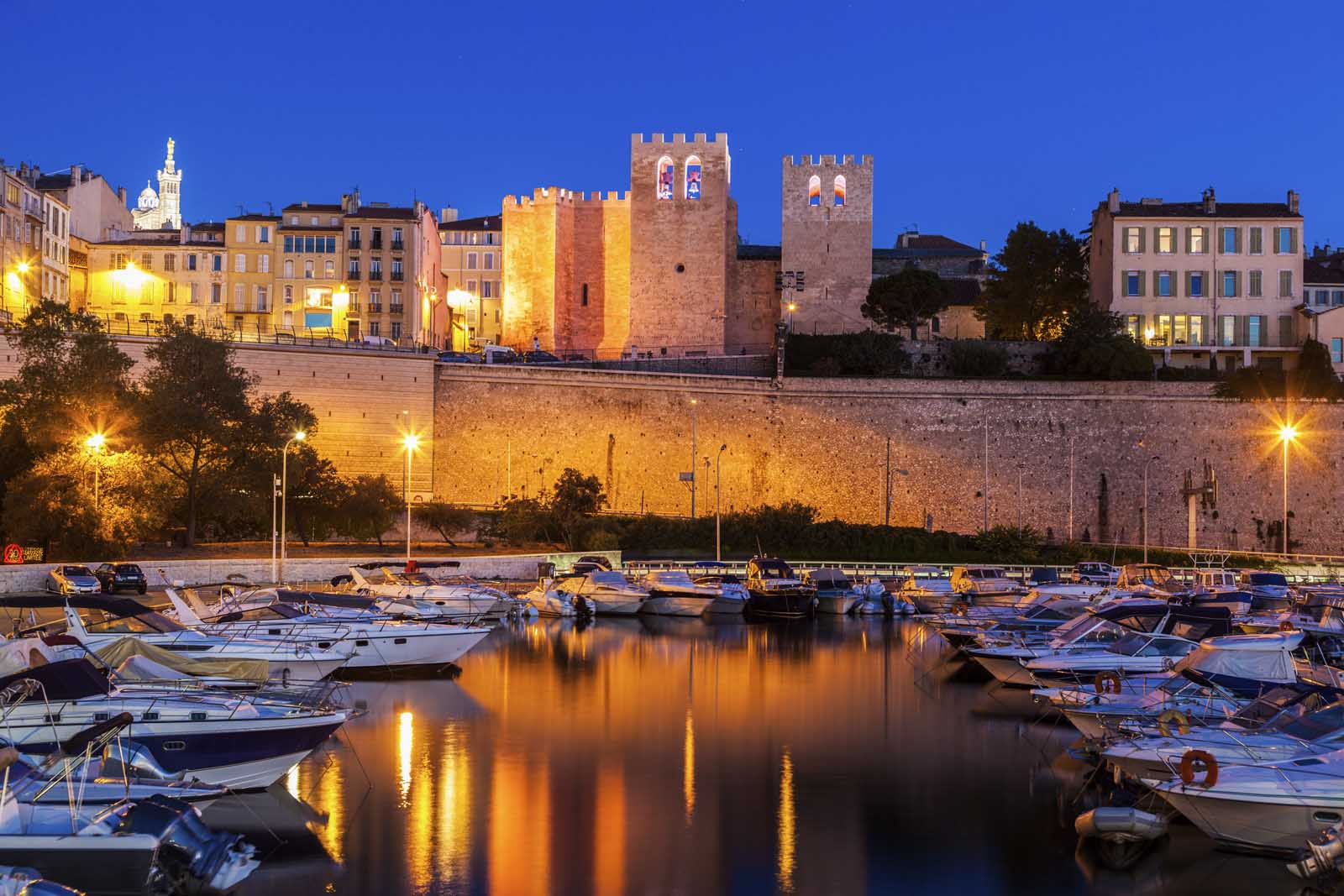
If you haven’t gotten enough of the history in Marseille, pay a visit to Abbaye Saint-Victor. Not only will you learn about the city’s religious history, but it is also an Abbey with a view. The Basilica and the crypts have beautiful views of the Old City. \
A great way to get around Marseille is to take a cycling tour . This 3.5-hour tour covers all the highlights of Marseille while taking in the fresh sea air. You’ll go through:
- The Panier Neighborhood (the oldest district of Marseille)
- The Major Cathedral
- The new MuCem Museum area
- The Old Port (the main place in Marseille)
- The Pharo (where you have a beautiful view of the Old Port)
- Malmousque Little Port
- The Vallon des Auffes
- The Kennedy Corniche
- Notre Dame de la Garde (the “bonne mère”)
- The Abbaye of Saint-Victor
12. Vieille Charité
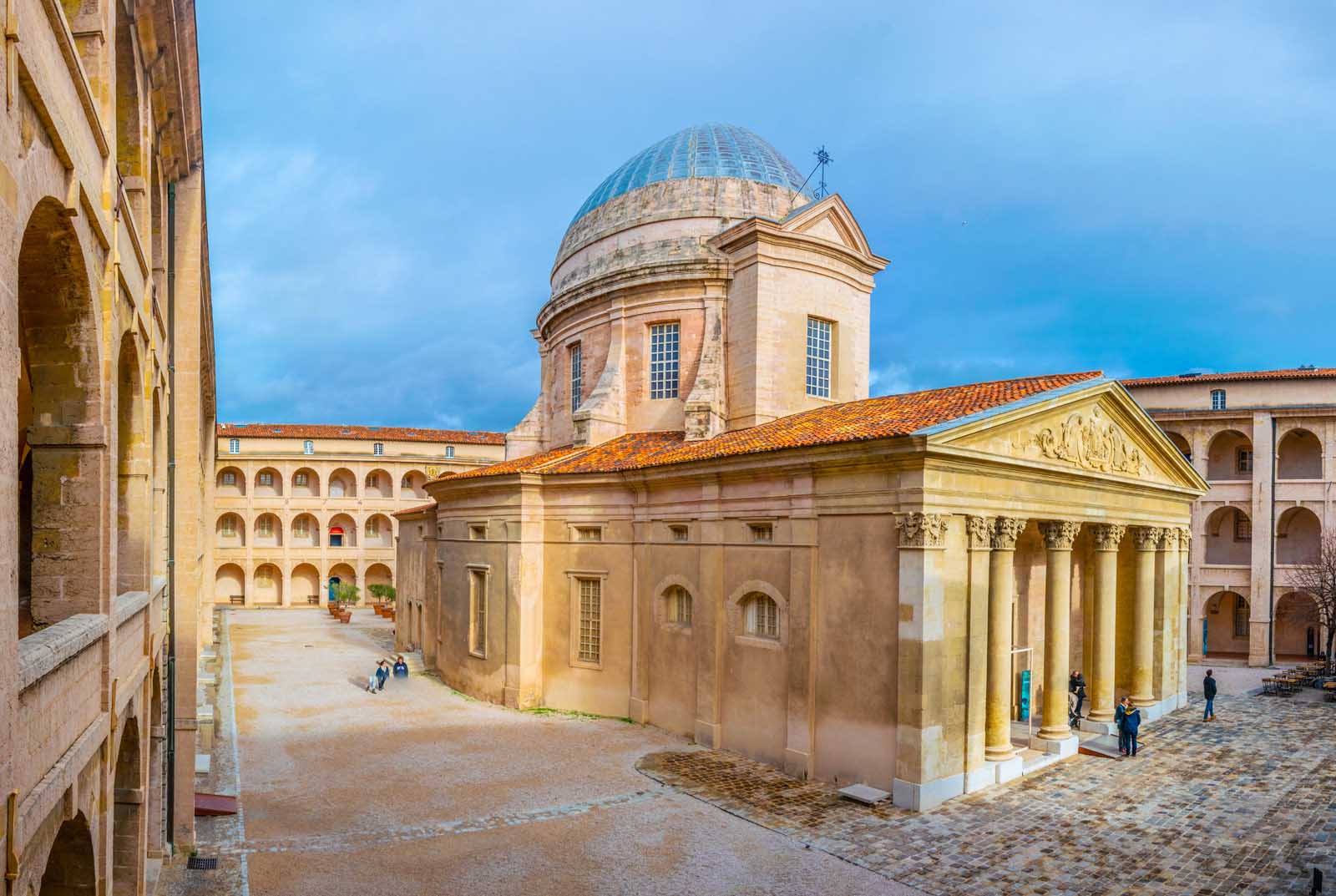
Vieille Charité was once an old almshouse (a building to help the poor) and is now a museum and cultural center. It is a hip area with a Bohemian vibe containing three tiers of art galleries, street art, and boutiques. This is a great place to get a feel for the local culture, and to do some shopping a the art market. There are many bars and cafes and it’s perfect for people watching. Plus there are two important museums in the complex, the Museum of Art of Africa and the Museum of Archaeology.
13. Parc Borély
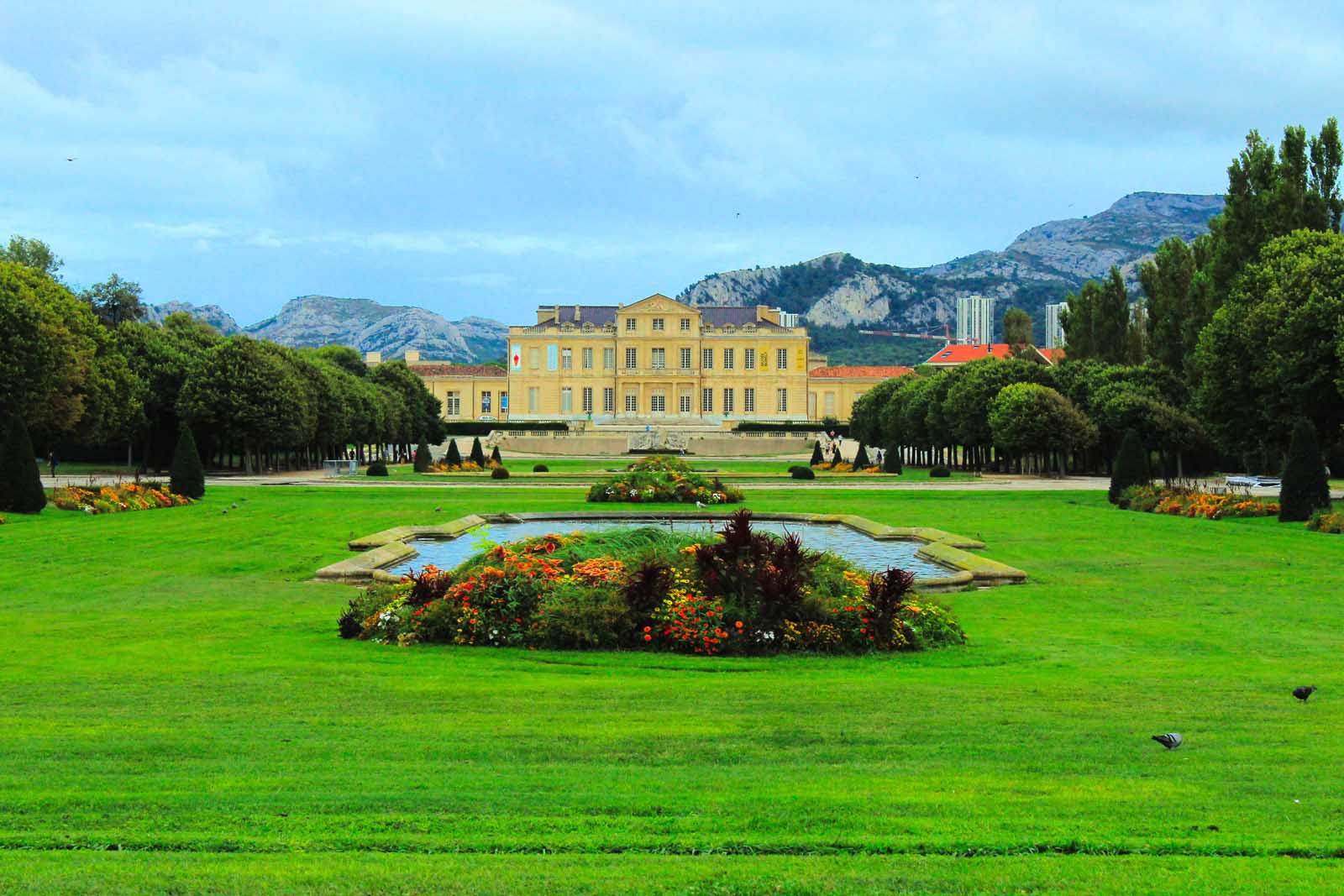
Marseilles was lovely and anyone going to the south of France should make it a stop on their list. It is filled with history, beautiful architecture, and parks. Parc Borély is considered one of the most remarkable gardens in France . It was constructed in the 17th century and is composed of three different gardens. An English Garden, a French garden, a horse racing track connected by a botanical garden.
How to get to Marseille
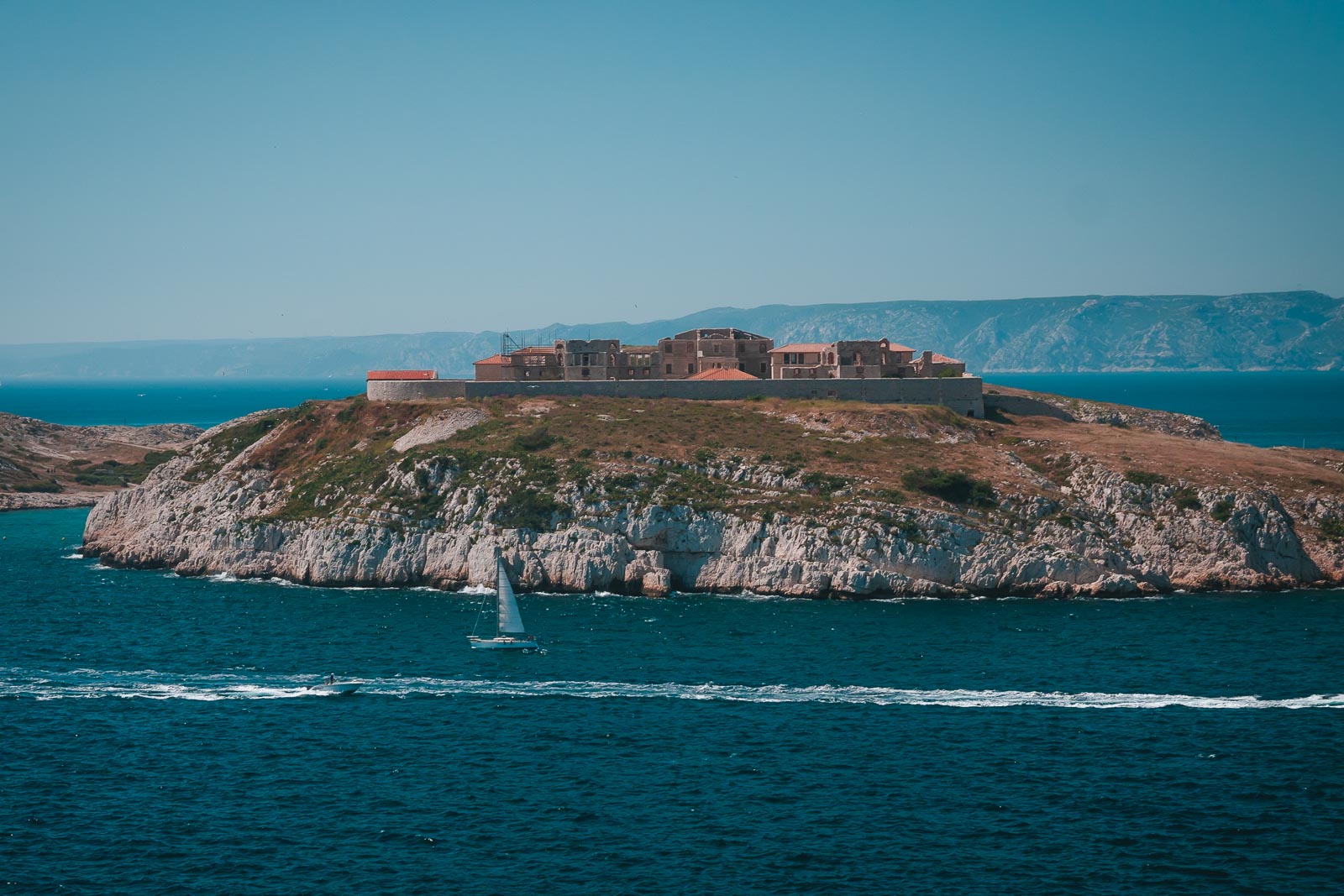
Marseille is located in the south of France and you can fly to the Marseille Provence Airport which is just 27 km away. There are flights daily from all cities in Europe. International flights to Marseille connect via London , Paris, and Dublin.
The train is one of the easiest ways to get to Marseille and there are daily trains from Paris . Marseille’s main station is the Gare de Marseille St Charles.
The main bus station in Marseille is Gare St Charle (St. Charles bus station) and arrives from all over Europe.
Where to Stay in Marseille
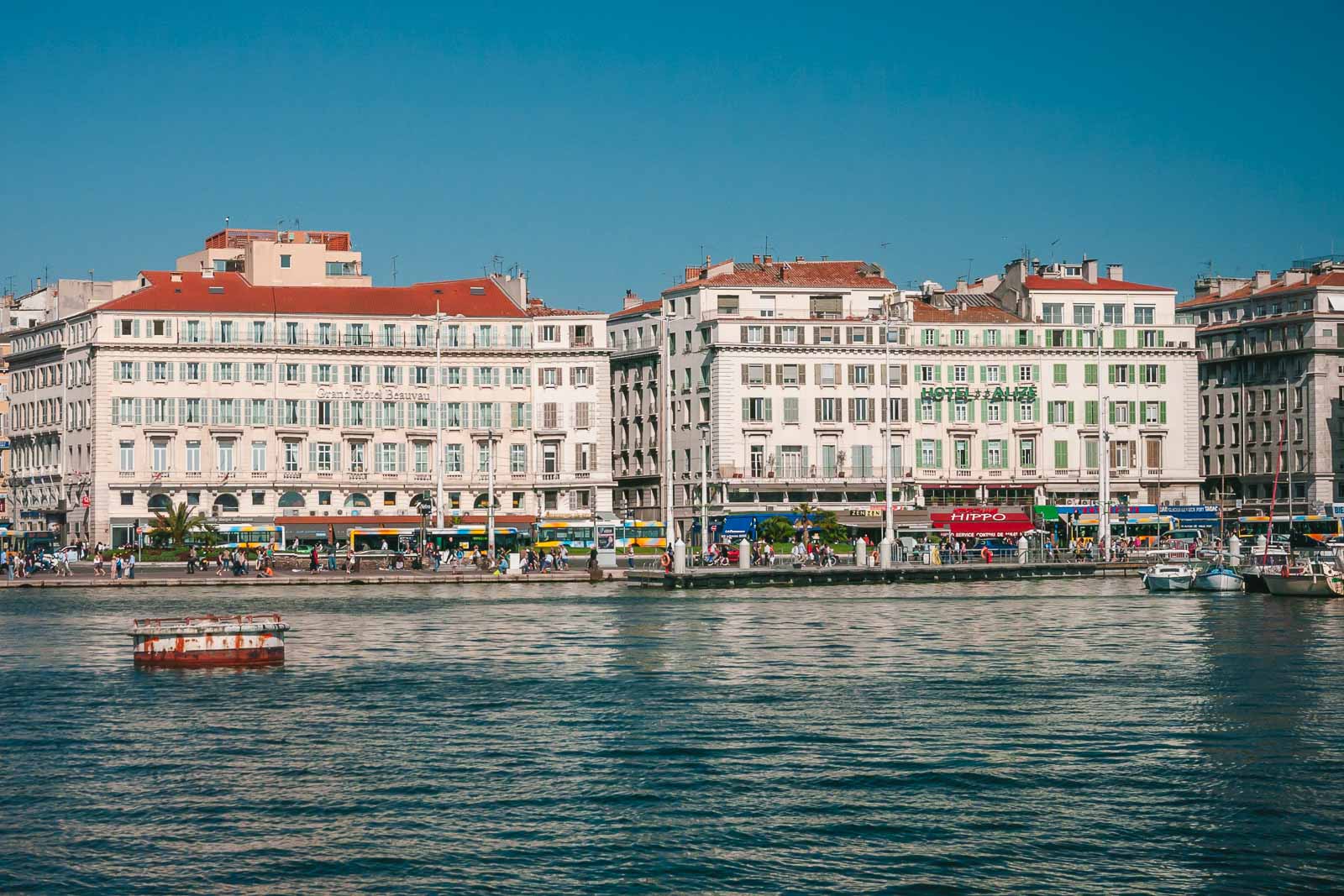
When traveling through Europe, we often stay at Ibis or Etap hotels when traveling on a Budget. Now that we are a bit older, we prefer to splurge on higher-end accommodation, but we still think these are two great hotel chains.
Vieux Port – The best area to stay in Marseille is the Old Port. It is centrally located and easy to see most of the top Marseille attractions. It can be quite noisy and busy though.
- Recommended Luxury Hotel – Intercontinental
- Recommended Budget – The Ibis Budget Hotel
Le Panier – The Old Town is another great option in the second arrondissement. Not far from the Old Port, there are several choices of accommodation. made up of three areas in Marseille and this is a good option for a quieter stay than the old port. Les Grands Carmes, Town Hall, and La Joliette.
- Recommended Luxury – Intercontinental Centre Vieux
- Recommended Budget – Ibis Centre Vieux
Train Station – This is a good option that is a more affordable area, but it is still easy to get around. We stayed at the Ibis Hotel and found it to be quite pleasant.
- Check out prices and availability on TripAdvisor
Getting Around Marseille
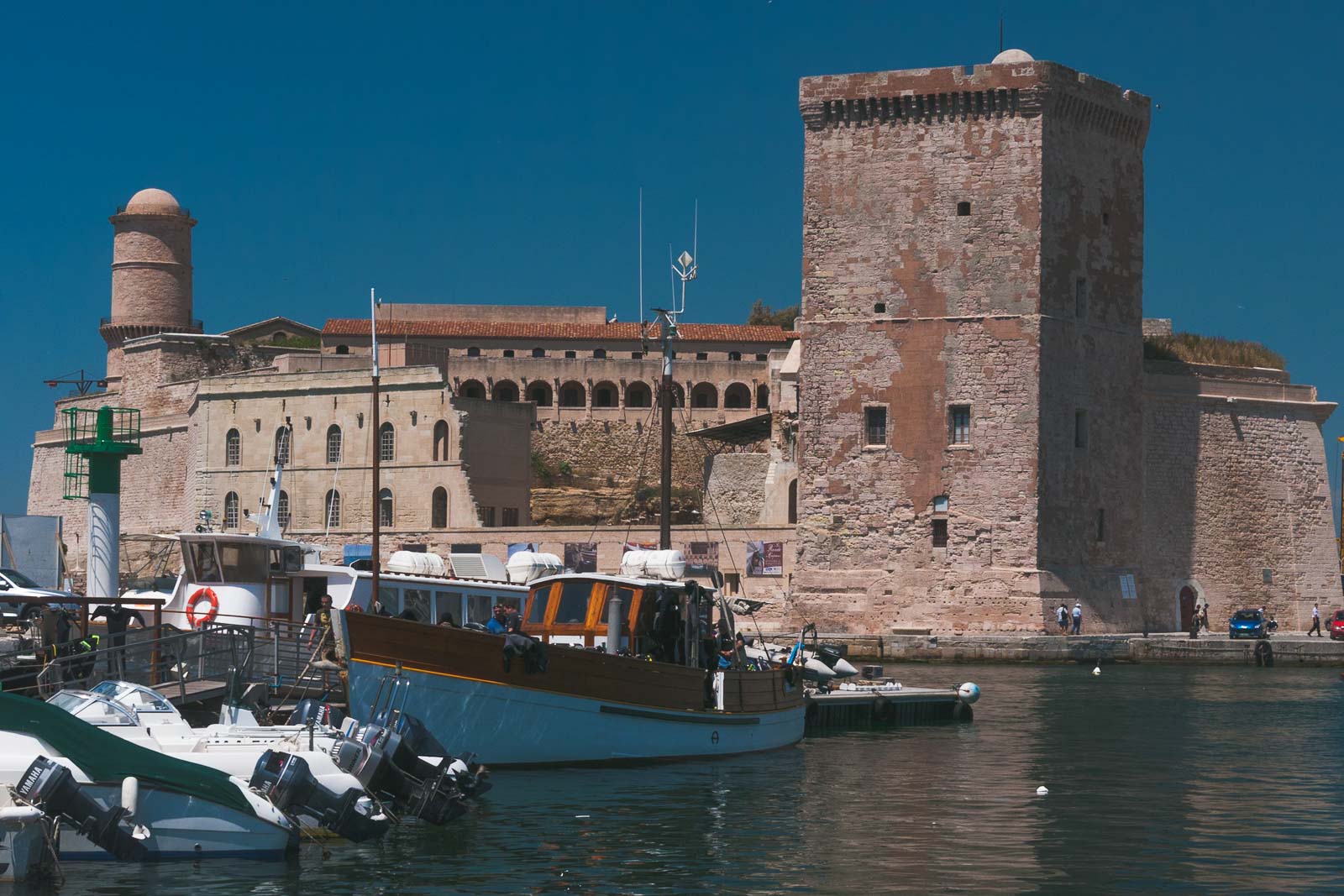
We had a car while visiting Marseille, but traffic was busy, so we parked it and mostly walked. But because we had a car rental so we were very mobile in Marseille and had the freedom to stay outside the city while traveling on a Budget.
If you don’t want to walk, a Marseille City Pass is a great option. It lets you Ride Marseille’s public transport for free. Passes can be bought for 24, 48 or 72 hour and cover:
- Free access to Marseille’s museums including – the Marine Museum, Natual History Museum, Fine Arts Museum, Palais Longchamp, and more.
- A Ride on the train to Notre-Dame de la Garde or le Panier old town
- Get tastings and discounts in certified boutiques.
Plan your Trip to France With These Resources
- French Food: 24 Traditional Dishes To Try in France or At Home
- 22 Beautiful Cities in France To Visit
- 11 Interesting and Fun Facts About France
- Where To Stay In Paris – Best Neighborhoods and Hotels Updated
- 3 Days in Paris: The Best Paris Itinerary for Your First Visit
Travel Planning Resources
Looking to book your next trip? Why not use these resources that are tried and tested by yours truly.
Book Your Flights: Start planning your trip by finding the best flight deals on Skyscanner. We have used them for years and have found that they have the best flight deals.
Book your Hotel: Find the best prices on hotels with these two providers. If you are located in Europe use Booking.com and if you are anywhere else use TripAdvisor.
Find Apartment Rentals: You will find the cheapest prices on apartment rentals with VRBO .
Travel Insurance: Don't leave home without it. Here is what we recommend:
- Safety Wing - Occasional Travelers.
- Medjet - Global air medical transport and travel security.
Book Your Activities: Looking for walking tours, skip-the-line tickets, private guides, and more? Then we recommend Get Your Guide.
Need more help planning your trip? Make sure to check out our Resources Page where we highlight all the great companies that we trust when we are traveling.
You May Also Like

Where To Stay In Paris – Best Neighborhoods To Suit Your Travel Style
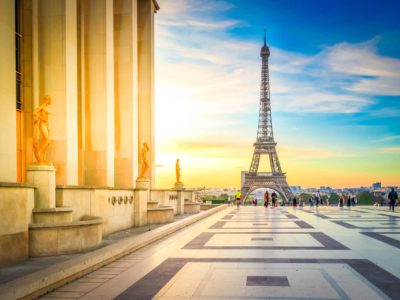
Is Paris Expensive to Visit? Trip Costs And Budgets

20 Best Museums in Paris To Visit in 2024
About The Planet D
Dave Bouskill and Debra Corbeil are the owners and founders of The Planet D. After traveling to 115 countries, on all 7 continents over the past 13 years they have become one of the foremost experts in travel. Being recognized as top travel bloggers and influencers by the likes of Forbes Magazine , the Society of American Travel Writers and USA Today has allowed them to become leaders in their field.
Join thousands of others who get our monthly updates!
Leave a comment cancel reply.
Save my name, email, and website in this browser for the next time I comment.
20 thoughts on “14 Best Things to do in Marseille, France”
We just returned from a two week stay in Marseille, absolutely loved it. We rented an AirBNB near La Pointe Rouge right across the road from the beach, just south of Parc Borely (a great spot!). We had a wonderful experience, and it’s interesting how many people have expressed surprise at us choosing Marseille for two weeks. We did not once encounter a local who was not kind, gracious, helpful, courteous and friendly. We hired a wonderful driver and professional tour guide and explored Aix-en-Provence and Chateauneuf-des-Papes, with several private winery visits and tastings. We spent the whole day on a Catamaran in Calanques National Park. We attended an entire day market visit and cooking (and then eat what you cook!) class. We bused (line 19 took us everywhere we needed to go) up to the City Center, seeing Le Panier, Notre Dame, Old Port, Boulevard Longchamps, and our favorite but not mentioned in your article: Le Cours Julien (loads of street art, fun vibe, wonderful cafes, outdoor farmer’s market, indie shops). We had some great food, the seafood is second to none. Being on the beach was wonderful and was very enjoyable when we had some down time. This trip occurred during the sad aftermath of the 2023 police shooting in Nanterre, and we did not personally encounter any problems as a result of the nightly riots. Like anywhere, Marseille requires being smart about one’s surroundings, but being from Detroit this is normal way of life for us. I wouldn’t hesitate to recommend Marseille to anyone. The City itself has much to offer and the City was a great jumping off point for a southern France vacation.
Thank you D&D for your inspiring post! I am planning to spend 6 to 7 days in Marseille and Provence in the spring and would like to know are there any multi-day tours to book, offering sightseeing of several places in one trip. I don’t want to rent a car, but want to move around the area. Thanks for your answer.
I’m surprised nobody here mentionned the Calanques of Marseille. They are probably the beautiful part of the city, at only 10-15 minutes of downtown. They are a sort of mediterranean fjords completely wild, still very well preservered despite of tourism.
Look at theses http://www.google.com/images?q=calanques+marseille ! All visits in Marseille should include a day in the calanques !
Marseille is a very unique City in France… Glad to hear you liked it 😉
Hi! I am going on holiday to Marseille in 2 days, looking forward to it, even more after reading this blog! Henriette
These photos are very impressive. Thanks for sharing experiences from your Marseilles trip. .-= PA Injury Attorney´s last blog ..Congressional candidate in car accident =-.
Thanks! It is easy to be inspired with beautiful scenery.
We only made it as far south as Lyon… we heard the same rumors about Marseille and decided to skip it. I’m glad it was a positive experience for you guys, now I’m kinda kicking myself! Maybe next time 😉 .-= Cam´s last blog ..Photo of the Week: Sydney Harbour, Australia =-.
Don’t worry Cam. We skipped a tonne of things. We would be black and blue if we kicked ourselves for all the things we missed:-) Besides, I bet you saw amazing places that we didn’t get a chance to see.
The port was a real surprise for me as well. I never made it out to the island but I took a walk up the hill to the Notre-Dame de la Garde, which has great views over the whole city.
Looks awesome! I may have to throw France into our European adventure! .-= Bethany´s last blog .. Interview with Bernard & Danielle from BorderJumpers.org =-.
I know how you feel. We kept adding countries and cities into our itinerary. There is so much to see in Europe. We need a couple of years to explore!
I love those grass chaise lounge chairs. I want to test that out! .-= Laura´s last blog .. Rwanda Gorilla Tracking: Taking the Plunge =-.
Those chaise lounge chairs looked awesome eh! I just loved how beautiful everything was in Marseille, they have really thought about making people comfortable. Park benches were everywhere, a park was in the middle of the city and people were having picnics on the dock. Fabulous.
Well that will teach me to not listen to the naysayers! We clearly made a mistake by choosing to bypass Marseille a few years ago when we were in France – after spending 2 weeks working our way from Monte Carlo down to St. Tropez, we headed inland up through Avignon to Paris – all that we had heard of Marseille at the time was that it was crowded and dirty – now I’m bummed that we missed out on such a jewel along the coast! I will definitely have to visit Marseille next time I get to the Mediterranean.
As usual, gorgeous photos! .-= Trisha Miller´s last blog .. The Power Of Print =-.
I had read some things that Marseille was a rough place but apparently they have cleaned it up. At least the waterfront anyway. We loved it! But there are many other amazing places in on the Mediterranean and we just can’t see them all.
Thank first picture of the port is freaking amazing. I was only ever in Brittany, which had mostly the same climate as Newfoundland. How cool to be next to the Mediterranean just on the other side of the country… .-= Candice´s last blog ..Sometimes Growing Up in a Bilingual Country Sucks =-.
It is pretty amazing. You never would think that France would have such a diverse landscape and climate. But we witnessed that during our short time there. It is an amazing country that we want to go back to and really spend some time in. Maybe I will learn french there for a year!
That panoramic shot is just stunning and exploring all of the history around the town and in the old prison sounds like amazing fun 🙂
The prison was pretty cool. I didn’t know Chateaux d’If was real. I always thought that it was fictional!
🙌 Awesome, you're subscribed!
Thanks for subscribing! Look out for your first newsletter in your inbox soon!
Get us in your inbox
Sign up to our newsletter for the latest and greatest from your city and beyond
By entering your email address you agree to our Terms of Use and Privacy Policy and consent to receive emails from Time Out about news, events, offers and partner promotions.
Awesome, you're subscribed!
The best things in life are free.
Sign up for our email to enjoy your city without spending a thing (as well as some options when you’re feeling flush).
Déjà vu! We already have this email. Try another?
Love the mag?
Our newsletter hand-delivers the best bits to your inbox. Sign up to unlock our digital magazines and also receive the latest news, events, offers and partner promotions.
- Los Angeles

The 5 best beaches in Marseille for sand, sea and sunsets
Marseille ain’t just a city break, and these brilliant beaches prove it
Marseille does it all. And since France’s second biggest city has officially blown up over the last few years, it’s most definitely no secret. And even if you didn’t come here just for the beaches, trust us, no trip to Marseille is complete without visiting least one of ‘em.
As soon as you’re here, you’re in very close proximity to the sea. But that doesn’t mean all stretches of sand here are created equal. Marseille’s beaches aren’t the huge, sprawling, traveller-packed beaches you head to Greece for: these beaches are calmer, tucked away behind sleepy towns and (most of the time) not jam-packed with tourists. Ready for a swim? Here are the best beaches in Marseille.
RECOMMENDED: 📍 The best things to do in Marseille 🍴 The best restaurants in Marseille 🍕 The best pizza in Marseille 🏘️ The best Airbnbs in Marseille
Virginie d’Humières is a writer at Time Out Marseille. At Time Out, all of our travel guides are written by local writers who know their cities inside out. For more about how we curate, see our editorial guidelines . This guide includes affiliate links, which have no influence on our editorial content. For more information, see our affiliate guidelines .
Been there, done that? Think again, my friend.
Best beaches in Marseille
1. la plage de maldormé.

Best for: fresh fish and proper beaching
Found in the Malmousque neighbourhood, you have to leave Kennedy Corniche via a steep path to find this pebble beach located in the Maldormé cove, just a short swim from Gérald Passedat’s Petit Nice. Accessible by a flight of stairs and sheltered from the wind, this is a charming but small beach that gets crowded in summer. Overlooked by the famous yellow house (every local you’ll meet has an opinion on its potential owners), this cove attracts both old and young fans of cool water swimming – the beach is in the shade in the afternoon. To complete the experience, eat at Poissonnerie Kennedy , opened by Georges Mohammed-Chérif, offering a takeaway platter of shellfish and seafood, including pearly langoustines, red prawns, fine de claire oysters and whelks. If you’re more of a pizza person, make a stop at L’Eau à la Bouche , a true Marseille institution.
2. La plage du Bain des Dames

Best for: discovering local secrets
After passing the large beaches of Pointe-Rouge, we absolutely love this discreet cove with a hell of a lot of charm and some cute cabins still used by their very lucky owners. Not well known to tourists and therefore less crowded than the city centre beaches, this sandy and stoney beach is a hotspot for an aperitif thanks to its sunset views, plus its got clear water, an insane view of the Marseille harbour and its pretty tranquil all year round. If you’re lucky, you might even be invited by the cabin owners to grill some fish! There’s parking just above the beach, so coming by car is easy, or you can cycle to Parc Pastré and walk from there.
3. La plage du Prophète

Best for: kids and families
Below the Corniche in the Roucas-Blanc neighbourhood lies Plage du Prophète, one of the few natural sandy beaches close to the city centre and one of Marseille’s oldest (locals still disagree on its name’s mysterious origin). Protected from seaweed by a breakwater built in the late 19th century – look out for the rock dedicated to Josiane – this sandy strip offers two access points to the sea. On the right, near the port, you can dip into the shallow water. In front, the entry is a bit trickier due to pebbles and rocks, so come prepared. Bathed in sunlight from morning to evening, with showers and volleyball courts, this is a great family beach (or just for those tired of rocky shores), but heed our warning: it’s best avoided on windy days. Open all year round, La plage du Prophète is supervised and gets busier in summer when the snack bar and Chez Marco trattoria under the Corniche open.
4. La plage de l’Abri Côtier

Best for: a slice of peace and quiet
On the road to Les Goudes in the Montredon neighbourhood, you’ll find this intimate beach, named after a restaurant that operated in a small hut for nearly 40 years until it was closed in 2018 due to coastal law regulations. While many mourned its demolition, this (let’s say it) paradisiacal beach with its turquoise waters remains a favourite among Marseille families, who found some comfort in the opening of the Cabanon de Paulette , set up in Jean-Paul Dinoia’s old boat garages – he was the owner of the former restaurant. It’s relatively quiet until summer, but is best enjoyed early in the morning if you’re looking for shade or at aperitif time for the sunset. And if you’ve forgotten your book, don’t worry – rectify it at independent bookstore MiMA just above. A little slice of happiness.
5. La plage de la Bonne Brise

Best for: nature and views
Also known as Plage de la Verrerie in tribute to the former nearby factory or Plage à Dédé, in memory of a legendary pizzeria demolished in 2013, this beach is perhaps one of the city’s least famous and best preserved, at least outside the summer season (probably best avoided in July and August). To find it, you need to leave the road to Les Goudes, park in the elevated parking area, and then descend a wide but narrow staircase. Upon arrival, you’ll be instantly charmed by this large natural sandy beach, lined with residential huts. Shaded in the morning, you’ll see a great sunset when it happens. beautiful sunset at the end of the day. Swimming is relatively easy though unsupervised, but avoid it on mistral days when the currents can be strong. And if you feel like a bit of culture before leaving, make sure to visit La Cabane Georgina , an artist residence just a short walk away. A perfect blend of nature and culture.
[image] [title]
Discover Time Out original video
- Press office
- Investor relations
- Work for Time Out
- Editorial guidelines
- Privacy notice
- Do not sell my information
- Cookie policy
- Accessibility statement
- Terms of use
- Modern slavery statement
- Manage cookies
- Advertising
- Time Out Market
UK Edition Change
- UK Politics
- News Videos
- Paris 2024 Olympics
- Rugby Union
- Sport Videos
- John Rentoul
- Mary Dejevsky
- Andrew Grice
- Sean O’Grady
- Photography
- Theatre & Dance
- Culture Videos
- Fitness & Wellbeing
- Food & Drink
- Health & Families
- Royal Family
- Electric Vehicles
- Car Insurance Deals
- Lifestyle Videos
- UK Hotel Reviews
- News & Advice
- Simon Calder
- Australia & New Zealand
- South America
- C. America & Caribbean
- Middle East
- Politics Explained
- News Analysis
- Today’s Edition
- Home & Garden
- Broadband deals
- Fashion & Beauty
- Travel & Outdoors
- Sports & Fitness
- Climate 100
- Sustainable Living
- Climate Videos
- Solar Panels
- Behind The Headlines
- On The Ground
- Decomplicated
- You Ask The Questions
- Binge Watch
- Travel Smart
- Watch on your TV
- Crosswords & Puzzles
- Most Commented
- Newsletters
- Ask Me Anything
- Virtual Events
- Wine Offers
Thank you for registering
Please refresh the page or navigate to another page on the site to be automatically logged in Please refresh your browser to be logged in
I holidayed in France’s ‘most dangerous’ city and came away unscathed – and enamoured
Tourists shouldn’t be deterred by marseille’s dicey reputation, says natalie wilson after a très bien trip, article bookmarked.
Find your bookmarks in your Independent Premium section, under my profile

Sign up to Simon Calder’s free travel email for expert advice and money-saving discounts
Get simon calder’s travel email, thanks for signing up to the simon calder’s travel email.
D on’t google Marseille before you go. Especially, if you’re a woman, solo traveller or both.
Headlines of the horrors in France ’s ‘most dangerous city’, ranked as such by several crime indexes, have long slapped a crime capital label onto the Provence port.
Violence and gang activity are among the long list of problems cited as risks to tourists visiting Marseille by the Numbeo database – the city earned a crime rating of 65.9 in 2024.
Given that a cancelled taxi – pre-booked and over €300 to travel just 20 minutes – resulted in threats to send men to our Airbnb and a blocked number before we had even left for the airport, I’d braced to land someplace sketchy. Annoyingly, I was grateful to be travelling with two men.

As France’s oldest city, Marseille has influences from its Greek settlers, Moroccan immigrants and former French colonies in Africa shaping much of the port’s 2,600-year history. I was visiting with family to experience Marseille’s Olympic offerings, trading athletics in the French capital for sailing in the French Riviera .
Read more on France travel :
- Where to eat, sleep and drink in France’s cool, coastal second city
- Why I chose Marseille over Paris for the Olympic Games
- The best hotels in Paris: From Eiffel Tower views to luxury
It’s embarrassing now to admit my efforts to create an itinerary for the weekend had me clutching a zipped Uniqlo bag, bought specifically for this trip, with my phone stashed away for much of my evening in old town Le Panier. This meant an insufficient number of pictures of the undeniably pretty port city and a sore neck from constantly looking over my shoulder.

Given the recent warning of phone snatchers on mopeds stationed outside my London office, this was a over-the-top reaction to the threat of petty theft that all city dwellers face daily.
As such, general Foreign Office (FCDO) advice for France encourages British tourists to take the usual package of travel precautions: “There is a high threat of terrorist attack globally affecting UK interests and British nationals.”
“Stay aware of your surroundings at all times” and “be vigilant in public places”.
The same advice is issued for holiday hotspots Spain, Greece and Portugal – all popular destinations, usually booked without safety reservations.
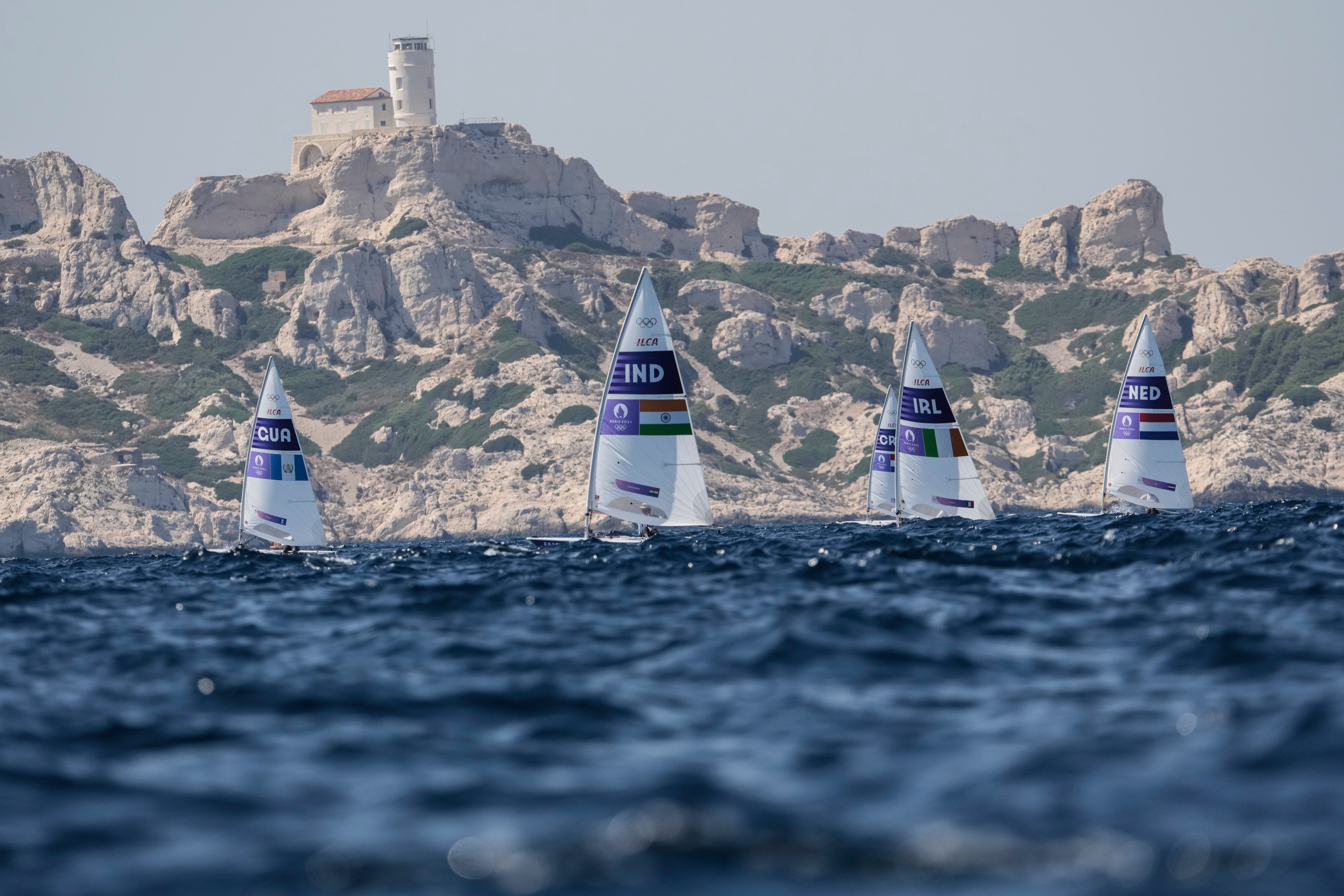
After my first day at the sailing floated by uneventfully (bar the lack of wind) I started to get over the danger label and treat the trip as I would any European city break, admittedly still slightly wary of watching an Olympic football game the next night.
Last September, Brighton and Hove Albion fans were warned to “expect a hostile atmosphere“ at an October match playing the Orange Vélodrome.
At the time, Adrian Morris, head of safety and security for the club told BBC Radio Sussex that the reality was French concerns surrounding British behaviour: “In Marseille, the police have had so many problems over the years with teams that visit, that they use these measures to try and keep the fans safe.”
As the first full-scale football match I had ever watched, any football hooligan fears from past coverage of matches at the stadium were obviously misplaced given the event – a half-full Canada v Germany women’s quarter-final on the Olympic programme.
The game kicked off without a hitch, as did every meal, stroll, boat trip and taxi ride.

A short drive down the coast from the pastel marina of Cassis and the blues of the Calanques National Park, Marseille is a functional city where people live and work. A maze of colourful streets, fromageries and clear coastline where I ate an ungodly amount of burrata.
If it was a case of a city cleaning up its act to host a handful of Olympic events, then it scrubbed up very well. French President Emmanuel Macron had pledged €1.5 billion to tackle the culture in Marseille, making efforts to improve education, housing and safety in 2021.
There is still organised crime and gang violence, that’s a fact, but the scary statistics promising sketchy encounters on every rue failed to materialise.
Sure, heed advice to avoid the northern quarters in the same way a quick search of London would advise you to tread carefully as a tourist in Westminster, but it would be foolish to write off Marseille for a weekend away.
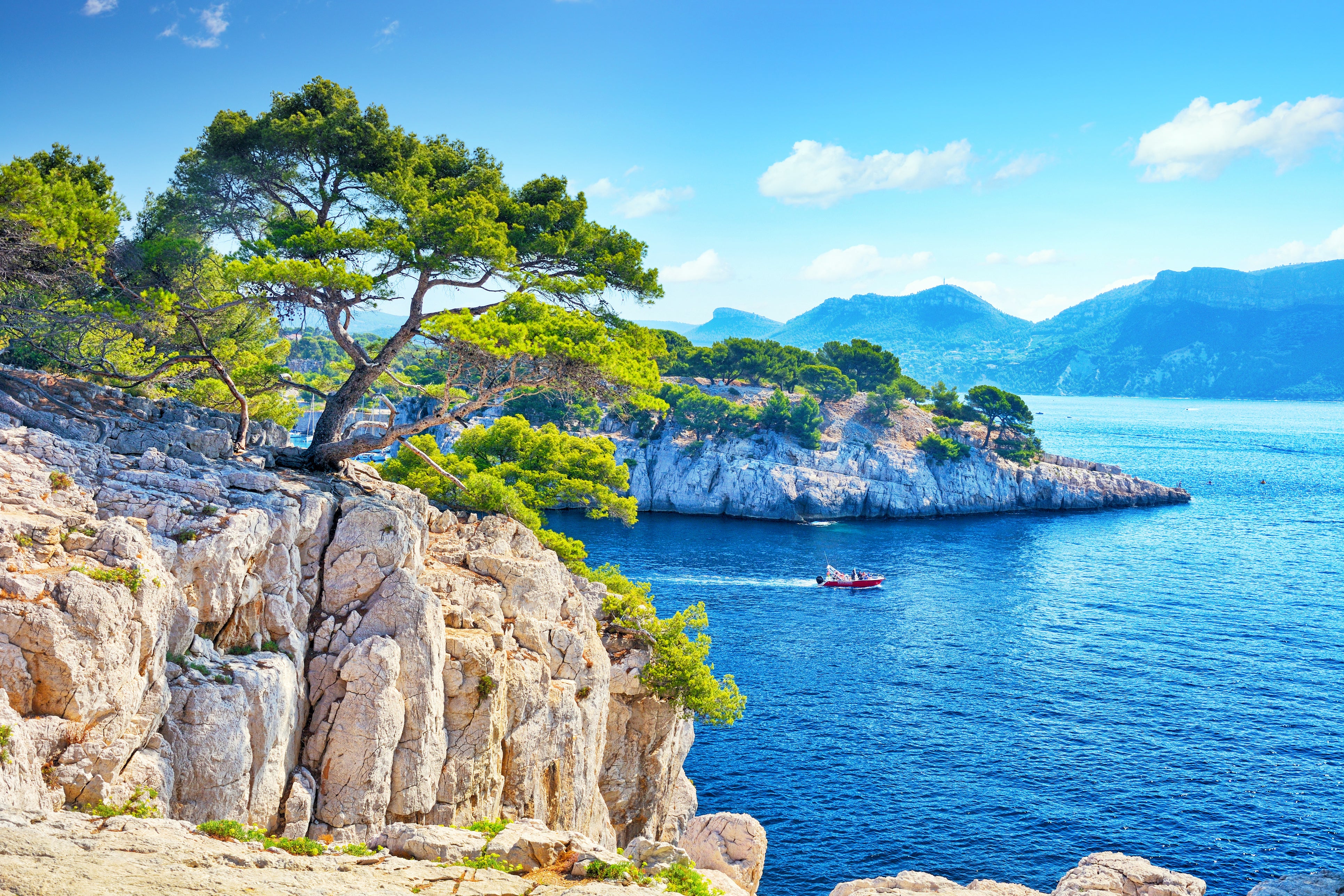
The intense heat and dry baguettes on the menu at the sailing felt far more dangerous to my well-being than any interactions I had. In contrast to the blunt, snobby stereotype, these were some of the friendliest French people I’ve ever met.
By the end of the weekend, I was asking locals in broken French to watch my bag on the beach while I went for a dip in the Med. A far cry from the pathetic phone-hiding attempts I’d made at the start of the trip.
If you take reasonable precautions, as you should on any city break, you’ll find an unpretentious, rough-around-the-edges but still stunning slice of the south of France.
Prospective travellers – free yourselves from the shackles of the search bar and plan a stay in Marseille. It’s worth it.
Read more: The ultimate France travel guide: Everything you need to know before you go
Join our commenting forum
Join thought-provoking conversations, follow other Independent readers and see their replies
Subscribe to Independent Premium to bookmark this article
Want to bookmark your favourite articles and stories to read or reference later? Start your Independent Premium subscription today.
New to The Independent?
Or if you would prefer:
Hi {{indy.fullName}}
- My Independent Premium
- Account details
- Help centre
The best times to visit Marseille, from summer parties to winter sightseeing

May 2, 2022 • 6 min read

The small fishing harbor of Vallon des Auffes, in the 7th arrondissement of Marseille © Boris Stroujko / Shutterstock
Summer is the traditional time to visit this sun-blessed city on the Mediterranean: its big blue sea is toasty warm, urban beaches sizzle with outdoor action, festivals are a dime a dozen, and dancing spills across the sand and on starry rooftops after dark. The party vibe rocks.
Yet there is far more to France’s second-largest city than worshiping the hot southern sun and hobnobbing until dawn. Marseille sports an intriguing portfolio of museums covering everything from fine art, archaeology and history to subaquatic sculpture, street art and soccer – a joy to explore any time of year.
Throw in the city’s impressive cultural agenda – from sacred to electronic music and hip hop, music festivals are multicultural Marseille’s lifeblood – and the region’s bumper harvest of seasonal produce, and you could well be tempted to rethink when you visit. For nature lovers in town for horticultural exotica or seafaring adventure along a bewitching coastline beaded with cliffs and coves, spring and fall are best. Or perhaps you’re a sea urchin or tripe aficionado? To decide your peak season, this is what you need to know...

High season: June to August ushers beach life and parties on the sand
High season means uncomfortably hot city temperatures – 35°C is fairly common at noon – and urban beaches packed with holidaymakers. The summer festival season is in full swing, with bags of open-air film screenings, rooftop concerts and dance parties to entertain. Hotels and hostels are fully booked, with rates at a premium.
Shoulder season: April, May, September and October are mellow months to visit "sans le crowd"
Shoulder-season temperatures are pleasantly balmy, the school-holiday crowd is yet to descend on the coast, and street markets are heaped with fresh produce from all over Provence. It’s warm enough to swim in the Med and hike along the coast without melting. Spring blooms and autumn foliage cast city parks and gardens in an exquisite light.
Low season: November to March is best for sightseeing on the cheap
The bitterly cold mistral wind whips through the city. Locals button down the hatches and hibernate. The few tourists around revel in exploring near-deserted museums and monuments. Hotel rates are at their lowest, and attractions open shorter hours. Beach restaurants and bars, rooftops and seaside addresses close for winter.

Enjoy solitary January strolls
The very occasional snow flurry might fall on the city, but days are cold and crisp with China-blue skies. Lunch in the sun alfresco is possible, even in January. If you missed the city’s emblematic santon fair (tiny, hand-crafted crib figurines) before Christmas, catch it now.
Key Events: Foire aux Santons
February is for foodies
February can be a cold month, but the oursin (sea urchin) season is on hand to comfort and thrill. The pale-orange roe is the star of every seafood restaurant menu and weekend festivals celebrating the spiny-balled delicacy fill nearby Carry-le-Rouet with gourmet gaiety. Pilgrims weave their way up to Abbaye St-Victor at dawn bearing baskets of traditional Marseillais navettes (orange blossom biscuits) to be blessed at La Chandeleur.
Key Events: Les Oursinades, La Chandeleur (2 February)
March means street parties
With clocks springing forward at the tail end of the month, the days feel longer and spring is in the air. Decorated floats and costumed revelers parade along streets around the Plages du Prado and Parc Borély during carnival’s exuberant street processions.
Key Events: Carnaval de Marseille
April is for setting sail
The sailing season opens, adding picture-postcard white sail boats to Marseille’s panoramic bay views. Days are comfortably warm, café and restaurant terraces pop up like mushrooms after the rain, and cultural happenings return to the stage.
Key Events: Massilia Cup, Semaine Nautique Internationale de Méditerranée (SNIM), Festival de Musique Sacrée, Festival International Music et Cinéma (MCM), Festival Flamenco Azul ,

May brings in bountiful markets
Beautiful sunny days are a given. Open-air food markets are piled high with early summer produce from all over Provence, including ruby-red cherries, melons and syrupy figs from the nearby Vaucluse. Muguets ("lily of the valley" blooms) are sold on street corners to mark 1 May.
Key Events: Fête de la Nature, Salon des Vignerons et de la Gastronomie, Rencontres du Cinéma Sud Américain
June kicks of festival season
Freshly harvested garlic is piled high in woven garlands on street stalls at the Vieux Port’s ancient garlic fair – a handful of saffron farmers sell their wares too. World music spills across the streets of ethnically diverse Noailles and live jazz makes toes tap at a quartet of atmospheric outdoor venues, including Centre de la Vieille Charité , MuCEM and Abbaye St-Victor .
Key Events: Foire à’Ail (Garlic Fair), Festival du Soleil, Festival de Marseille (mid-June–mid-July), Marseille Jazz des Cinq Continents (June–early August), Watts Summer Festival , Marsatac
July embraces the holiday spirit
School’s out for summer, temperatures soar and cultural life shifts outside. Beaches are packed; movies are screened in parks, squares and courtyards; and rooftop venues and beach clubs buzz until the wee hours. Watch for top-drawer concerts at the beautiful, open-air Théâtre Silvain amphitheater and world champion pétanque players spinning balls in Parc Borély.
Key Events: Ciné en Plein Air (July-late September), Au Large! Festival, Mondial La Marseillaise à Pétanque , Bastille Day (14 July), Pride Marseille
August sizzles in the summer sun
The French take vacation and many locals head out of the city. But this is one of the busiest times to be in Marseille, with events galore, an infectious party atmosphere and the start of the new football season (through to May). In nearby Cassis, the first grapes are harvested at the end of the month.
Key Events: La Fête de la Vierge (15 August), Les Joutes de l’Estaque

September's quiet autumn streets
Temperatures cool and walking trails in the Parc National des Calanques begin to reopen as the risk of wildfire subsides. Contemporary sounds by globetrotting artists rock the uber-cool rooftop of Friche La Belle de Mai. The Cassis wine harvest is in full swing.
Key Events: Festival MIMI , Foire Internationale de Marseille
October marks the close of the season
The days may be shortening, but the glow of the autumn sun is a delight. It is still warm enough to swim and beaches are blissfully empty. By the end of the month seasonal hotels, restaurants and bars shut for winter.
Key Events: Fiesta des Suds
November welcomes Marseille’s oldest craft fair
The city’s oldest craft fair, with stalls selling Marseillais santons (thumbnail-sized, terracotta figurines for Christmas cribs), opens with a flourish at the Vieux Port – as it has done since 1803. This is the traditional time of year to eat pieds et paquets (sheep’s trotters and stuffed tripe).
December is a festive time
Families celebrate Christmas with midnight Mass, Provençal chants, 13 desserts and nativity scenes. Santonniers (santon makers) are celebrated with their own Mass, either at the tail end of December or early January.
Key Events: Foire aux Santons continues
You might also like: Top experiences in France's national parks First-time France: where to go and what to do Best things to do with kids in France
Explore related stories

Destination Practicalities
Aug 16, 2024 • 9 min read
From wandering the ancient streets of the old town to where to eat and sleep, we've got everything you need to know before your first trip to Genoa.

Jul 23, 2024 • 6 min read

Jul 8, 2024 • 8 min read

Jun 13, 2024 • 7 min read

May 29, 2024 • 4 min read

Apr 12, 2024 • 9 min read

Dec 25, 2023 • 11 min read

Aug 28, 2023 • 10 min read

Jul 4, 2023 • 4 min read

May 24, 2023 • 4 min read
Arsenal hero quit law degree to become footballer and is now worth £10billion
Mathieu Flamini was studying for a law degree while making a name for himself with Marseille until the club gave him a bitter ultimatum. And if his net worth is anything to go off, the ex-footballer made the right move

- 06:30, 23 Aug 2024
At the age of just 16, getting good marks at school can seem like quite the make-or-break scenario, but several stars have gone on to achieve impressive feats without a need for higher education. In fact, countless footballers went straight from school to playing at a competitive level, never reflecting on their school grades while taking home exceptional pay packets for their athletic prowess.
For example, Wayne Rooney signed for and made his Everton debut at the age of just 16, going on to become one of England's most successful strikers of all time. More recently, you only have to look at the likes of up-and-comer Chris Rigg, who made his Sunderland debut last year at just 16 despite being reportedly restricted from training with the first team to concentrate on his own GCSE exams.
Some players, meanwhile, have wanted the best of both worlds in terms of education and football. Mathieu Flamini famously wanted to study for a law degree while he was in his late teens - and while the university were happy to compromise and allow him to miss classes, Marseille offered him an ultimatum.
Reflecting on the decision to The Athletic, Flamini admitted: "I still had to go to 25 per cent of them [classes], and when I asked Marseille if I could move some of the training to go to the classes they asked me to make my choice. Actually, it was simple."
Flamini bailed from further education to represent his boyhood club for just one year between 2003 and 2004 when Arsenal came a-knocking - and considering he had only made 14 appearances for Marseille, his head was turned at the prospect of Premier League opportunity.
Over the next four years, Flamini racked up 102 Premier League appearances for the Gunners, a huge part of Arsene Wenger's plans to replicate their successes of the famous 'invincibles' campaign of 2003/04. While Flamini didn't win a league title during his stint with Arsenal, an FA Cup in 2005 and a Champions League runner-up medal left him holding his head high ahead of a 2008 transfer to AC Milan.
Flamini bagged a Serie A title with the Italian outfit from the 2010/11 season, before returning to Arsenal ahead of the 2013/14 campaign. Two more FA Cups and a Community Shield would be the rewards for his endeavours before he moved on to Crystal Palace and Getafe before hanging his boots up in 2019.
Fast forward to 2024, and the former footballing phenom has accrued a sensational net worth exceeding £10billion - not just through his work on the pitch as a solid centre-mid, but also thanks to his business acumen. In 2010 Flamini co-founded GFBiochemicals alongside Pasquale Granata - which aims to cut down on the use of petrochemicals in a bid to save the planet.
Fourteen years on from founding the company, Flamini currently holds a 60 per cent stake while serving as its CEO. Forbes estimates that the business venture has racked him up an incredible net worth of around £10billion. Speaking about the company, Flamini added: "When you see Greta Thunberg bringing a generation of kids onto the streets, I feel I have this responsibility towards the next generation.
"We created the problem. We have to be part of the solution. What are we going to say to our kids? I meet people every day who are trying to be part of the solution, part of the ecosystem of people bringing innovation to try to make the future a better place. I’m excited about that; to be part of those people I call believers."
He continued: "Here my challenge is different — changing an industry. Every day I have some fights, problems to resolve. It’s a different challenge but it’s the same mindset and the same dedication. It’s also a lot of pressure. So I’ve transferred all this energy from one fight to another. I’m trying to recreate the wolf pack within this ecosystem. I’m very lucky to be part of this movement of people trying to drive change and create more sustainability."
Flamini also hopes to inspire fellow footballers and athletes to stand up for climate change, citing how the "next generational athlete" will help inspire people to make a change. He told UEFA: "My message to all football players out there: don't be scared of speaking anymore, don't be scared of using your voice, don't be scared of standing up for your beliefs and what you want to change. I think the next generational athlete will be the one who empowers people to stand up for their beliefs."

Sky has slashed the price of its Sky Sports, Sky Stream, Sky TV and Netflix bundle in an unbeatable new deal that saves £216 and includes 1,400 live matches across the Premier League, EFL and more.
With Ultra HD included at no extra cost, football fans can enjoy the 2024/25 season with crystal clear picture quality.
MORE ON Mathieu Flamini Arsenal FC GCSE results GCSEs Premier League Arsene Wenger Wayne Rooney Lega Calcio Serie A FA Community Shield Champions League FA Cup Education Schools Climate change Teenagers Exams
Get the free mirror football newsletter with the day's key headlines and transfer news straight into your inbox.

IMAGES
COMMENTS
To see Marseille in 3 days means a visit to Les Calanques. This unique geological area will be unlike anywhere you've ever visited before. Bright white cliffs and coves with clear turquoise water make exploring this national park a one-of-a-kind experience. Calanques National Park sits between Marseille and Cassis.
Here are the top tips to make the most of your trip to Marseille. 1. Take the shuttle bus from the airport. Save money on taxis (they cost twice as much as Uber) by hopping on the shuttle bus. At 10€ each way, these navettes whisk you to Saint-Charles train station in the city center in under 30 minutes.
Ride-hailing services like Uber are also available in Marseille, providing a convenient and reliable transportation option. Walking: Marseille's compact city center is best explored on foot, allowing you to soak in the vibrant street life and discover hidden gems.
Planning Your Trip Best Time to Visit: The city is at its best in the late spring to summer, when warm sea temperatures, cheerful festivals, and ample opportunities for day trips mean there's always plenty to see and do.; Language: French is the official language in Marseille, with a small minority of inhabitants speaking local dialects, including Provençal.
It's also important to know that you have options when going to and from the Marseille Airport. The Airport is 27km from the city, and you have the choice of a shuttle bus or train to get you there. Frequent shuttle buses run to the main train station of Marseille Gare St. Charles, take 30 minutes, and cost €8.30.
Visit the basilica either by walking up the hill or using the small train that runs daily from the old harbor. 8. Palais Longchamp. Palais Longchamp is one of the things to do in Marseille! In the 19th century, an 85-kilometer-long canal had to be created in order to bring drinking water to everybody.
From north to south, Marseille will surprise you with its many facets. Seaside, flower-filled streets and natural areas, there's something for everyone. Plan your stay in Marseille : weekends, family holidays, congress and seminars. Find hotels in Marseille, monuments, and all the practical information.
Two Days in Marseille Itinerary: Day One. 1. Basilica of Notre-Dame-de-la-Garde. This Marseille itinerary starts from above, from Basilica of Notre-Dame-de-la-Garde, for the most incredible views. It is impossible to dissociate Marseille from Notre-Dame-de-la-Garde: this beautiful striped building is for Marseille what the Sugarloaf is for Rio!
Visit the Chateau d'If, an Old Fortress and Prison. TripSavvy / Paula Galindo Valle. View Map. Address. Château d'If, 13007 Marseille, France. One of Marseille's most dramatic landmarks, the Chateau d'If looms near the coast of the old city, on the smallest island of the nearby Frioul archipelago.
A guide to Marseille: beaches, bouillabaisse and street art on the French Med. As France gears up to host the Rugby World Cup, take the time to explore one of its key venues — a truly ...
Kyle McCarthy|Sharael Kolberg December 4, 2023. Ranking of the top 9 things to do in Marseille. Travelers favorites include #1 Le Panier, #2 Vieux Port and more.
Marseille in Winter. Weatherwise, this is the worst time to visit Marseille, as it's much colder than the other parts of the year. You will get a quieter city, but you'll have to contend with the cold weather. Average temperatures from low to high: 3.6°C - 16.8°C / 38.5°F - 62.2°F. How to Get Around Marseille
Marseille is both beachy and urban, French and Mediterranean, modern and historic. Go for the beach by all means, but with its diverse neighborhoods, street art and architectural tours, as well as cave paintings dating back 20,000 years in a new museum, there's a lot to learn here too. Alexis Steinman lives in Marseille and offers this four ...
Marseille Travel Blog - Conclusion. Marseille is the second-largest city in France and is located on the Mediterranean Sea in the province of Provence. It is 771km (479 miles) south of Paris; 187km (116 miles) southwest of Nice and 31km (19 miles) south of Aix-en-Provence. It is one of the most important cities because it is the largest ...
You travel to Marseille for the new-found culture, certainly, but also for the brawling beat of a big port city, picaresque and seductive for the last 2,600 years. For the music, the bombast and ...
4. Les Goudes. Known as the end of the world to those in the city, this is Marseille at its very perimeters. It's a fishing village more than anything else, a small port where the locals speak in a familiar Marseille twang and sip Pastis (an alcoholic drink that is as much a part of the city as sunshine itself).
Marseille Travel Guide: The Best Booking Resources. These are my favorite companies to use when I travel. They consistently have the best deals, offer world-class customer service and great value, and overall, are better than their competitors. They are the companies I use the most and are always the starting point in my search for travel deals.
5) VISIT THE OLD PORT OF MARSEILLE. The Old Port of Marseille (known as Vieux port) is essentially the heart of this town and forms an essential part of this "what to see in Marseille" guide.Walk along the paved pathway as the sun goes down on the harbor with the Basilica in the background or catch a street performer charming the crowds near the giant ferris wheel that gives of a twinkling ...
11. Musée Cantini. Where to Stay in Marseille for Sightseeing. Tips and Tours: How to Make the Most of Your Visit to Marseille. 1. Basilique Notre-Dame de la Garde. Basilique Notre-Dame de la Garde. Perched on a hilltop above the harbor, this spectacular church is the most important landmark in Marseille.
CarTreize operates a bus from Aéroport Marseille Provence to Marseille, Gare de Marseille-Saint-Charles every 15 minutes. Tickets cost $5-8 and the journey takes 30 min. Two other operators also service this route. Train operators. SNCF.
International flights to Marseille connect via London, Paris, and Dublin. The train is one of the easiest ways to get to Marseille and there are daily trains from Paris. Marseille's main station is the Gare de Marseille St Charles. The main bus station in Marseille is Gare St Charle (St. Charles bus station) and arrives from all over Europe.
Zou! Lignes Express Régionales operates a bus from Gare Routière to Marseille, Gare de Marseille-Saint-Charles hourly, and the journey takes 30 min. Three other operators also service this route. Alternatively, SNCF operates a train from Aix En Provence to Marseille St Charles hourly. Tickets cost $6-15 and the journey takes 44 min. Zou ...
Here are the best beaches in Marseille. RECOMMENDED: 📍 The best things to do in Marseille 🍴 The best restaurants in Marseille 🍕 The best pizza in Marseille 🏘️ The best Airbnbs in ...
As France's oldest city, Marseille has influences from its Greek settlers, Moroccan immigrants and former French colonies in Africa shaping much of the port's 2,600-year history.
Mason Greenwood scored twice on his Marseille debut as he helped his new side to a 5-1 win over Brest, with the forward sending a message to Manchester United in the process
Norwich have agreed to sell winger Jonathan Rowe to Marseille in a £17m deal. The 21-year-old is due to move to Stade Velodrome on loan with an obligation to buy for £14m plus £3m in add-ons ...
Low season: November to March is best for sightseeing on the cheap. The bitterly cold mistral wind whips through the city. Locals button down the hatches and hibernate. The few tourists around revel in exploring near-deserted museums and monuments. Hotel rates are at their lowest, and attractions open shorter hours.
Marseille have enjoyed a big-spending summer, which has included the additions of forward pair Greenwood and Elye Wahi. Around £63m has been spent on new players to help De Zerbi spark a Ligue 1 ...
Reflecting on the decision to The Athletic, Flamini admitted: "I still had to go to 25 per cent of them [classes], and when I asked Marseille if I could move some of the training to go to the ...
Everton have turned down a bid from Marseille to sign Neal Maupay. The proposal from the French club was for a season-long loan with an option to buy next summer. The 28-year-old's contract ...